- Restaurant Website Builder

Coffee Shop
How to write a successful coffee shop business plan (with template).
- By Taylor Anderson
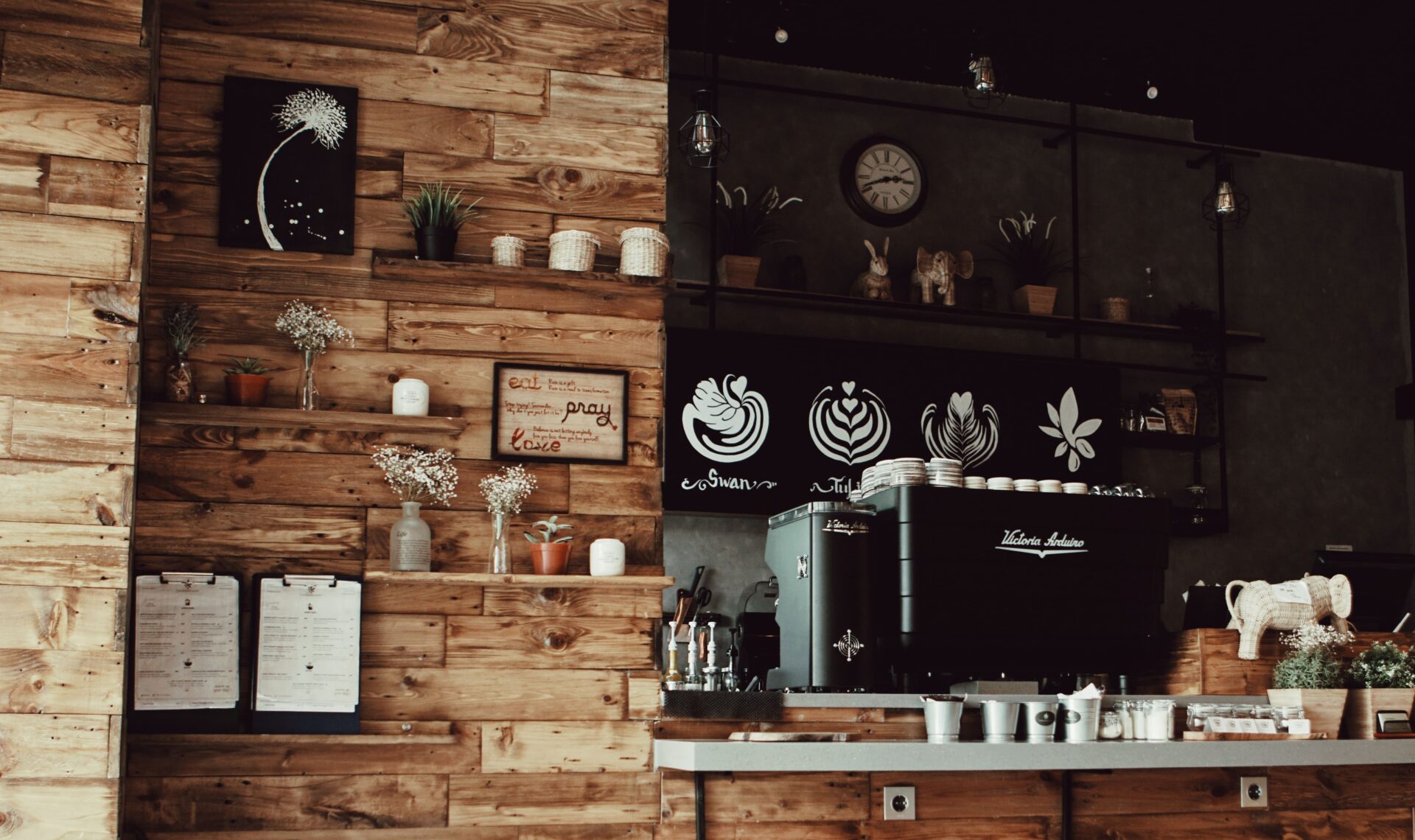
Table of Contents
Dreaming of opening a coffee shop ? You’re not alone. The coffee industry is bustling with passionate business owners eager to make their mark. However, becoming successful coffee shop owners requires more than just a love for the brew. It demands a clear vision that differentiates your coffee house in a saturated market. A well-crafted business plan not only gives life to your idea but also sets your business on a path to thrive. Whether you’re a newbie or a seasoned entrepreneur, this guide, complete with a free template, will help you craft a business plan that markets and propels your coffee venture to success.
What is A Coffee Shop Business Plan?
A coffee shop business plan is a comprehensive document that explains what your business idea is, how you intend to penetrate the coffee market, and the strategies you’ll employ to run your coffee shop successfully. When opening a cafe, many aspiring cafe or coffee shop owners underestimate the value of a structured plan. However, this document does more than just outline the needs to open a coffee shop; it gives a detailed roadmap for your new business, offering clarity on every aspect of its operation.
More than that, presenting a well-structured business plan to potential investors is essential. It not only showcases your commitment but also your understanding of the industry, making it a vital tool for securing funding. While crafting a business plan can seem daunting initially, it’s the foundation that both clarifies your idea and sets your business on the trajectory for growth and success in the competitive world of cafes and coffee shops.
Why A Business Plan Is Important For A Successful Coffee Shop Business?
1. Clear Vision and Objectives
When you set up your coffee shop, having a business plan establishes a clear vision and defines your objectives. It is the backbone that steers every decision you’ll make. Without a clear outline, you may find yourself swaying from one idea to the next. With a detailed business plan, you can present a clear business proposal to stakeholders, ensuring them and yourself of the path you plan to tread.
2. Financial Planning
A comprehensive business plan is imperative for accurate financial planning. It will include information on how much capital is required to start, what your ongoing costs will be, and the revenues you plan to generate. If you’re seeking external funding, investors will want to see how you plan to use their money, and most importantly, how you plan to make a return on that investment. If you plan to sell specialty blends or unique treats, the financial section can also help you plan a strategy for pricing, promotion, and sales forecasts.
3. Operational Efficiency
Operational efficiency is the linchpin that holds all business operations together. A business plan will map out every detail, from supplier agreements to employee schedules. You may want to create special events or loyalty programs for regular customers, and this is where a business plan can help you plan a strategy for success. It becomes the reference point, ensuring that daily tasks align with the broader objectives, guaranteeing that resources, time, and efforts are used optimally.
Step-by-step Guide To Write A Coffee Shop Business Plan
1. Executive Summary
The Executive Summary is like the introduction of a novel – it provides a snapshot of what is to come. Typically, you write the executive summary last, even though it appears first in your business plan. It encapsulates the essence of your coffee shop’s mission, objectives, and financial overview, succinctly explaining what your business concept is about. This section is crucial because many coffee shops fail to engage potential investors right off the bat. Ideally, it should be concise – a page or two.
What should you cover in an Executive Summary?
- Introduce Your Coffee Shop or Cafe: Provide a company overview, giving readers insight into what makes your coffee shop unique from the myriad of coffee bars in the market.
- State Your Mission and Vision: Describe what drives your coffee business and where you see it in the future.
- Outline Your Objective: Define clear, measurable goals that you aim to achieve.
- Provide a Financial Overview: Highlight projected profit margins, a brief balance sheet, and other pertinent financial data.
2. Coffee Shop Business Description
This section paints a picture of your coffee shop. It’s where you elaborate on how you plan to infuse the local coffee market with your unique brews and pastries.
What should you cover in the Coffee Shop Description section?
- Coffee Shop Concept: Dive into the types of coffee drinks you plan to offer, whether it’s a rich espresso or a classic brewed coffee.
- Unique Selling Proposition: Discuss what makes your coffee shop stand out, be it a special blend of coffee beans, a unique roasting method using a specific coffee roaster, or artisanal pastry offerings.
- Operational Plan: Briefly touch upon how you’ll manage your coffee shop, from sourcing beans to serving cups of coffee.
3. Market Analysis
Before pouring your first espresso, performing market research before starting your coffee business is essential. This section dives deep into understanding your potential customer base and the coffee industry landscape in your area.
What should you cover in this section?
- Target Market: Describe your ideal customer. Are they local residents, office workers, or students?
- Location: Discuss the significance of your chosen location. Are there many coffee shops in the area? How does your location cater to your target market?
- Competition: Analyze existing coffee shops. What coffee and food products do they offer? What pricing strategy do they employ? How will your coffee shop compete or complement them?
4. Organization and Management
Behind every successful coffee shop is a robust organizational structure and a competent management team.
What should you cover in the Organization and Management Plan?
- Coffee Shop Ownership Information: Highlight the business’s legal structure.
- Profiles of Your Coffee Shop Management Team: Include details about your baristas, perhaps a part-time accountant, and someone to manage marketing. It can be helpful to create profiles for each role, detailing responsibilities and expertise.
5. Sample Menu
Your menu is the heart of your coffee shop. It’s more than just a list of coffee and tea; it’s an expression of your brand.
What should you consider when creating a Sample Menu?
- Menu Items: Detail the types of coffee, espresso drinks, and pastries you plan to offer. Maybe consider including non-coffee items like teas or specialty drinks.
- Unique Selling Proposition: Reiterate what makes your coffee or food items different from other coffee shops in the area.
- Menu Pricing : Discuss your pricing strategy, keeping in mind profit margin, competitors’ prices, and your target customer base.
6. Marketing Plan
To brew success, it’s not enough to have a fantastic coffee product; you must effectively market it.
What should you cover in a Marketing Strategy for your Coffee Shop Business?
- Define Your Brand: What voice, theme, or emotion do you want your coffee shop to evoke?
- Lay out your plans for social media campaigns, local partnerships, loyalty programs, SEO for website, and other promotional strategies.
- Considering using an online food ordering system in your food truck
- Create a digital menu with QR code to make your menu easy for your customers to access online
7. Operations Plan
Efficiency is key to the daily grind of running a cafe. The operations section provides a detailed look at the day-to-day operations of your coffee shop business.
What Operational Issues should you address in your Business Plan?
- Supply Chain: Where will you buy your coffee beans? Who will be your coffee roaster?
- Operating Hours: Consider the best times to cater to your target market.
- Staffing: Detail roles, such as barista, manager, and part-time support.
- Equipment: List down essential equipment, from espresso machines to ovens.
8. Financial Plan
In this crucial section of your business plan, delving into the financial specifics is paramount to lay out a concrete roadmap for the fiscal aspects of your coffee shop.
How Much Does It Cost to Start a Coffee Shop?
Starting a coffee shop is not just about brewing the perfect espresso; it’s also a substantial financial commitment. The cost for opening a coffee shop can range from $80,000 to $250,000. These costs can vary widely based on factors such as location, size of the establishment, equipment quality, and inventory requirements. Moreover, the process of opening a coffee shop might also involve unexpected expenditures, so it’s essential to account for some buffer in your budget.
How Many Ways to Fund Your Coffee Shop?
There are multiple avenues for funding your coffee venture. Traditional bank loans, personal savings, angel investors, crowdfunding campaigns, and partnerships are just a few options. It’s crucial to assess which option aligns best with your business vision and financial situation.
Important Questions to Consider When You Create Your Funding Request If you’re seeking funding, there are several questions you’ll need to answer in your business plan:
- How much money do you need to start and maintain your coffee shop until it becomes profitable?
- What will the funds be used for specifically?
- How do you plan to handle financial challenges that might arise?
- How do you plan to repay any loans or provide a return on investment?
9. Financial Projections
The financial projections section of your business plan forces you to translate your coffee shop vision into numbers, ensuring you’ve accounted for all key metrics that can make or break your venture.
Break-even analysis:
This is the point where your coffee shop’s total revenues equal its total costs. Simply put, it’s when you neither make a profit nor a loss from selling coffee.
Use this formula: Fixed Costs / (Price – Variable Costs) = Break Even Point
Projected profit and loss statement:
This will provide a forecast of your expected income and expenses, giving a clear view of your venture’s profitability.
Cash flow analysis:
Essential for understanding the liquidity of your business, this tool is especially crucial for coffee shops, considering the fluctuating expenses and incomes coffee shops offer. When drafting this, consider who will read it, as stakeholders like investors or lenders might have specific expectations.
Coffee Shop Business Plan Template
- Mission: To offer the community high-quality coffee in a comfortable and vibrant environment.
- Vision: To become the go-to local coffee spot that fosters community connections and coffee appreciation.
- Coffee Shop Description: “Java Junction” will be a modern coffee hub that emphasizes direct-trade coffee beans and a relaxed, inclusive atmosphere.
- Costs: Estimated initial costs are $125,000.
- Profits: Projected annual profit by year two is $75,000.
2. Description of the Coffee Shop
- Coffee Shop Concept: A community-focused café emphasizing artisanal methods.
- Coffee Shop Name: Java Junction. (Consider using a coffee shop name generator for more ideas).
- Coffee Shop Type: Sit-down café with an adjacent mini-library.
- Location: Main Street, Downtown Area – chosen for its high foot traffic.
- Order Fulfillment: Orders taken at the counter with table service for food.
- Working Hours: Mon-Fri (7 am – 9 pm), Sat-Sun (8 am – 10 pm).
3. Menu Offer
- Type of Food and Drink: Coffee, teas, pastries, and sandwiches.
- Offer: From classic espresso shots to unique blends like “Lavender Latte”.
- Unique Selling Point: Every coffee product uses direct-trade beans, ensuring farmer fairness.
4. Market and Competition Analysis
- Market Analysis: The local population includes a mix of professionals, students, and tourists. Many search for quiet spots to work or relax.
- Target Customer: Professionals aged 25-40 and students.
- Size of the Target Customer: Approximately 15,000 individuals.
- Competition Analysis: Three established coffee shops within a mile.
- Size of the Competition: Ranging from small boutique coffee shops to a larger chain.
- Competitors’ Offer: Basic coffee drinks, with limited specialty items.
- Competitors’ Prices: Average of $4 for a coffee drink.
5. Investment Plan (Detailed Cost Analysis)
Investment Cost (One-off): $75,000
- Equipment: $30,000
- Renovations: $20,000
- Initial Stock: $10,000
- Licenses: $5,000
- Miscellaneous: $10,000
Operating Costs (Monthly): $17,000
- Rent: $3,000
- Salaries: $10,000
- Utilities: $1,000
- Stock: $2,000
- Marketing: $1,000
6. Financial Forecast
Year one is projected to break even, with a profit of $50,000 expected in year two, and $75,000 in year three, considering growth and expanding customer base.
- Owner: Jamie Smith, a coffee enthusiast with a business degree.
- Manager: Alex Brown, previously managed a successful coffee chain for five years.
- Baristas: A team of 4 skilled individuals passionate about coffee.
8. Marketing Plan
Java Junction will use a mix of social media marketing, local print advertising, and loyalty programs to attract and retain customers. Regular events, such as “Buy Our Coffee Day” and collaboration with local businesses, will drive foot traffic and community engagement, integral components for starting your coffee shop and making it successful.
This coffee shop business plan sample is hypothetical and serves as a template. Tailoring specifics to your local market, vision, and unique aspects will be necessary. Every coffee shop has nuances that can make them successful, whether it be the coffee products they sell, the environment they cultivate, or the events they host. Focus on what will make your coffee shop stand out and be sure to engage your community.
Tips For Writing a Business Plan For a Coffee Shop
Your business plan becomes the blueprint of your vision. Here are essential tips to consider:
Comprehensiveness is Key: Ensure your plan encompasses all sections you should include, such as marketing, financial projections, and operations. A well-rounded plan provides a holistic view of your business.
Tailor to Your Audience: If you’re presenting to potential investors, focus on profitability and growth projections. For a landlord, emphasize the benefits your coffee shop will bring to their property.
Specialize in Marketing: Given the competitiveness in the coffee industry, it’s crucial to have a solid marketing plan. If marketing isn’t your strength, consider hiring someone to do marketing for your venture. A strong online presence, loyalty programs, and community engagement can set you apart.
Research Your Market: Understand what nearby coffee shops include in their offerings. Identify gaps in the market and strategize on how your shop can fill them.
Stay Flexible: While a business plan provides direction, remain adaptable. The coffee industry is dynamic, and your ability to pivot can prove invaluable.
Separate Sections for Clarity: If your plan becomes too dense, you might want to create a separate document for specific sections like a detailed marketing strategy or an in-depth market analysis. This makes your primary business plan concise and more readable.
Frequently Asked Questions
1. how profitable is owning a coffee shop.
Owning a coffee shop can be profitable, depending on factors like location, quality of products, and management. On average, after expenses, many coffee shops report a profit margin of around 3% to 5%, with some successful ones achieving even higher. However, it’s essential to factor in initial setup costs, ongoing expenses, and market competition.
2. How do I start a coffee shop business plan?
Starting a coffee shop business plan involves multiple steps. Begin by defining your coffee shop’s mission and vision. Conduct market research to understand your target audience and competitors. Then, detail out sections like your product offerings, pricing strategy, marketing plan, financial projections, and operational procedures. If you’re thinking of opening a coffee shop, a well-thought-out business plan is indispensable.
3. What is a business plan for a coffee shop?
A coffee shop business plan is a detailed document that outlines your coffee shop’s objectives, strategies, and operational procedures. It acts as a roadmap, guiding you from the startup phase to establishing a thriving business. Moreover, if you need a coffee shop business loan or investment, this plan becomes crucial in convincing stakeholders of your venture’s viability.
4. What are the 4Ps in a coffee shop business plan?
The 4Ps stand for Product, Price, Place, and Promotion. In the context of a coffee shop:
- Product: What type of coffee and related products will you offer?
- Price: How will you price your coffee? Will it be premium or competitive?
- Place: Where will your coffee shop be located? Is it accessible to your target audience?
- Promotion: How will you market your coffee shop? Will you offer promotions or loyalty programs?
These elements help in creating a marketing strategy tailored to your coffee shop’s unique needs and market position.
Launching a coffee shop is not just about brewing the perfect cup but weaving a narrative that resonates with your community, fostering an ambiance that people gravitate towards, and maintaining a seamless operation that drives profitability. The meticulous creation of a business plan is a pivotal step in this endeavor. It’s the beacon that guides budding entrepreneurs through the complexities of the coffee industry. In such a competitive marketplace, a well-structured, comprehensive business plan can make the difference between a fleeting venture and a thriving institution. To potential coffee shop owners, embrace the process, let your passion shine through in your plan, and remember that every great coffee shop started with a simple idea, much like a single coffee bean ready to brew greatness.

Related articles

QR Code on Table Tents for Restaurants and Bars

How much does it cost to open a small restaurant

How much does it cost to open a bakery

Menubly LLC 8 The Green Suite R, Dover, Delaware 19901
Privacy Policy
Terms of service
Cookie Policy
Profit Margin Calculator
Food Cost Calculator
- Business plans
Coffee Shop Business Plan Template
Used 7,548 times
Looking for investors and permits for your new cafe? Use this free Coffee Shop Business Plan Template to get all your cups in a row.
e-Sign with PandaDoc
Coffee Shop Business Plan
Executive summary.
In order to fulfill our vision for [COFFEE SHOP] we will require [DOLLAR AMOUNT] in capital, which will be allocated roughly according to the following table:
| Amount | Use of Capital |
|---|---|
If we are fully capitalized, we hope to be profitable by [TIME PERIOD] .
Marketing plan
Our Clientele
Our Competition
Our Specific Marketing Plan
Product description.
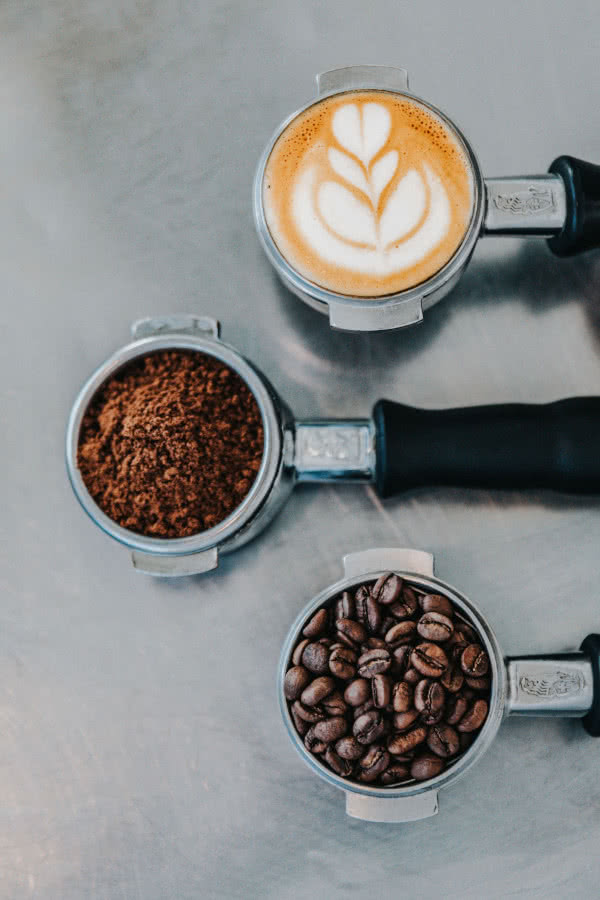
Operations plan
Our Suppliers
Our Personnel
Expense Projection
We expect our monthly outlay of expenses to approximate to the following:
| Amount | Type of Expense |
|---|---|
Care to rate this template?
Your rating will help others.
Thanks for your rate!
Useful resources
- Featured templates
- Sales proposals
- NDA agreements
- Operating agreements
- Service agreements
- Sales documents
- Marketing proposals
- Rental and lease agreement
- Quote templates

- Customer Reviews
- Net 30 Account
- Wise Services
- Steps & Timeline
- Work at a Glance
- Market Research at a Glance
- Business Plan Writing Services
- Bank Business Plan
- Investor Business Plan
- Franchise Business Plan
- Cannabis Business Plan
- Strategic Business Plan
- Corporate Business Plan
- Merge and Acquisition Business Plan (M&A)
- Private Placement Memorandums (PPM)
- Sample Business Plans
- Professional Feasibility Study
- PowerPoint Presentations
- Pitch Deck Presentation Services
- Business Plan Printing
- Market Research
- L-1 Business Plan
- E-2 Business Plan
- EB-5 Business Plan
- EB-5 Regional Centers
- Immigration Attorneys
- Nonprofit Business Plan
- Exit Business Planning
- Business Planning
- Business Formation
- Business License
- Business Website
- Business Branding
- Business Bank Account
- Digital Marketing
- Business Funding Resources
- Small Business Loans
- Venture Capital
- Net 30 Apply

Coffee Shop Business Plan Sample
- Fill the Form to Download Coffee Shop Business Plan Example
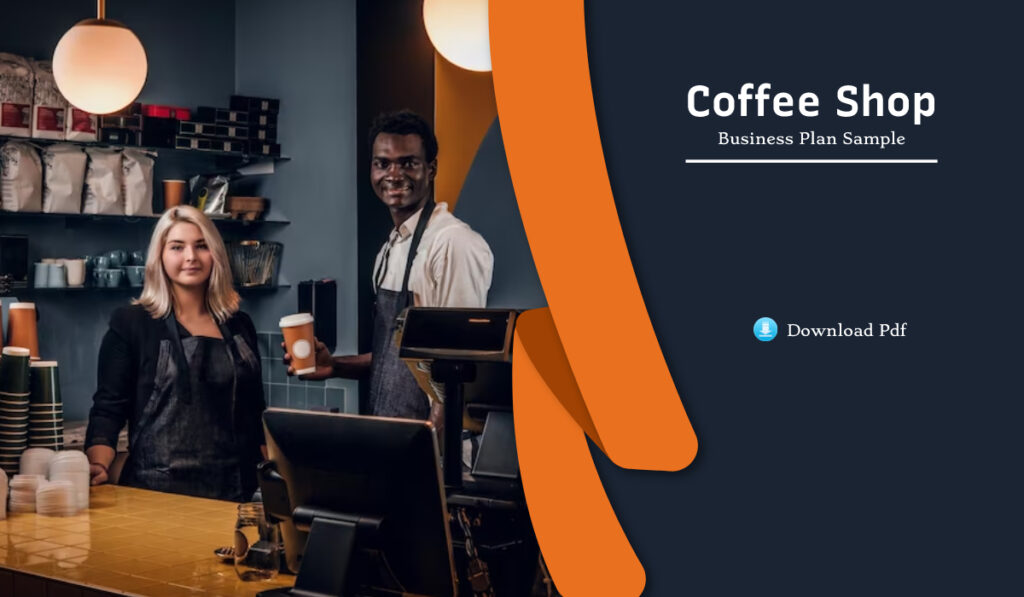
The coffee shop business plan is an essential tool for coffee shop owners and those who want to open a coffee shop.
A coffee shop business plan will give you an idea of how much a coffee shop will cost, how those costs will be funded, and how much money you expect to make from it.
When it’s ready, you can show it to investors, banks, partners, and anyone else who can help you open a cafe. Getting this document right is worth your time and effort, so make sure you do it right.
After helping entrepreneurs in the USA launch more than 400 independent coffee shops , we know that a business plan is vital for success.
We are here to help you write a coffee shop business plan.
Here’s a business plan sample pdf and a template that will give you some inspiration for what should be included in your coffee shop business plan.
Coffee Shop Business Plan Template
1. Business Plan Title Page
2. executive summary, 3. market overview, 4. competitive analysis, 5. swot analysis, 6. marketing plan, 7. funding request, 8. management summary, 9. financial highlights, coffee shop business plan sample. faqs:, coffee shop business plan powerpoint presentation, download coffee shop business plan example pdf.
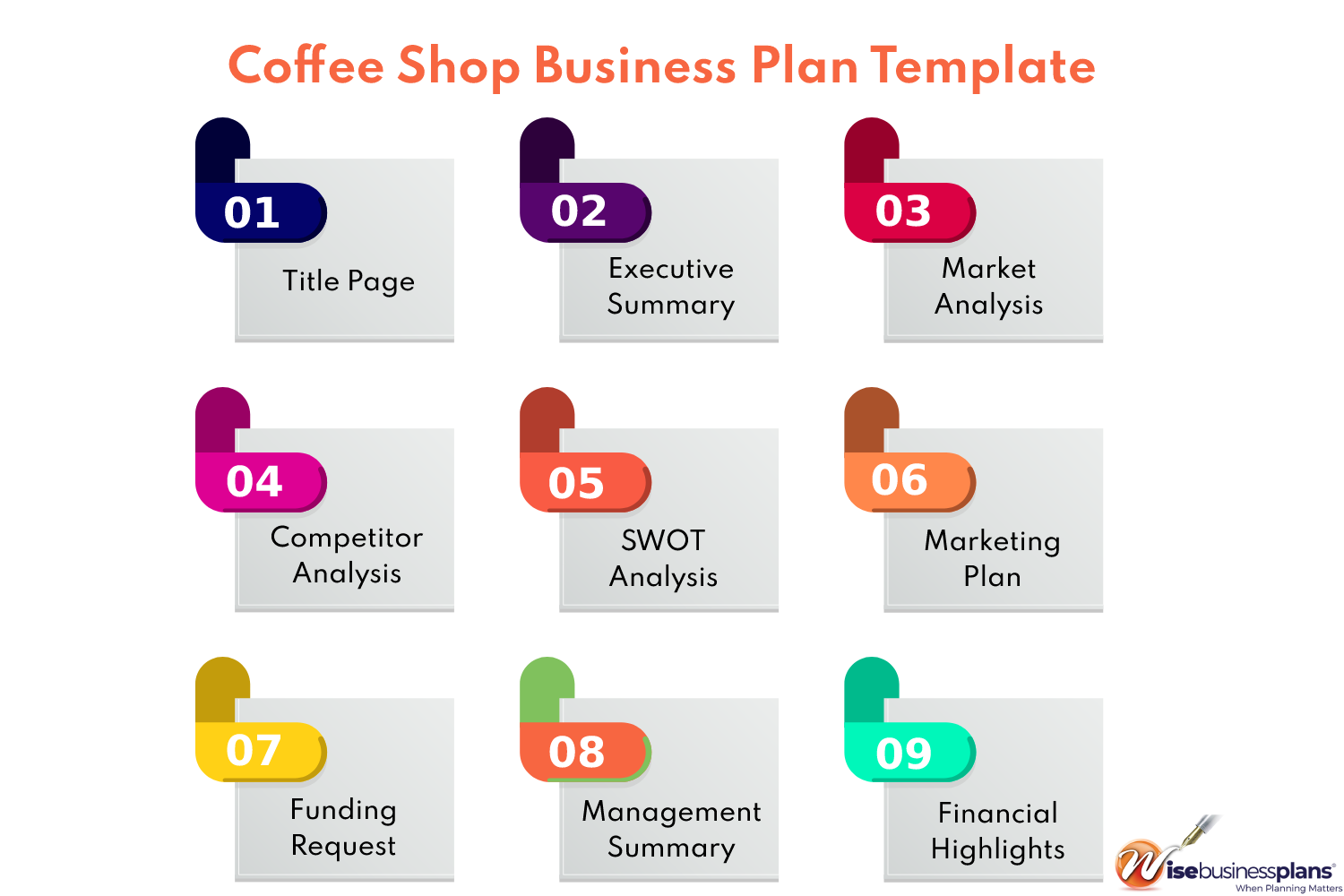
A coffee shop business plan template should include the following sections. Let’s look at a coffee shop business plan template and discuss what each section should include.
1. Business Plan Title Page 2. Executive Summary 3. Market Overview 4. Competitive Analysis 5. Swot Analysis 6. Marketing Plan 7. Funding Request 8. Management Summary 9. Financial Highlights
Start with the legal name of your business. Provide the address of a likely location or website if you already have one. Include your company logo at the top or bottom of the title page. On the title page, there should also be a table of contents listing each section and its page number.
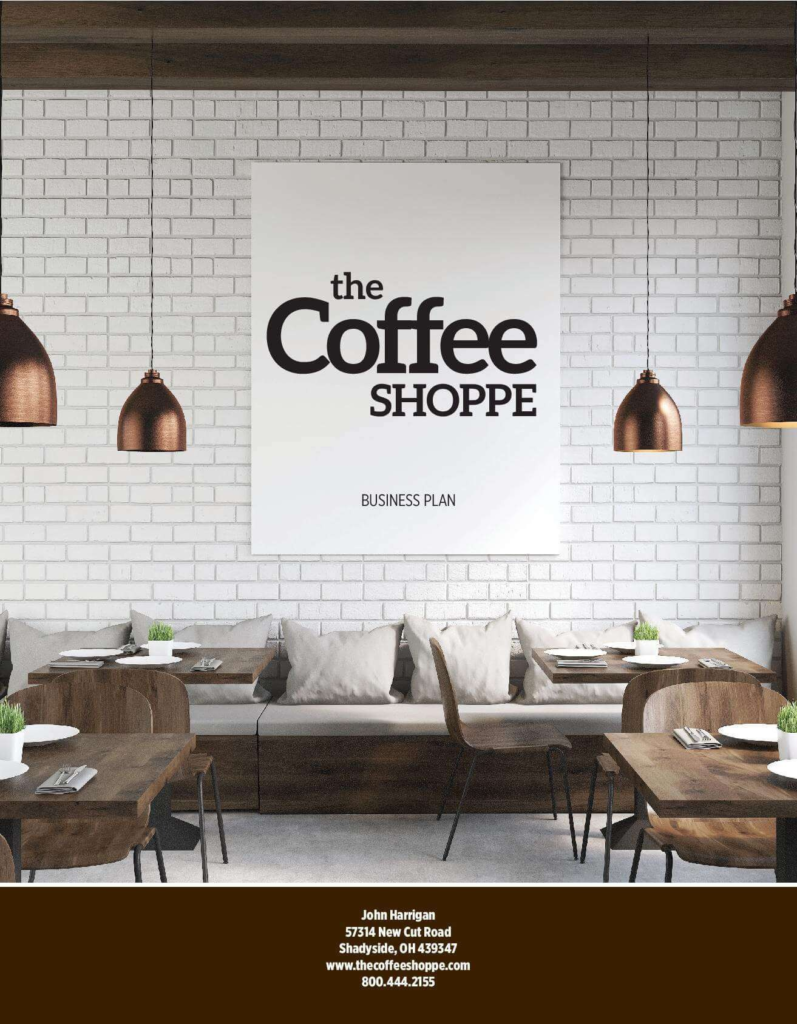
What makes a great cover page for a business plan?
Visit our page on business plan cover page examples to download our free business plan cover page templates and create a beautiful cover page yourself.
The Coffee Shoppe will be a business service provider based in Miami, Florida. Founded by Mrs. Nancy Harrigan. The Coffee Shoppe will offer a menu of services which include coffee, lattes, capacinos, expressos, deli sandwiches and baked goods.
While these services will comprise the initial market entry core, long-term plans call for the integration of storage and relocation capabilities to the business mix.
The local area has been in dire need of a service of this type for some time and The Coffee Shoppe plans to adequately serve them through the consistent delivery of real-time hospitality.
The market is definitely filled with opportunities but in order to capitalize on them, a strong infusion of working capital must be acquiesced.
The founder projects needing 100K for their business venture with repayment being made out of the profits that are driven annually. Funding that is secured will be used in a variety of areas including marketing, logistics, management, site procurement as well as the day to day operations of the organization.
The marketing for The Coffee Shoppe will be done through a variety of mediums including the Internet, mass media, print and networking. Internet efforts will center on the creation of a user-friendly website that clearly list all of the core services that will be offered.
To read the full executive summary, click here to download the PDF
Read more: Executive summary examples
Financial Highlights
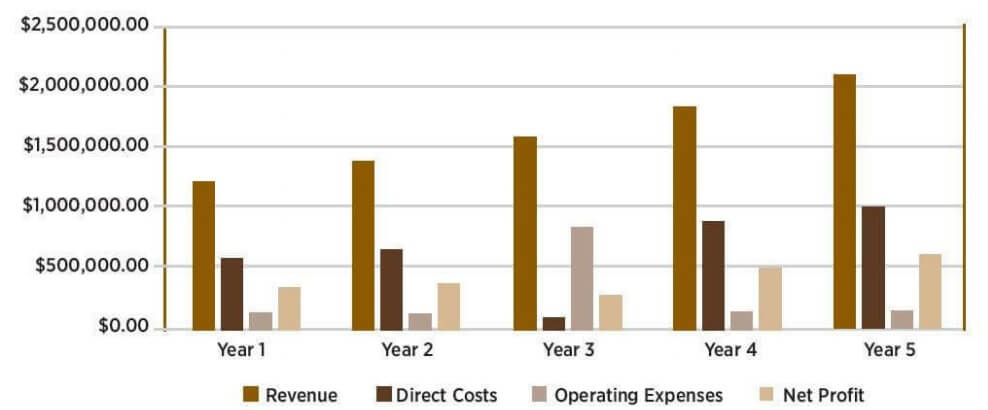
The Company is entering the market at a time when the industry in which it operates is experiencing substantial growth. According to market research firm IBIS World, the Coffee & Snack Shops Industry has seen an average annual growth rate of 5.8% over the last five years, positioning industry revenue to be around $47.7 billion in
2018. The Coffee & Snack Shops industry is projected to see an average annual growth rate of 1.4% over the next five years, placing industry revenue at $51 billion in 2022.
Market Analysis
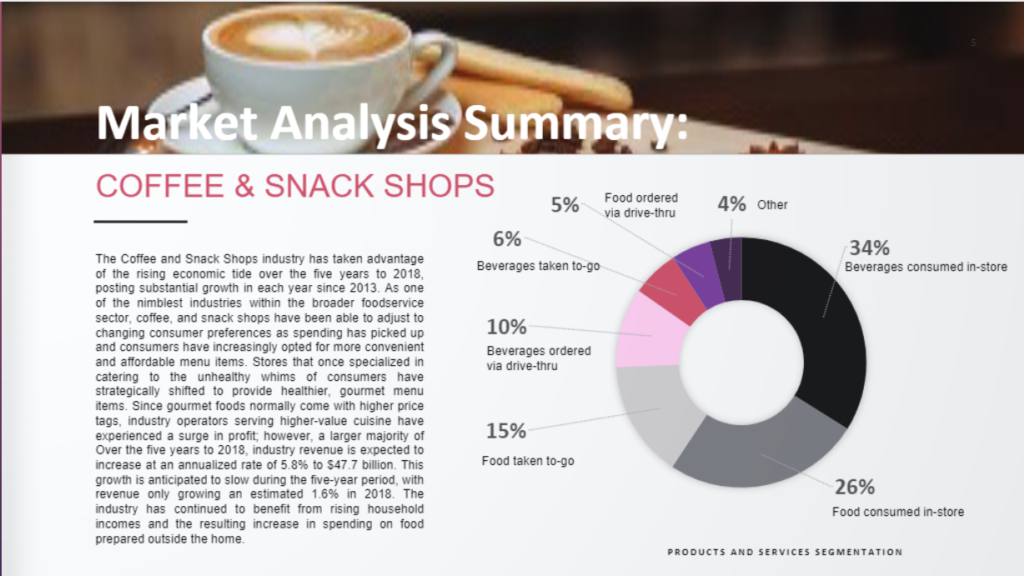
Target Market
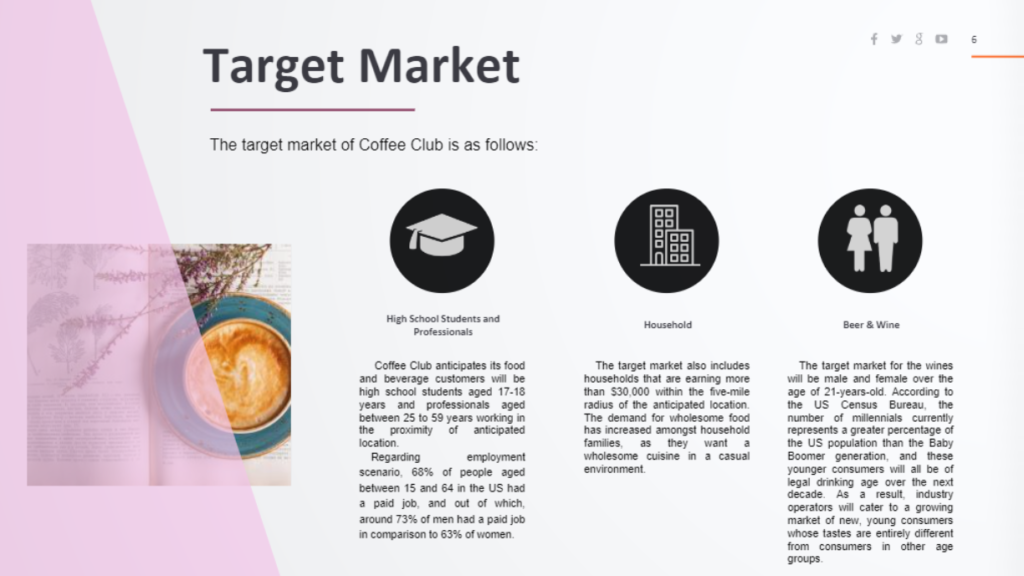
The following is a listing of the primary competitive advantages of the Companv upon entering the market
- Congenial customer service
- A central location wit greater foot traffic Parking facility available for customers
- Soothing ambiance for calm eating
- Excellent visibility from the road
- Aggressive marketing campaian
- Understanding visitors food choices and integrating the same in the menu
- Inviting feedback from customers
- Key understanding of trends and flavor
- The company will hire experienced management and staff
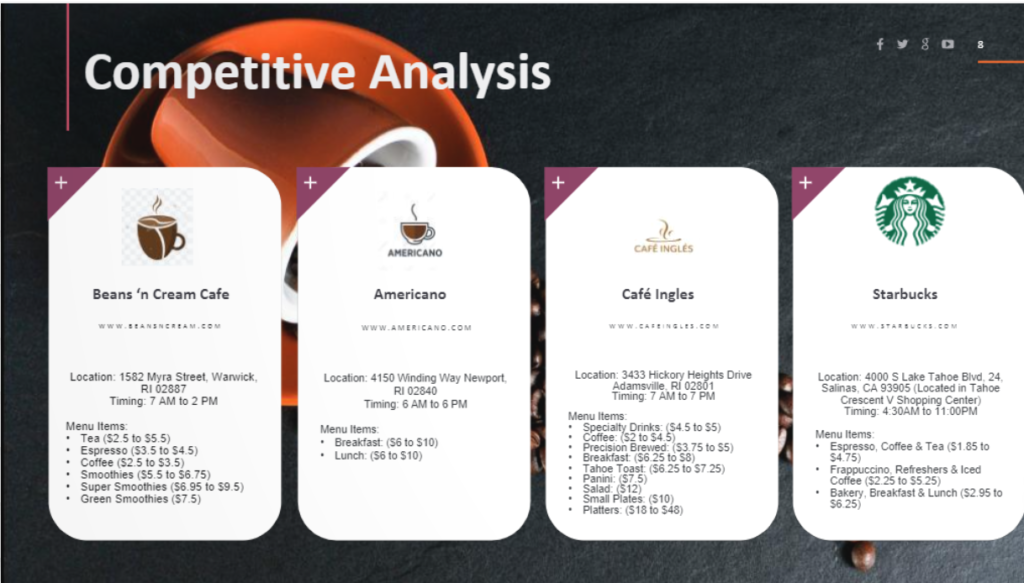
The following is an analysis of the SWOT analysis of the coffee shop business as well as the opportunities and threats present in the market.
- Location. The location is one of the primary strengths of the The Coffee Shoppe business model as there are currently no other organizations that have the capabilities to offer the types of services that will be introduced to the market.
- The founder. Founder Nancy Harrigan is a seasoned, strategic business professional with an eye towards success, profit and achievement. These qualities will form the basis of the The Coffee Shoppe brand and be a catalyst that propels the success of the operation.
- Servicing of a need. The services that will be brought to the local residents of Miami are one that is truly needed. The fact that The Coffee Shoppe will be satisfying this need will endear the organization to the customer base and allow for consistently strong growth.
- Lack of funding. Funding is the sole weakness of the The Coffee Shoppe business venture. While funding is a weakness it should be noted that the founder is confident that if adequate funding is secured, she will be able to develop a viable business.
Opportunities
- Limited competition. The limited amount of local competition is the primary opportunity for The Coffee Shoppe as it will give the organization the opportunity to develop a loyal customer base while erecting barriers to entry.
- Small business growth. The projected growth of small businesses will provide another opportunity and will feed opportunities directly into the The Coffee Shoppe pipeline.
- Larger organizations. Larger organizations could possibly realize the opportunities that can be found in the local region and begin entering the market. While this is a threat, the founder believes that with strategic marketing, community efforts and customer service, this threat can for the most part be mitigated.
Free: Business Plan Examples
Do you need help creating a business plan? Check out these six free, proven business plan examples from different industries to help you write your own.
Marketing for The Coffee Shoppe will be done through a variety of mediums with television, print and the Internet being the primary drivers. The website will have SEO capabilities and will be developed using all of the latest in web and graphics technologies.
In addition to the home website, plans also call for the creation of a strong social media presence using Facebook.com and Twitter.com with regular updates occurring on each of the aforementioned pages.
Commercial time has already been purchased through ABC and commercial production will begin immediately following funding acquisition. Print marketing will consist of advertisements being placed in publications that are typically read by members of the targeted audience including small business owners and corporate types.
Networking will round out the The Coffee Shoppe marketing mix with the founder joining various networking groups that give her the ability to champion the brand that she has created.
Read more: how to do market research research
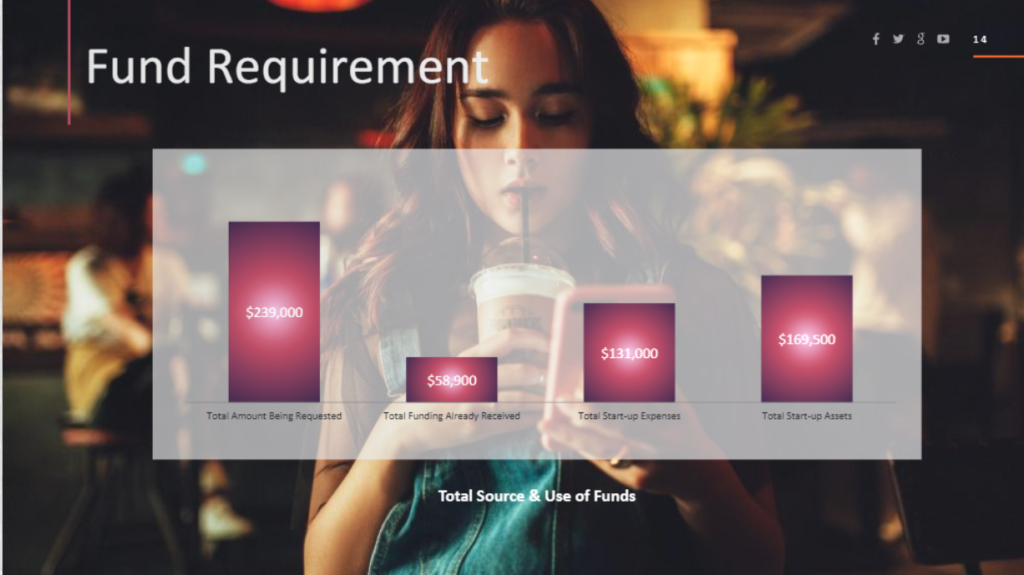
Read more: ways to find investors for your business
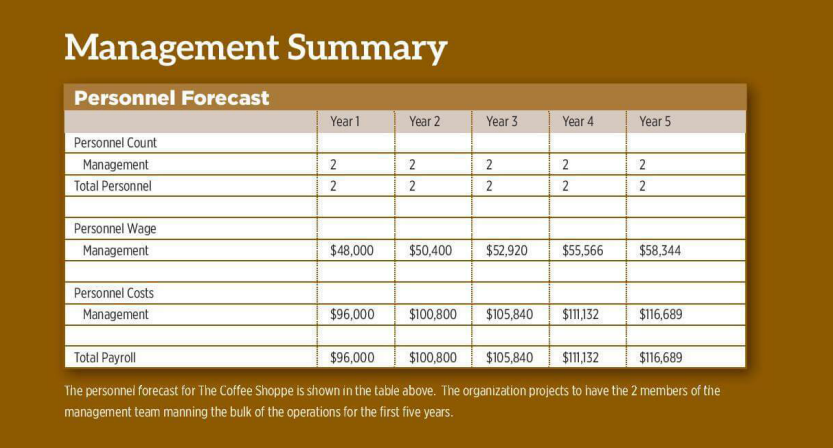
Financial Indicators
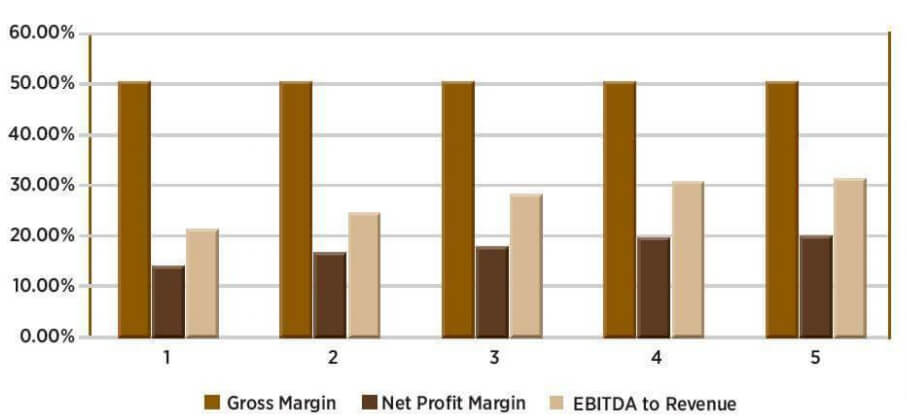
To learn more about financial indicators, click here to download the pdf
Break even analysis
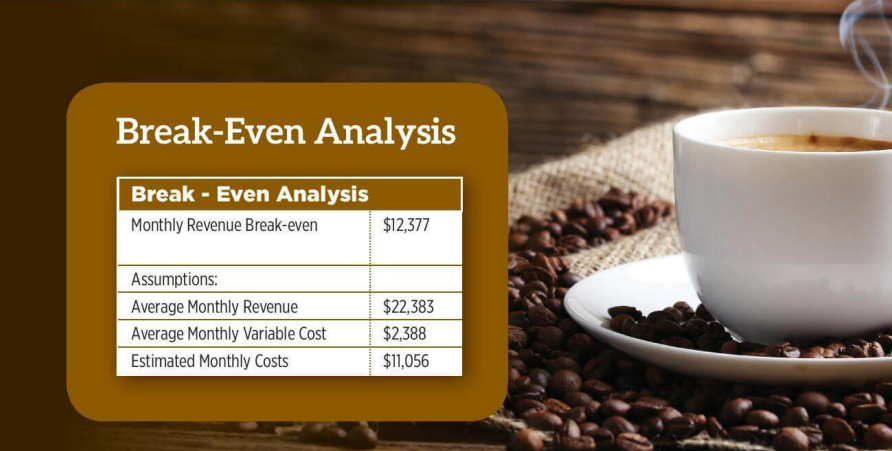
Profit and Loss Statement

Projected Cash Flow
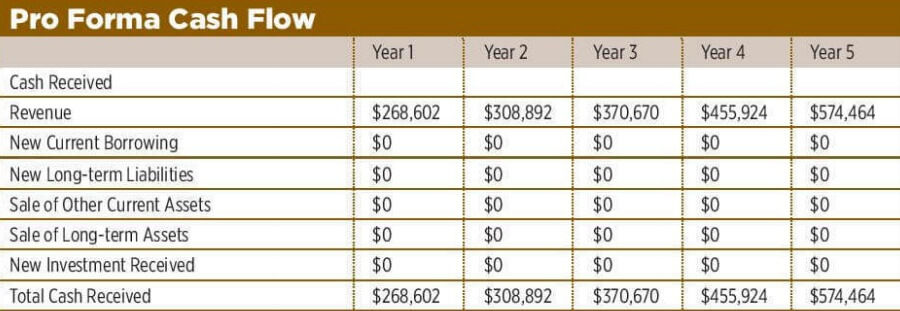
Projected Balance Sheet

Starting a coffee shop can vary greatly depending on location, size, and concept. On average, the initial investment can range from $80,000 to $300,000. This includes lease deposits, equipment purchases, inventory, permits, and marketing expenses.
The specific permits and licenses needed will vary based on your location and local regulations. Common requirements include health department approvals, business permits, food service licenses, and zoning permits. It’s crucial to research and comply with all necessary legal requirements.
A successful marketing strategy is essential for attracting customers. Utilize social media platforms, collaborate with influencers, and host events to create buzz around your coffee shop. Offering unique beverages, outstanding customer service, and a welcoming ambiance will keep customers coming back.
While it’s not mandatory, offering organic or fair trade coffee can attract environmentally conscious consumers. It also reflects your commitment to sustainable and ethical practices, which can build a loyal customer base.
Track key performance indicators (KPIs) such as sales revenue, customer retention rates, average ticket size, and social media engagement. Analyzing these metrics will help you gauge the success of your coffee shop and identify areas for improvement.
Implementing a loyalty program, offering personalized perks, and providing excellent customer service are effective ways to retain customers. Engage with your audience on social media, respond to feedback, and continuously improve your offerings based on customer preferences.
Our free real sample business plans will show you how to write a plan that looks as polished and professional as this one.
Click to view the coffee shop business plan sample. Our experienced business plan writers professionally write each business plan and work with you to develop a winning plan.
We will show you some real-world business plan examples so you may know how to write your own, especially if you are seeking a bank loan or an outside investment and need to use SBA-approved formatting.
Quick Links

- Investor Business Plans
- M&A Business Plan
- Private Placement
- Feasibility Study
- Hire a Business Plan Writer
- Business Valuation Calculator
- Business Plan Examples
- Real Estate Business Plan
- Business Plan Template
- Business Plan Pricing Guide
- Business Plan Makeover
- SBA Loans, Bank Funding & Business Credit
- Finding & Qualifying for Business Grants
- Leadership for the New Manager
- Content Marketing for Beginners
- All About Crowdfunding
- EB-5 Regional Centers, A Step-By-Step Guide
- Logo Designer
- Landing Page
- PPC Advertising

- Business Entity
- Business Licensing
- Virtual Assistant
- Business Phone
- Business Address
- E-1 Visa Business Plan
- EB1-A Visa Business Plan
- EB1-C Visa Business Plan
- EB2-NIW Business Plan
- H1B Visa Business Plan
- O1 Visa Business Plan
- Business Brokers
- Merger & Acquisition Advisors
- Franchisors
Proud Sponsor of
- 1-800-496-1056

- (613) 800-0227

- +44 (1549) 409190

- +61 (2) 72510077

- Sample Business Plans
- Food, Beverage & Restaurant
How to Write a Coffee Shop Business Plan + Free Template

You are a smart entrepreneur. You don’t jump right in and open a coffee shop just because you decoded the secret of making perfect cups of steaming delicious coffee.
Instead, you wait and plan to write a unique business plan that resonates with your coffee shop’s concept.
But hey, writing a business plan is actually complex. Without any structural format or direction, you may end up making a hotchpotch of your business idea.
To ensure that your business concept translates properly into a plan, we created this step-by-step guide that will prompt you to write an insightful coffee shop business plan in great detail.
Also, get a free coffee shop business plan template that has all the relevant examples for you to get started.
So get yourself a cup of coffee and decode the secrets of writing a stellar plan in easy steps.
Let’s get started.
Key Takeaways
- Craft a compelling executive summary for your coffee shop business plan. Add key details regarding financials, marketing, business objectives, and operations to help investors evaluate your business idea.
- Conduct thorough research on the coffee shop market by analyzing the key trends, consumer preferences, and needs of your target market.
- Streamline your coffee shop operations with a detailed plan outlining the standard operating procedures of your key business processes.
- Ensure the compliance of business by acquiring essential licenses and permits.
- Design a brief sales and marketing plan to ensure that the coffee business reaches its target customer and starts making sales.
- Identify your unique selling proposition and determine your competitive edge in the market.
- Using SWOT analysis, analyze the strengths, weaknesses, opportunities, and threats of your competitors and your own business.
- Create a sample menu and determine your menu offerings by considering varying different aspects.
Why Prepare a Coffee Shop Business Plan?
A lot of variables play together to write the success story of your coffee business.
From choosing a shop location to remodeling it as per your unique concept, hiring staff, determining sales strategy, acquiring licenses and insurance, and planning operations-you need to undertake multiple activities, consecutively at a time, to start and run a coffee business.
A business plan will guide you like a map in the right direction. It will ensure that all the business objectives are achieved without breaking a compliance code.
It forces you to assess the viability of a coffee shop idea before you invest the money in it. You can strategically plan the coffee shop’s success by making detailed financial projections relating to the company’s sales, revenue, costs, and expected expenses, and cash flow.
And most important of all, a business plan will help you acquire the required funds by winning the trust of potential investors.
How to Write a Coffee Shop Business Plan: A Complete Guide
Let’s walk through the process of writing a coffee shop business plan with detailed step-by-step instructions.
1. Get a business plan template
Writing a business plan from scratch is pretty exhausting. You are likely to leave behind an important detail without any structural format.
So do yourself a favor and get a business plan template. Trust us, it’s going to make your plan writing process so much simpler.
A template helps bring clarity and focus to different sections of the plan by prompting you in specific directions. Moreover, the templates contain examples and tips specific to coffee shops making it extremely relevant for your business.
Looking for a well-structured and modern business plan template?
Well, we knew you would. Presenting the Upmetrics business plan template that can be easily customized for your unique coffee shop business. Simply download our template and modify it as per your business concept.

Need Assistance Writing a Coffee Business Plan?
Get Upmetrics’ business plan template, import data directly into the editor, and start editing using Upmetrics AI Assistant.

Start Planning Now
2. Write an executive summary
An executive summary is like a north star of your business plan. It will act as a guiding light for stakeholders to understand your journey ahead.
Investors will read the executive summary of your coffee shop business plan before even allowing you a presentation. So definitely it needs to be compelling and converting.
Keep your executive summary concise but detailed enough that it summarizes the key points of your entire plan. Include the problems you would be solving and the solutions you have to offer. Adapt a storytelling tone and focus on highlighting the business goals, financials, objectives, and overall business strategy.
Now, move ahead and visit this part when you are done writing for the entire plan. Summarizing becomes much easier and more effective when you are aware of the entire plan’s details.
Also, two pages are more than enough for writing a capturing executive summary.
3. Conduct a competitive and market analysis
Build a strong foundation for your coffee business by diving deep into the market research of the coffee industry, competitors, target audience, market trends, and your attainable target market.
Analyze the coffee shop industry from a macro viewpoint and then gradually narrow it down to your particular market. For instance, the revenue in the US coffee market size was $85.2 billion in 2022 and is expected to grow by 3.21% between 2023-2028.
Now, identify your targeted available market (TAM) from this and analyze the growth potential of your particular coffee shop. Overall, try to show that the coffee shop business has a thriving opportunity to grow in the market.
The market analysis for a coffee shop business must include the study of the following:
Customer analysis
Customer analysis is essential to identify your target customers. Having a thorough understanding of your target market will help formulate the business and market strategies appropriate for your business.
Create the buyer persona of your ideal customer. Focus on these details to outline your ideal customer:
- Customer demographics: Age, gender, location, income, occupation, and ethnicity of the customers who will visit your coffee shop.
- Customer psychographics: Beliefs and values of your ideal customer, their interests, spending pattern, and their media consumption.
For instance, the ideal customer for Steamy Sips is 23-38 years old and works in a corporation. He/ She likes to spend money on coffee regularly and prefers fresh roasted seasonal brews, is socializing, and loves working in a cafe remotely.
Competitors analysis
After determining your target market, look around and identify your potential competitors.
Begin by identifying the top competitors of your coffee shop. This can be neighboring coffee shops, kiosks, or coffee karts that offer similar services to your business.
Now conduct a SWOT analysis of these coffee shops by analyzing their strengths and weaknesses. Also, analyze your strengths against competitors and highlight your competitive edge in the market. Be realistic with your assessment as this will form the foundation of your related business policies.
Lastly, identify if there are any stellar opportunities for you to leverage in this market.
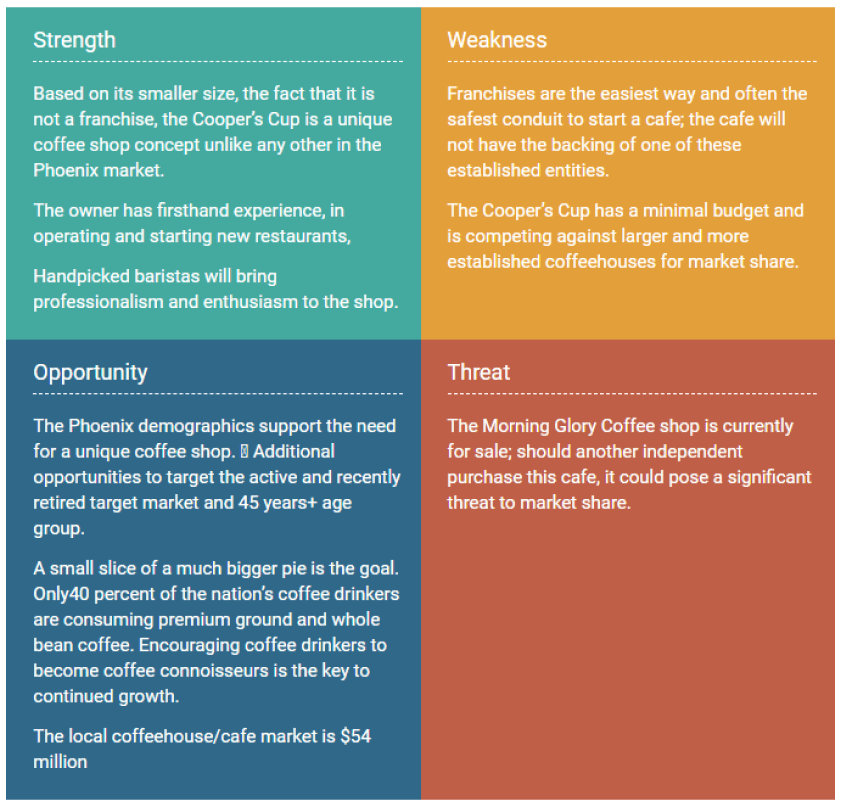
Collect data from highly authoritative websites, data publications, and local studies specialized in the coffee industry. For instance, SBA , SCA coffee , Mintel , Business Wire , COFFEEBI , etc.
This section is your chance to prove to the potential investors that you are aware of the market challenges and there exist favorable chances for your coffee shop to thrive and grow.
4. Prepare a company overview
Just like the executive summary of your coffee shop business plan, this section includes a brief business description of your coffee shop. It offers readers a peek into your business structure, goals, mission, and company values.
Depending on your market analyses choose the type and structure of your business concept. Clearly describe whether you will start a cafe or coffee shop, coffee kart, coffee bar, or coffee house and whether the business structure will be LLC, partnership, or sole proprietorship.
Further include your mission statement, coffee shop objectives, and goals to complete the company overview section.
Mission statement: A mission statement highlights the purpose of your coffee shop’s existence and its long-term objective.
For instance, Steaming Sips’ mission is to cultivate a culture of freshly roasted coffee, serving a welcoming space for young individuals to connect, create, and unwind with every cup of our brews.
Coffee shop objectives: In this part, highlight your business objectives in terms of milestones, growth goals, revenue goals, sales numbers, etc.
For instance, Steaming Sips aims to open 3 branches across San Fransisco by the end of 2025.
5. Present your sample menu
The market research earlier helped you understand your potential audience in great detail. Now, it’s time to decide what to offer on your menu.
A sample menu is an important component of your coffee shop business plan. With a menu, investors will know what exactly you will be serving and what makes you different.
A coffee shop can stand apart selling just coffee drinks. However, there are many coffee shops that sell coffee and food products together. Depending on your coffee shop concept and the target market, decide the menu items.
Here are a few things to consider while making your menu and establishing yourself as a specialty coffee shop.
- Different types of coffee drinks that suit your customer’s taste. For ex. filtered coffee, frappuccino, brewed coffee, hot coffee, etc.
- The type of coffee beans to produce high-quality coffee, e.g. organic coffee beans.
- Different types of coffee roasts, e.g. dark roast, medium roast, light roast.
- Different types of milk, e.g. plant-based milk options and dairy milk.
- Seasonal coffee specialties.
Strategically place the items in your menu and add the prices alongside. Incorporate branding elements of your coffee shop in the menu as well.
6. Coffee shop design and layout
Till now, the coffee shop idea was just a business concept, jumbled randomly across your mind. Writing a business plan will help you to sort those ideas, one section at a time.
The design and layout section helps potential investors visualize the appearance of your coffee shop. It is your chance to help them understand your coffee shop concept and the aspects that set you apart from other coffee shops.
Begin by highlighting your coffee shop location in this section. Briefly explain how the location is suitable for your potential customers.
Also, present the moodboard of your coffee shop and highlight the branding and visual elements of its design.
Overall, explain how you will create a welcoming atmosphere for your customers by incorporating design and decor elements in your shop.
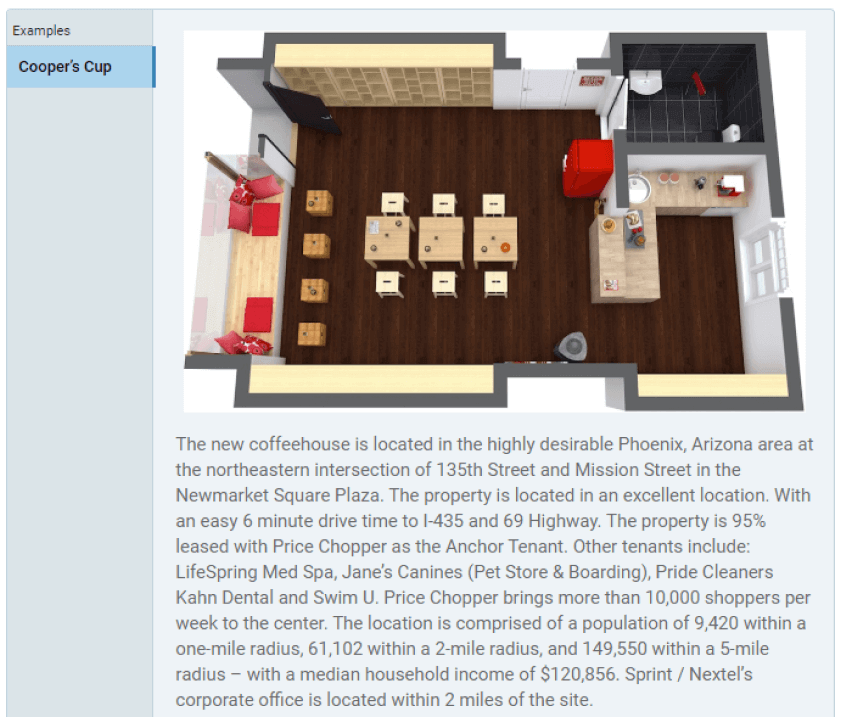
7. Prepare a coffee shop marketing plan
Now that you have the concept, design, and menu for a coffee shop, it’s time to work on its marketing plan. The coffee market is intensely competitive and only a solid marketing action plan can differentiate your business from other coffee shops.
Using your market research, identify the best marketing strategy for your business. Ideally, coffee shops build a cohesive brand image using a mix of digital marketing practices.
For instance, a website can be used to build a robust web image, while social media can be used to connect with your target audience organically. Similarly, your coffee shop emails can focus on special offers and promotional invites while paid ads can help you target the wider audience.
In this section, you also highlight various promotional activities for your cafe such as karaoke evenings, art workshops, musical nights, happy coffee hours, etc.
Overall a comprehensive marketing plan must answer the following questions:
- How will you draw coffee enthusiasts to your coffee shop?
- What will be the pricing strategy of your coffee shop?
- What will be your marketing budget?
- What marketing channels will you use and who will undertake the marketing activities?
- Will there be any promotional events at the cafe? If so, what type of events?
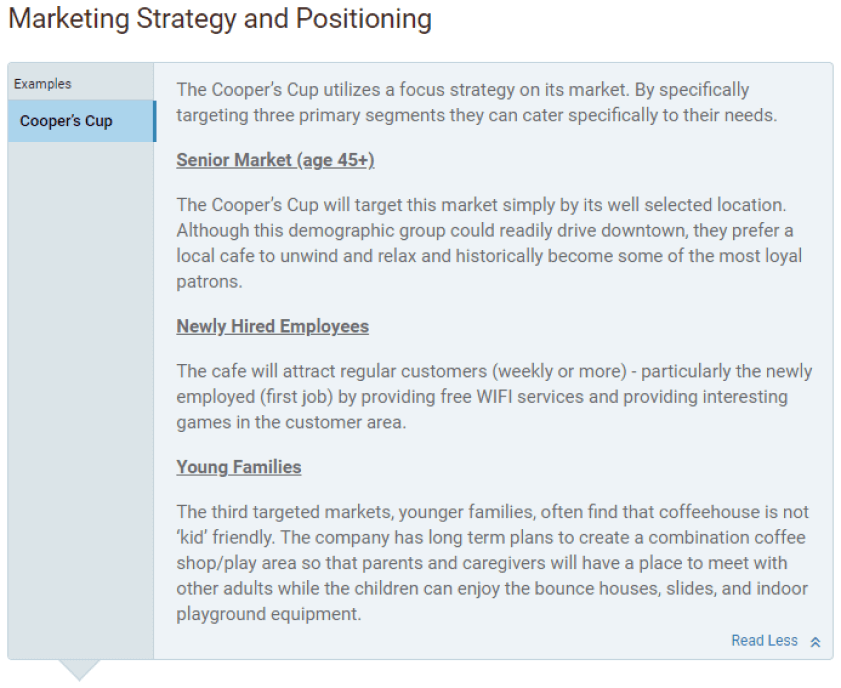
8. Introduce your management team
In this section, you will introduce the management team that will ensure the smooth functioning of your coffee shop business.
Begin by introducing the coffee shop owners and their relevant experience in the coffee market. Also, clarify if you will work both as owner and manager or hire a coffee shop manager to look after the day-to-day operations.
If you are going to hire a manager, introduce them and their key responsibilities in the section. Offer a brief description of their skills, experience, and expertise that can help your coffee shop business.
Overall, this section shows the potential investors that you have all the right people in a team to drive your coffee shop toward success.
9. Outline your operational plan
This section of a coffee plan offers brief details of everyday business processes that will guide you to build and run a successful coffee shop.
An operations plan includes a lot of details, answering some of these prominent questions.
- Inventory and stock management: How will you manage and track the inventory? Who will be responsible for stock management? How often would you restock the inventory?
- Production: Who will develop the recipes for coffee beverages? Will there be recipe cost cards for coffee preparation? Will there be kitchen staff working with food orders or will you outsource that?
- Coffee shop equipment: What equipment will you buy for the coffee shop, i.e. espresso machine, coffee grinders, etc? Will that be a new purchase or a second-hand one? How much will the equipment cost?
- Management: Who will serve the food and coffee in the shop? Who will look after customer complaints? What is the conflict resolution system at your coffee shop?
- Technology: What technologies will you use at your coffee shop? Which payment and POS system will you use? Will there be an ordering kiosk?
A well-planned operations plan demonstrates your ability to run a coffee shop to your readers. So keep it detailed and revamp it as and when needed.
10. Create a Financial Plan
A financial plan helps assess the viability of your business idea by evaluating its financial aspects. It’s an important part of your coffee shop business plan whether you want to seek funding or not.
A well-built financial plan is presented in numbers, graphs, and charts and includes the following:
- Evaluation of startup costs: Identify the startup costs of your proposed coffee shop. Take into account the costs for lease rental, licenses, equipment, remodeling as well as operating expenses for the first few months.
- Sales forecasts and pricing: Determine the drink sales for your coffee shop and your pricing structure by conducting market research.
- Operating costs: Your financial projections should include a thorough calculation of operating expenses to run a coffee shop business.
- Balance sheet: A balance sheet will help investors assess your assets and liabilities and the liquidity of your business.
- Cash flow statement: Make cash flow projections and demonstrate the inward and outward flow of money in the business.
- Income statement: The figures in this sheet help evaluate the profitability of your business
- Break-even analysis: The calculations here will help determine the sales level after which your coffee shop will start making a profit.
Now, making all these financial projections and calculations is a bit taxing. Not only that, you will have to create visual reports to make the financial section appealing and insightful.
Well, let’s make things easier with our financial forecasting tool. Simply enter your assumptions in a tab and our tool will generate important key reports for your business.
Don’t stress. You don’t need to worry about the visual reports anymore. Go, check your dashboard. You will have all the visual reports ready to be added to your financial plan.
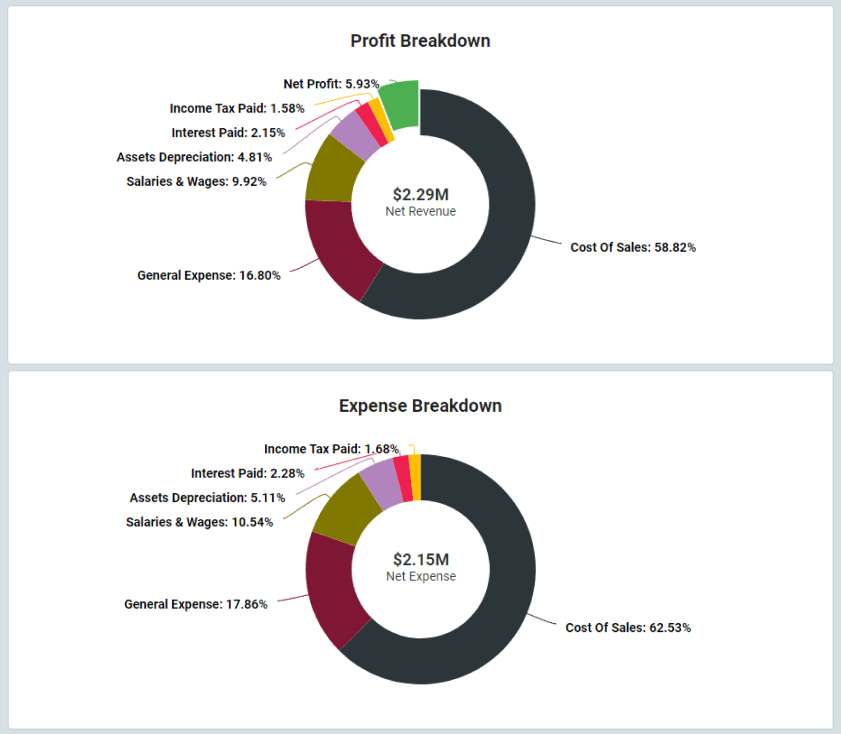
And that’s your detailed guide to writing your coffee shop business plan. Now, let’s check the latest industry trends ruling the coffee shop market.
Coffee Shop Industry Highlights 2023
Let’s dive further deep into market analysis with these latest industry trends in the coffee shop market:
- Coffee shop industry: The US coffee shop industry grew from $36 billion to 45.8 billion dollars between 2020-2022.
- Number of coffee shops: According to Statista , in 2022 there were a total of 38.4 thousand coffee shops in the US.
- Coffee drinkers: A performed market research indicates that the top coffee consumers aren’t youngsters, but seniors. Nearly, 70% of seniors consume coffee regularly.
- Employment growth rate: The total number of people employees in the coffee shop industry in th US increased on average by 4.9% between 2018-2023.
- Specialty coffee market: According to Grandview research , the US specialty coffee market is expected to grow at 10.9% CAGR between 2023-2030.
- Price per cup: According to Business Insider , the average price per coffee cup in the coffee shop is almost $5, making it an affordable luxury for people.
Related Coffee Shop Resources
- Coffee Shop Operational Plan
- Coffee Shop Financial Plan
- Coffee Shop Marketing Plan
- Latest Coffee Shop Business Trends
Download a sample coffee shop business plan
Need help writing your business plan? Let’s ease your plan writing process with our coffee shop business plan pdf . Download it for free and customize it as per your needs.
This modern intuitive template offers a step-by-step guide that will help you write a comprehensive and actionable business plan. It’s designed specifically for coffee shop businesses and includes examples relevant to your industry.
The Quickest Way to turn a Business Idea into a Business Plan
Fill-in-the-blanks and automatic financials make it easy.
Write your business plan with Upmetrics
Enhance the quality of your business planning with Upmetrics. With more than 400+ customizable sample business plans , it offers features like AI assistance to write an impactful business plan.
Whether you are starting your own coffee shop or taking over an existing coffee business, Upmetrics’ insightful guides and resources will help you craft a compelling business plan in easy steps.
Related Posts
Coffee Roaster Business Plan
Coffee Truck Business Plan
Financial Guide for New Startups
Cost To Start a Coffee Shop
Best Business Plan Writer
How to Start a Coffee Shop Business
Frequently asked questions, what are the key components of a successful coffee shop business plan.
The key elements of a coffee shop business plan are
- Executive summary
- Business overview
- Coffee industry and market analysis
- Sample menu
- Coffee shop design and layout
- Marketing and sales plan
- Key management team
- Operations plan
- Financial plan
Should we consider franchising our coffee shop?
Yes, you can. Franchising is a proven way of increasing the reach and profitability of your coffee business. Moreover, it’s easy to scale your business through a franchise business model.
What is a traditional business plan for a coffee shop?
A traditional plan is very similar to modern business plans. It includes a summary of the company’s goals, objectives, business values, marketing objectives, and financial plan. The modern plans, however, are intuitively designed to be more suited to investors interest.
Do I need a business plan to secure funding for my coffee shop?
Yes. Investors and investing firms will ask for a business plan before giving you a chance to present the coffee shop concept. By studying your plan, they will gauge the viability of your coffee business, and depending on the analysis they will decide whether to invest or not.
What should I include in the financial projections section of my business plan?
The financial projections of your coffee shop plan must include the following:
- Sales forecast
- Startup cost estimates
- Operating costs
- Balance sheet
- Income statement
- Cash flow statement
- Break-even analysis
About the Author
Upmetrics Team
Upmetrics is the #1 business planning software that helps entrepreneurs and business owners create investment-ready business plans using AI. We regularly share business planning insights on our blog. Check out the Upmetrics blog for such interesting reads. Read more
Plan your business in the shortest time possible
No Risk – Cancel at Any Time – 15 Day Money Back Guarantee

Create a great Business Plan with great price.
- 400+ Business plan templates & examples
- AI Assistance & step by step guidance
- 4.8 Star rating on Trustpilot
Streamline your business planning process with Upmetrics .

Don't bother with copy and paste.
Get this complete sample business plan as a free text document.
Coffee Shop Business Plan
Start your own coffee shop business plan
Java Culture
Executive summary executive summary is a brief introduction to your business plan. it describes your business, the problem that it solves, your target market, and financial highlights.">, opportunity.
People near the University of Oregon need not just coffee and tea, or pastries and snacks, but also a place to meet comfortably, have a group discussion, or just sit quietly, work, and read. That is available now near the University of Oregon campus, but too crowded too often, and not the right combination of factors for everybody.
Java Culture coffee bar is determined to become a daily necessity for local coffee addicts, a place to dream of as you try to escape the daily stresses of life and just a comfortable place to meet your friends or to read a book, all in one.
Java Culture will focus its marketing activities on reaching the University students and faculty, people working in offices located close to the coffee bar and on sophisticated teenagers. Our market research shows that these are the customer groups that are most likely to buy gourmet coffee products. Since gourmet coffee consumption is universal across different income categories and mostly depends on the level of higher education, proximity to the University of Oregon campus will provide access to the targeted customer audience.
Competition
Java Culture’s direct competitors will be other coffee bars located near the University of Oregon campus. These include Starbucks, Cafe Roma, The UO Bookstore, and other Food service establishments that offer coffee.
Great coffee, pastries, additional options for tea etc, very welcoming atmosphere, good wireless, desk space, comfortable chairs and tables, good pastries, a location close to the university campus.
Expectations
We plan to grow as shown in the chart below, taken from our sales forecast. We aim to maintain an industry-standard 60% gross profit margin and reasonable operating expenses, and to produce reasonable profits in the second and third year.
Financial Highlights by Year
Financing needed.
The owners will invest $140,000 and take out a bank loan for $30,000 to cover the start-up expenses and assets needed plus deficient spending in the early months.
The start-up expenses of $27,000 include:
- Legal expenses for obtaining licenses and permits as well as the accounting services totaling $1,300.
- Marketing promotion expenses for the grand opening of Java Culture in the amount of $3,500 and as well as flyer printing (2,000 flyers at $0.04 per copy) for the total amount of $3,580.
- Consultants fees of $3,000 paid to ABC Espresso Services <name changed> for the help with setting up the coffee bar.
- Insurance (general liability, workers’ compensation and property casualty) coverage at a total premium of $2,400.
- Pre-paid rent expenses for one month at $1.76 per square feet in the total amount of $4,400.
- Premises remodeling in the amount of $10,000.
- Other start-up expenses including stationery ($500) and phone and utility deposits ($2,500).
These expenses will be incurred before launch, so they take their place in our financial projections as negative retained earnings of $27,680 at the end of the month before we begin. That number shows up in the balance sheet.
The required start-up assets of $143,000 include:
- Cash in the bank in the total amount of $67,000, which includes enough to cover employees and owner’s salaries of $23,900 for the first two months and cash reserves for the first three months of operation (approximately $14,400 per month).
- Coffee beans (12 regular brands and five decaffeinated brands) – $6,000
- Coffee filters, baked goods, salads, sandwiches, tea, beverages, etc. – $7,900
- Retail supplies (napkins, coffee bags, cleaning, etc.) – $1,840
- Office supplies – $287
- Espresso machine – $6,000
- Coffee maker – $900
- Coffee grinder – $200
- Food service equipment (microwave, toasters, dishwasher, refrigerator, blender, etc.) – $18,000
- Storage hardware (bins, utensil rack, shelves, food case) – $3,720
- Counter area equipment (counter top, sink, ice machine, etc.) – $9,500
- Serving area equipment (plates, glasses, flatware) – $3,000
- Store equipment (cash register, security, ventilation, signage) – $13,750
- Office equipment (PC, fax/printer, phone, furniture, file cabinets) – $3,600
- Other miscellaneous expenses – $500
Funding for the company comes from two major sources–owners’ investments and bank loans. Two major owners, Arthur Garfield and James Polk, have contributed $70,000 and $30,00 respectively. All other investors have contributed $40,000, which brings the total investments to $140,000. The remaining $30,000 needed to cover the start-up expenses and assets came from the two bank loans–a one-year loan in the amount of $10,000 and a long-term (five years) loan of $20,000. Both loans were secured through the Bank of America. Thus, total start-up loss is assumed in the amount of $27,000.
The amounts show up in the balance sheet in the month prior to opening. The $140,000 investment shows up as Paid-in Capital. The $27,000 expenses show up as negative retained earnings. Assets and liabilities are there. This is all according to financial standards.
Problem & Solution
Problem worth solving.
People near the University of Oregon need not just coffee and tea, or pastries and snacks, but also a place to meet comfortably, have a group discussion, or just sit quietly, work, and read. That is available now near the University of Oregon campus, but too crowded too often, and not the right combination of factors for everybody.
Our Solution
Java Culture will make its best effort to create a unique place where customers can socialize with each other in a comfortable and relaxing environment while enjoying the best brewed coffee or espresso and pastries in town. We will be in the business of helping our customers to relieve their daily stresses by providing piece of mind through great ambience, convenient location, friendly customer service, and products of consistently high quality. Java Culture will invest its profits to increase the employee satisfaction while providing stable return to its shareholders.
Target Market
Market size & segments.
Coffee consumption has shown a steady 2.5% growth rate in the United States over the last decade. The retail coffee industry is flourishing in the U.S. Pacific Northwest. The local climate, with a long rainy season, is very conducive for the consumption of hot non-alcoholic beverages. At the same time, hot dry summers drive people into cafes to order iced drinks. Furthermore, coffee has really become a part of the lifestyle in the Pacific Northwest. Its discerning coffee drinkers are in favor of well-prepared, strong coffee-based beverages, which they can consume in a relaxing environment.
More specifically, the University of Oregon as close to 25K students and another 5-10K faculty and staff. And it is embedded in the Eugene, OR community of 200K people. Our main market will be students, faculty, staff, and nearby residents. But the campus area is a hub for the community and will attract other customers.
Current Alternatives

Our Advantages
Java Culture will cater to people who want to get their daily cup of great-tasting coffee in a relaxing atmosphere. Such customers vary in age, although our location close to the University campus means that most of our clientele will be college students and faculty. Our market research shows that these are discerning customers that gravitate towards better tasting coffee. Furthermore, a lot of college students consider coffee bars to be a convenient studying or meeting location, where they can read or meet with peers without the necessity to pay cover charges. For us, this will provide a unique possibility for building a loyal client base.
Keys To Success
The keys to success will be:
- Store design that will be both visually attractive to customers, and designed for fast and efficient operations.
- Employee training to insure the best coffee preparation techniques.
- Marketing strategies aimed to build a solid base of loyal customers, as well as maximizing the sales of high margin products, such as espresso drinks.
Marketing & Sales
Marketing plan.
Java Culture will position itself as unique coffee bar where its patrons can not only enjoy a cup of perfectly brewed coffee but also spend their time in an ambient environment. Comfortable sofas and chairs, dimmed light and quiet relaxing music will help the customers to relax from the daily stresses and will differentiate Java Culture from incumbent competitors.
In order to build up its client base, Java Culture will use some strategic banners and fliers during the launch period, utilize customer referrals and cross-promotions with other businesses in the community from time to time, and loyalty programs that work with android and IOS and other mobile phones, which is the preference of our market.
Our main thrust will be getting people to know, like, and trust us with content and engagement in Facebook, Instagram, Snapchat, and Twitter. We intend to maintain social media presences that are light on self-serving promotional quasi-advertising content, heavy on community participation, content, and engagement.
Java Culture baristas will handle the sales transactions. To speed up the customer service, at least two employees will be servicing clients–while one employee will be preparing the customer’s order, the other one will be taking care of the sales transaction. All sales data logged on the computerized point-of-sale terminal will be later analyzed for marketing purposes.
Locations & Facilities
Java Culture coffee bar will be located on the ground floor of the commercial building at the corner of West 13th Avenue and Patterson Street in Eugene, OR. The company has secured a one-year lease of the vacant 2,500 square feet premises previously occupied by a hair salon. The lease contract has an option of renewal for three years at a fixed rate that Java Culture will execute depending on the financial strength of its business.
The floor plan will include a 200 square feet back office and a 2,300 square feet coffee bar, which will include a seating area with 15 tables, a kitchen, storage area and two bathrooms. The space in the coffee bar will be approximately distributed the following way–1,260 square feet (i.e., 55% of the total) for the seating area, 600 square feet (26%) for the production area, and the remaining 440 square feet (19%) for the customer service area.
This property is located in a commercial area within a walking distance from the University of Oregon campus on the corner of a major thoroughfare connecting affluent South Eugene neighborhood with the busy downtown commercial area. The commercially zoned premises have the necessary water and electricity hookups and will require only minor remodeling to accommodate the espresso bar, kitchen and storage area. The coffee bar’s open and clean interior design with modern wooden decor will convey the quality of the served beverages and snacks, and will be in-line with the establishment’s positioning as an eclectic place where people can relax and enjoy their cup of coffee. The clear window displays, through which passerby will be able to see customers enjoying their beverages, and outside electric signs will be aimed to grab the attention of the customer traffic.
Milestones & Metrics
Milestones table.
| Milestone | Due Date | Who’s Responsible | |
|---|---|---|---|
| Sept 13, 2018 | |||
| Sept 14, 2018 | Marketing | ||
| Sept 18, 2018 | Team | ||
| Apr 16, 2019 | team |
Key Metrics
We have our forecasts for sales, direct costs, and operating expenses. As we get into the business we’ll develop standards based on experience for Facebook likes, Twitter follows, and other social media engagement. We expect to watch these very carefully.
Ownership & Structure
Java Culture is majority-owned by Arthur Garfield and James Polk. Mr. Garfield holds a Bachelor’s Degree in Business Administration from the University of ZYX. He’s worked for several years as an independent business consultant. Previously, he owned the ABC Travel Agency, which he profitably sold four years ago. Mr. Garfield has extensive business contacts in Oregon that he will leverage to help his new venture succeed. Mr. Polk has a Bachelor’s Degree in Psychology from the XYZ State University. For the last five years he has worked as a manager of DEF Ristorante, a successful Italian restaurant in Portland, OR. Under Mr. Polk’s management, the restaurant has consistently increased sales while maintaining a lower than average level of operating expenses.
Investors will not be involved into the daily management decisions at Java Culture. They will hire a professional manager who will oversee all the coffee bar operations. Three full-time baristas will be in charge of coffee preparation. They will hire two more part-time employees to fulfill the staffing needs. In the second and third year of operation will add additional employees if and when needed.
Management Team
A full-time manager will be hired to oversee the daily operations at Java Culture. The candidate (who’s name is withheld due to his current employment commitment) has had three years of managerial experience in the definitely industry in Oregon. This person’s responsibilities will include managing the staff, ordering inventory, dealing with suppliers, developing a marketing strategy and perform other daily managerial duties. We believe that our candidate has the right experience for this role. A profit-sharing arrangement for the manager may be considered based on the first year operational results.
Personnel Table
| FY2019 | FY2020 | FY2021 | |
|---|---|---|---|
| Manager | $60,000 | $66,000 | $72,600 |
| Baristas (3) | $90,000 | $94,500 | $99,225 |
| Other employees (2) | $43,200 | $45,360 | $47,628 |
| Totals | $193,200 | $205,860 | $219,453 |
Financial Plan investor-ready personnel plan .">
Key assumptions.
- We assume a steadily growing potential market in line with growth at the university, trends.
- We assume industry standard gross margins
- We assume relative status quo regarding technology and trends in the coffee industry
Revenue by Month
Expenses by month, net profit (or loss) by year, use of funds.
The start-up expenses include an estimated $17,000 consisting of several items:
- Legal expenses for obtaining licenses and permits as well as the accounting services totaling $1,500.
- Insurance (general liability, workers’ compensation and property casualty) coverage at a total premium of $1,500.
- Other start-up expenses including website ($4,000) and phone and utility deposits ($2,500).
The required start-up assets of $71,000 include:
- Plates, glasses, etc. worth approximately $2,000
- Espresso machine
- Coffee maker
- Coffee grinder
- Food service equipment (microwave, toasters, dishwasher, refrigerator, blender, etc.)
- Storage hardware (bins, utensil rack, shelves, food case)
- Counter area equipment (counter top, sink, ice machine, etc.)
- Serving area equipment (plates, glasses, flatware)
- Store equipment (cash register, security, ventilation, signage)
- Office equipment (PC, fax/printer, phone, furniture, file cabinets)
- Other miscellaneous expenses
Sources of Funds
Projected profit & loss.
| FY2019 | FY2020 | FY2021 | |
|---|---|---|---|
| Revenue | $561,010 | $654,500 | $743,000 |
| Direct Costs | $224,404 | $261,800 | $297,200 |
| Gross Margin | $336,606 | $392,700 | $445,800 |
| Gross Margin % | 60% | 60% | 60% |
| Operating Expenses | |||
| Salaries & Wages | $193,200 | $205,860 | $219,453 |
| Employee Related Expenses | $38,640 | $41,172 | $43,891 |
| Rent | $36,000 | $38,000 | $42,000 |
| Marketing | $28,051 | $32,725 | $37,150 |
| Utilities, phones, Internet etc. | $6,000 | $6,000 | $6,000 |
| Total Operating Expenses | $301,891 | $323,757 | $348,493 |
| Operating Income | $34,716 | $68,943 | $97,306 |
| Interest Incurred | $951 | $583 | $427 |
| Depreciation and Amortization | $12,000 | $12,000 | $12,000 |
| Gain or Loss from Sale of Assets | |||
| Income Taxes | $3,265 | $8,454 | $12,732 |
| Total Expenses | $542,511 | $606,593 | $670,853 |
| Net Profit | $18,499 | $47,907 | $72,147 |
| Net Profit/Sales | 3% | 7% | 10% |
Projected Balance Sheet
| Starting Balances | FY2019 | FY2020 | FY2021 | |
|---|---|---|---|---|
| Cash | $67,000 | $80,234 | $133,240 | $214,467 |
| Accounts Receivable | $0 | $0 | $0 | $0 |
| Inventory | $16,000 | $21,815 | $24,765 | $24,765 |
| Other Current Assets | ||||
| Total Current Assets | $83,000 | $102,048 | $158,005 | $239,232 |
| Long-Term Assets | $60,000 | $60,000 | $60,000 | $60,000 |
| Accumulated Depreciation | ($12,000) | ($24,000) | ($36,000) | |
| Total Long-Term Assets | $60,000 | $48,000 | $36,000 | $24,000 |
| Total Assets | $143,000 | $150,048 | $194,005 | $263,232 |
| Accounts Payable | $0 | $0 | $0 | |
| Income Taxes Payable | $2,232 | $2,116 | $3,184 | |
| Sales Taxes Payable | $0 | $0 | $0 | |
| Short-Term Debt | $13,683 | $3,833 | $3,989 | $4,152 |
| Prepaid Revenue | ||||
| Total Current Liabilities | $13,683 | $6,065 | $6,105 | $7,336 |
| Long-Term Debt | $16,317 | $12,484 | $8,495 | $4,343 |
| Long-Term Liabilities | $16,317 | $12,484 | $8,495 | $4,343 |
| Total Liabilities | $30,000 | $18,549 | $14,600 | $11,679 |
| Paid-In Capital | $140,000 | $140,000 | $140,000 | $140,000 |
| Retained Earnings | ($27,000) | ($27,000) | ($8,501) | $39,406 |
| Earnings | $18,499 | $47,906 | $72,148 | |
| Total Owner’s Equity | $113,000 | $131,499 | $179,406 | $251,553 |
| Total Liabilities & Equity | $143,000 | $150,048 | $194,005 | $263,232 |
Projected Cash Flow Statement
| FY2019 | FY2020 | FY2021 | |
|---|---|---|---|
| Net Cash Flow from Operations | |||
| Net Profit | $18,499 | $47,907 | $72,147 |
| Depreciation & Amortization | $12,000 | $12,000 | $12,000 |
| Change in Accounts Receivable | $0 | $0 | $0 |
| Change in Inventory | ($5,815) | ($2,950) | $0 |
| Change in Accounts Payable | $0 | $0 | $0 |
| Change in Income Tax Payable | $2,232 | ($116) | $1,068 |
| Change in Sales Tax Payable | $0 | $0 | $0 |
| Change in Prepaid Revenue | |||
| Net Cash Flow from Operations | $26,917 | $56,840 | $85,216 |
| Investing & Financing | |||
| Assets Purchased or Sold | |||
| Net Cash from Investing | |||
| Investments Received | |||
| Dividends & Distributions | |||
| Change in Short-Term Debt | ($9,850) | $156 | $163 |
| Change in Long-Term Debt | ($3,833) | ($3,989) | ($4,152) |
| Net Cash from Financing | ($13,683) | ($3,833) | ($3,989) |
| Cash at Beginning of Period | $67,000 | $80,234 | $133,240 |
| Net Change in Cash | $13,234 | $53,007 | $81,226 |
| Cash at End of Period | $80,234 | $133,240 | $214,467 |

The quickest way to turn a business idea into a business plan
Fill-in-the-blanks and automatic financials make it easy.
No thanks, I prefer writing 40-page documents.

Discover the world’s #1 plan building software

Coffee Shop Business Plan Template
If you want to start a coffee shop business or expand your current one, you need a business plan.
Over the past 20+ years, our coffee shop business plan template has helped over 7,000 entrepreneurs and business owners create business plans to start and grow their coffee shops.
Below is an example coffee shop business plan template that will help you write your own coffee shop business plan:
2. Company Overview – Your company overview should include a detailed explanation of the company’s concept, location, products/services offered, customer profile and market size.
3. Industry Analysis – This section involves researching various aspects of the coffee industry such as its size, competitive environment, key players and trends.
4. Customer Analysis – The customer analysis should include a description of your target audience, their needs and how you plan to attract and retain these customers.
5. Competitive Analysis – This should include a description of your competitors, their strengths and weaknesses and how you plan to compete with them.
6. Marketing Plan – Your marketing plan should outline the strategies and tactics for achieving your specific marketing objectives.
7. Operations Plan – This should outline the day-to-day operations of the business, its personnel structure, hierarchy and supplier relationships.
8. Management Team – This section should include a description of the key players in the company, their skills and responsibilities.
9. Financial Plan – The Financial Plan should include your businesses’ financial statements and funding requirements.
Next Section: Executive Summary >
Coffee Shop Business Plan FAQs
What is the easiest way to complete my coffee shop business plan, where can i download a sample coffee shop business plan pdf, what is a coffee shop business plan.
A coffee shop business plan is a formal document that outlines the goals, strategies, and tactics for launching and operating a coffee shop. It describes in detail how the business will operate, including the types of products and services provided, the target market, the proposed location, and the projected financials. It serves as a roadmap for the business and helps to ensure that all aspects of the business are considered and planned for in advance.
It also includes a full financial plan including five year financial projections, your income statement, balance sheet and cash flow statements.
Why Do You Need a Business Plan?
A business plan is an essential document that captures your vision, outlines your market, and provides the financial blueprint for your entire operation. It is a guide to your overall business planning process and is important for all of these reasons:
1. A business plan sets a clear direction: Perhaps the most significant benefit of having a business plan is that it gives you a clear direction and purpose. It outlines your goals and objectives, how you plan to achieve them, and the timeline and resources required. A well-written business plan also clarifies your target audience and helps you understand their needs and preferences. With a solid business plan, you’ll have a better idea of where to focus your efforts and resources, which can save you time, money, and frustration.
2. Helps secure funding: Opening a coffee shop requires a significant investment in equipment, inventory, rent, and staffing, among other expenses. To secure funding from investors or lenders, a business plan is essential. It demonstrates your knowledge of the industry and market trends, your marketing strategy, financial projections, and how you plan to mitigate risks. A well-thought-out business plan can help convince potential investors that you have a viable idea and are a good investment.
3. Provides a roadmap for growth: A business plan is not just for starting your coffee shop; it’s also essential for long-term success. It’s a roadmap that can help you navigate the ups and downs of running a business. A good plan should contain measurable goals that you can track and adjust as needed. It should also have contingency plans if things don’t go as expected. As your coffee shop grows and evolves, refer to your business plan to ensure that you stay on track and adapt to changing market conditions.
4. Attracts and retains employees: In addition to investors and lenders, your business plan can also help attract and retain employees. A clear business plan shows potential employees what your vision is and what you want to achieve. It also shows them how they can contribute to your success and how you plan to reward them for their efforts. Once you have your team in place, refer to your business plan to ensure everyone is aligned with your goals and objectives.
5. Enhances credibility and professionalism: Finally, a business plan can enhance your credibility and professionalism. It shows that you have thought through your ideas and have a clear plan for how to execute them. This level of detail and preparation can go a long way in building trust with potential investors, lenders, employees, and customers. A well-written business plan can also make you stand out from your competition by demonstrating your attention to detail, industry knowledge, and commitment to success.
What Are the Sources of Funding for a Coffee Shop?
The main sources of funding for a coffee shop are bank loans and angel investors. With regards to bank loans, banks will want to review your business plan and gain confidence that you will be able to repay your loan and interest. To acquire this confidence, the loan officer will not only want to confirm that your financials are reasonable. But they will want to see a professional plan. Such a plan will give them the confidence that you can successfully and professionally operate a business and ultimately help you secure funding.
The second most common form of funding for a coffee business or cafe is angel investors. Angel investors are wealthy individuals who will write you a check. They will either take equity in return for their funding, or, like a bank, they will give you a loan. Venture capitalists will not fund a coffee shop. They might consider funding a chain, but never an individual location. This is because most venture capitalists are looking for millions of dollars in return when they make an investment, and an individual location could never achieve such results.
COFFEE SHOP BUSINESS PLAN OUTLINE
- Coffee Shop Business Plan Home
- 1. Executive Summary
- 2. Company Overview
- 3. Industry Analysis
- 4. Customer Analysis
- 5. Competitive Analysis
- 6. Marketing Plan
- 7. Operations Plan
- 8. Management Team
- 9. Financial Plan
- 10. Appendix
Start Your Coffee Shop Plan Here
Other Helpful Business Plan Articles & Templates

How to Create a Coffee Shop Business Plan and Executive Summary: Free Template & Guide
By Debra Weinryb
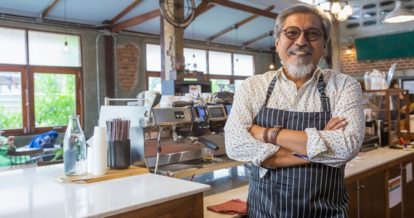
Before you open a coffee shop, you will need to have a coffee shop business plan. This important document acts as a roadmap for your coffee shop business adventure – with everything you need to turn your business dreams into a reality.
If you’re passionate about coffee but have never written a business plan before, it can be nerve-racking to start. To help you out, we’ve put together a complete guide to writing a successful coffee shop business plan. In this guide, we’ll cover:
- What is a coffee shop business plan?
- How to write a business plan for a coffee shop
- The 10 sections of every successful coffee shop business plan
- A free coffee shop business plan template
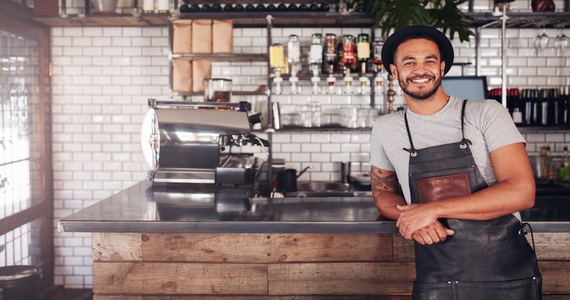
Create a custom business plan for your coffee shop concept with this free template.
What is a Coffee Shop Business Plan?
A coffee shop business plan is a document that explains what your business idea is and how it will succeed. It answers several questions, like how you will set up your coffee shop, how you will fund your business, and what revenue you expect to make. It includes information about your marketing plan, sales strategy, coffee shop customers , pricing structure, competitors, required labor, and financial plan.
Similar in length to a traditional restaurant business plan , it’s a succinct document that usually spans 15-20 pages, but no more than 30 pages. Coffee shop business owners can make their plans pop with visuals like photos and designs of their coffee house, and site plans of their retail store. Charts and graphs are also used to show financial inventory information, like how much coffee beans will be purchased monthly and at what cost, for example.
Once complete, you will be able to show your coffee house business plan to potential investors, bankers, and business partners. That’s why it’s so important to dedicate a large amount of time and energy into getting your java shop business plan underway early on.

How to Write a Business Plan for a Coffee Shop
With the proper guidance, your brew shop business plan can be easy to write. That’s why having a coffee shop business plan template is a useful aid for conceptualizing your business and goals before you start to write. Additionally, having a coffee shop business plan example can help you think of key elements to demonstrate your coffee shop’s potential for growth and profitability – which are both important to attract funding.
Elements of a Coffee Shop Business Plan
Executive summary for a coffee business .
Start with your executive summary – a short and high-level overview of each section in your coffee house business plan. In any business plan sample for a coffee shop, you’ll see that this is the first section because it gives readers crucial information about your business before you dive into details.
The executive summary section describes your business concept, the problem it solves, your target market, financial highlights, lease information, as well as your vision for the menu, products, and how you will service coffee – whether that’s in a kiosk, drive through, pickup, or sit-down coffee shop.
As you write your executive summary, consider who will read your brew shop business plan and what you would like them to know. After all, you want to capture your reader’s attention and entice them to continue to read or even invest!
Here are a few key points of interest you can mention in your executive summary:
- Ambiance: The character and atmosphere of your coffee shop
- Location: Information on your potential foot traffic, facility/lease, and seating capacity.
- Kitchen storage: Space for multiple blends of coffee or a high-end espresso machine.
- Goals: Your mission statement and guiding principles that will drive your success.
- Funding: What funds you need and how you will use them to achieve your vision.
Business Overview
The Business Overview section takes a deeper dive into the coffee industry as a whole, your local market, and what makes your coffee shop model unique among the competition. Here, start by giving a brief overview as to when and why you started your coffee shop business. In addition, you can include major achievements such as hitting target sales goals or opening new coffee shop locations.
In this section, you can also go into more detail about the business operations of your neighborhood coffee shop . For example, explain what coffee and food products you will offer, your hiring and labor practices, and how you’ll brew coffee. This, of course, will depend on your coffee shop business model.
Here are a few types of coffee shops and how they could be described:
- Grab-and-go coffee shop: Pickup or drive through only, so folks can grab a cup of coffee in a heartbeat
- Traditional coffee shop: Sells baked goodies and a variety of coffee drinks in a relaxed atmosphere
- The coffee bar: Like a homey living room, with lounge music, WiFi, and fresh coffee
Management and Staff
In this section, you will talk about ownership. Start with the business owner(s) who will manage your coffee shop, and talk about their experiences/qualifications that will make them successful. You’ll also include details of who will take care of your day-to-day coffee shop operations.
Every coffee shop will need baristas who take care of sales and make drinks, but those that sell food may also need someone to operate basic kitchen equipment. Additionally, you may want to hire someone to do marketing and advertising, or an accountant to take care of your bookkeeping.
After deciding on what jobs you want to create, you’ll need to identify if they are part-time or full-time, how you will recruit/train them (e.g., barista training), and what you will pay them in wages and benefits. Your employees will factor into your financial forecast and expenses later on in your business plan for a coffee shop, so it’s essential to get a head start on your hiring budget.
Coffee Shop Market Analysis
Your Market Analysis section should show that you’ve looked at your target market, assessed your location, and understand how you’ll compete against other coffee shops in the area. Remember to consider what makes your restaurant unique and what will help it stand out. Here are two ways you can do just that:
Mention if your coffee shop is in a central location, such as near a college where students break for lunch, or next to office buildings where professionals drop in on their way to work. If you are one of many coffee shops in an area, consider pointing out what makes you different, like your wide variety of specialty coffees and the quality of your food.
Customer Analysis
Include information about your ideal customer – with details on who they are, why they shop at your coffee shop, and any metrics. If you performed market research before starting your coffee shop, include that too. For example, if you have data on a high demand for espresso in your area, the sales potential for a drive-through espresso stand could be very promising.
Sample Menu
A section with a sample menu lets investors know exactly what you’ll be serving. Keep in mind that your sample menu should be a differentiator – otherwise, why would investors think that customers should choose your coffee over competitors who serve similar drinks?
Here are a few tips for choosing what to include in your great sample menu:
- Think about the types of coffee beans that could set you apart. Maybe you only serve organic coffee beans, unlike your competitors.
- Cater the types of drinks you serve to your target market. For a young customer, sweet frappuccinos, hot chocolates, and drinks topped with whipped cream can be popular. For health-conscious consumers, options like tea and “light” coffee may perform better.
- If your customers will be hungry, such as students on a lunch break, or employees on their way to work, then consider including food items like pastries.
Marketing Plan and Publicity
An effective marketing plan is essential for bringing new customers through your coffee shop’s door and retaining your loyal guests. In this section, start by describing how you want to drive incoming traffic, in addition to what budget you have in mind, and your expected return on investment. If you have a lot of detailed information, you may want to create a separate marketing plan document.
To cover all your bases, you can include the Four Ps of Marketing:
- Product: What beverage and food products you will offer? For example, will you offer non-coffee drinks, frappuccinos, espresso, or cold brews?
- Price: What is your average price point and how does it compare to competitive coffee shops?
- Place: The location of your coffee shop and how it will impact your success. For example, will you operate kiosks, and if so, where will they be placed to get the most foot traffic?
- Promos: How will you drive customers to your location(s)? Examples include live music, giving free samples, advertising, or partnering with influencers or other organizations.
Business Operations and Operating Plan
The business plan operations section includes the physical requirements of your coffee shop business, like retail space, specialized equipment, supplies, and labor. When describing your business’ operational expenses, also consider showing where your coffee shop is trying to save money. For example, if you are buying used furniture or equipment, let your reader or potential investor know how you are cutting losses.
Here are a few areas you can include in the operating plan section:
Retail Space
- Space you plan to lease, buy, or rent for your coffee shop
- Parking spaces for a truck or for customers to access your coffee shop
Specialized Equipment
- Coffee machines like a coffee grinder, a brewing machine, or a hot water dispenser
- Specific arrangements like a sandwich prep table, counter space, or a display case
- Technology such as a coffee shop POS to process transactions and track inventory
- List your suppliers according to type – for your coffee beans and other food and drink products
- Menu items you will buy vs. make in your coffee shop, such as croissants or cookies
- The frequency at which you need to restock your coffee shop inventory
- Staff such as a Barista to brew coffee
- Staff to do food preparation, menu creation, and cleaning
- A manager to oversee payroll and human resources
Financial Forecast and Expenses
This is an important section, especially if you need to attract investors to your coffee shop. Since coffee shops are often smaller storefronts, usually with a lower profit margin , this section needs to emphasize how your coffee shop business will grow and be profitable in the long-term.
Your financial forecast and expenses section should include the following:
- Cash flow statement with monthly projections for all your coffee shop purchases
- Balance sheet to give investors a snapshot of your assets, liabilities and equity
- Break even analysis to demonstrate the sales you need in order to make a profit
Coffee Shop Business Plan: Next Steps and Plan Template
To get ideas of details to include, use a coffee shop business plan sample.
Whether you own a coffee shop or are just starting out, writing a coffee shop business plan is essential to your success. In such a highly competitive coffee market , you need a business plan to show potential investors what makes your store stand out.
If you’re looking for a coffee shop business plan example, a template is a great place to start. By using a coffee business plan template , you can improve your chances of securing funding or attracting new business partners. Using a business plan sample for a coffee shop will also keep you organized and show readers how your coffee shop can be successful.

FAQs: Coffee Shop Business Plan
If you have any lingering questions, we’ve answered the top coffee shop business plan FAQs.
How profitable is a coffee shop?
A coffee shop business’ profits can range from 2.5% to 85% of gross sales, according to this Chron article . The amount of profit depends on the size of your coffee shop – smaller coffee shops usually have lower profits.
How do you start a coffee shop business?
To start a coffee shop business, do lots of research on the industry and your market so you can plan how to separate yourself, your menu, and the quality of your products from competitor coffee shops. Consider where your coffee shop might be located and what kind of customer base you’ll have. Map out the expected costs for operations, marketing, etc. in a financial plan. This will help you plan a strategy for success so you can create a strong coffee shop business plan to present to potential investors.
How much budget is needed to open a coffee shop?
How much budget you need to open a coffee shop will depend on the location of your business. Start by doing some research on real estate in the area where you want your coffee shop business, suppliers for your menu items, cost of hiring employees, and other operating costs. Also, consider what kind of marketing campaigns – such as email, direct mail, and advertisements – that you might want to run and include those in your budget too.
How do you start a business proposal for a coffee shop?
To start a business proposal for a coffee shop, use a coffee shop business plan sample and make sure you include the key sections: an executive summary, business overview, management and staff, market analysis, marketing and publicity, operations plan, and financial forecast and expenses.
Also, make sure you do enough research before you start so you understand how a coffee shop business works, your market, and your competitors, and have relevant facts and figures to support the plan for your new business.

Debra was a Content Marketing Specialist at TouchBistro, writing about the latest food and restaurant industry trends. In her spare time, Debra enjoys baking and eating together with family and friends.
Download our free inventory template
Sign up for our free weekly touchbistro newsletter.

Your Complete Guide to Restaurant Reservations

More Articles
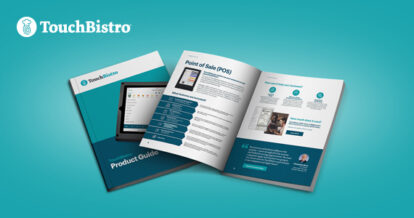
Join over 35,000 subscribed restaurateurs and unlock
- Free industry reports, checklists, templates, guides, and more
- The latest restaurant trends delivered straight to your inbox
- Tips for running a successful restaurant

Coffee shop business plan template + PDF
This guide introduces an innovative AI Business Plan Generator template, specifically designed for entrepreneurs eager to launch or expand their coffee shop ventures. It's important to note that the names and financial projections provided in this example are purely for illustrative purposes, serving as educational resources to guide you through your business planning process. These examples are carefully selected to show how you can customize your own AI-generated Coffee Shop Business Plan, empowering you to overcome obstacles and seize opportunities in the coffee shop sector.
For those seeking a tailored approach, we offer a downloadable 'Coffee Shop Business Plan PDF' . This document is crucial for entrepreneurs committed to developing a compelling and effective strategy for starting or growing their coffee shop business. The 'AI Business Plan Generator' acts as a comprehensive guide, providing in-depth insights into the coffee shop market. It equips you with the essential tools to skillfully manage and grow your coffee shop business, leveraging the power of AI for unparalleled strategic planning.

How this coffee shop business plan sample was created
Easily develop your customized coffee shop business plan with our AI Business Plan Generator. Simply click 'Generate your business plan' and answer a series of targeted questions about your coffee shop project. Our advanced AI technology will assess your responses to produce a business plan that perfectly matches the goals and requirements of your coffee shop business. This efficient and straightforward process takes only 5-10 minutes, resulting in a comprehensive and well-organized plan. Our platform allows for adjustments and refinements to your plan, ensuring it accurately embodies your unique vision for your coffee shop venture. Once completed, your plan is ready for download, offering a clear and detailed guide for launching and expanding your coffee shop business. Leverage the power of our AI business plan generator, specially designed for coffee shop businesses, to boost your strategic planning efforts.

Coffee shop business plan sample
Executive summary, business description, market research and analysis, swot analysis.
- Organizational Structure and Management Team
Products or Services
Marketing and sales strategy, operations plan, financial projections, risk analysis.

Nestled in the vibrant heart of Portland, Oregon, Roast & Revel Coffee Shop emerges as a beacon of artisanal excellence and community spirit in a city celebrated for its rich coffee culture. With an unwavering commitment to quality, innovation, and social connectivity, Roast & Revel is poised to redefine the coffee experience, blending the art of coffee-making with the warmth of community gathering. This executive summary outlines Roast & Revel’s strategic direction, key offerings, competitive landscape, financial projections, and the dedicated team leading this venture.
The Concept and Industry
Roast & Revel Coffee Shop is more than just a coffee shop; it is a destination where the craft of coffee and community converge. Offering an array of high-quality, artisan coffee blends along with specialty teas, freshly baked pastries, and light meals, Roast & Revel caters to the discerning tastes of professionals aged 25-45, college students, and local residents. Situated in an industry that thrives on innovation and connection, Roast & Revel sets itself apart with its unique blends, like the “Morning Zen Blend” and “Caramel Swirl Indulgence,” and its community-centric ambiance that fosters both productivity and relaxation.
Market Analysis and Strategy
Our in-depth market analysis reveals a growing demand for premium coffee experiences and spaces that serve as community hubs. Roast & Revel’s target market includes a broad spectrum of customers, from young professionals seeking a conducive work environment to students and locals in search of a cozy gathering space. Our marketing and sales strategy leverages social media engagement, local SEO optimization, participation in community events, a loyalty program, and innovative collaborations to build brand awareness and customer loyalty. Additionally, our subscription service for freshly roasted beans and online ordering capabilities cater to the increasing desire for convenience among our target demographic.
Competitive Landscape and Differentiators
Roast & Revel enters a competitive landscape marked by established coffee chains and independent cafes such as Brewed Awakenings Café and Java Jive Coffee House. Our differentiators lie in our artisanal product range, superior customer service, and a focus on sustainability and local sourcing. Unlike our competitors, Roast & Revel places a strong emphasis on community engagement, hosting events and workshops that resonate with our customer base’s values and interests.
Operational Excellence
At the core of Roast & Revel’s operational plan is a commitment to excellence and efficiency. Our operations are underpinned by a streamlined workflow, from meticulous bean selection and roasting to customer service and inventory management. We prioritize sustainability in our supply chain and adopt best practices in quality control, ensuring every cup of coffee meets our high standards. Our facilities are equipped with state-of-the-art equipment, and our team receives ongoing training to stay ahead of industry trends.
Financial Outlook
Roast & Revel anticipates a promising financial trajectory, with projected revenues increasing from $250,000 in year one to $600,000 in year five, alongside improving net profit margins from 10% to 20%. These projections are supported by aggressive marketing, menu diversification, and an expanding customer base. Our break-even analysis indicates viability within the first year, a testament to our strategic planning and market demand.
The Team Behind Roast & Revel
Leading Roast & Revel’s journey are industry veterans and passionate visionaries, including Emily Clark, our General Manager with over a decade of coffee industry experience, and Jordan Lee, our award-winning Head Barista. Supported by Alexa Kim, our innovative Marketing Manager, and Charlie Morgan, our Operations Manager with a knack for efficiency and sustainability, our team is our greatest asset.
Roast & Revel Coffee Shop stands on the threshold of transforming Portland’s coffee scene through its unwavering dedication to quality, community, and sustainability. With a solid strategic foundation, a deep understanding of our market, and a team unmatched in talent and passion, Roast & Revel is set to brew not just coffee, but also a richer, more connected community experience.
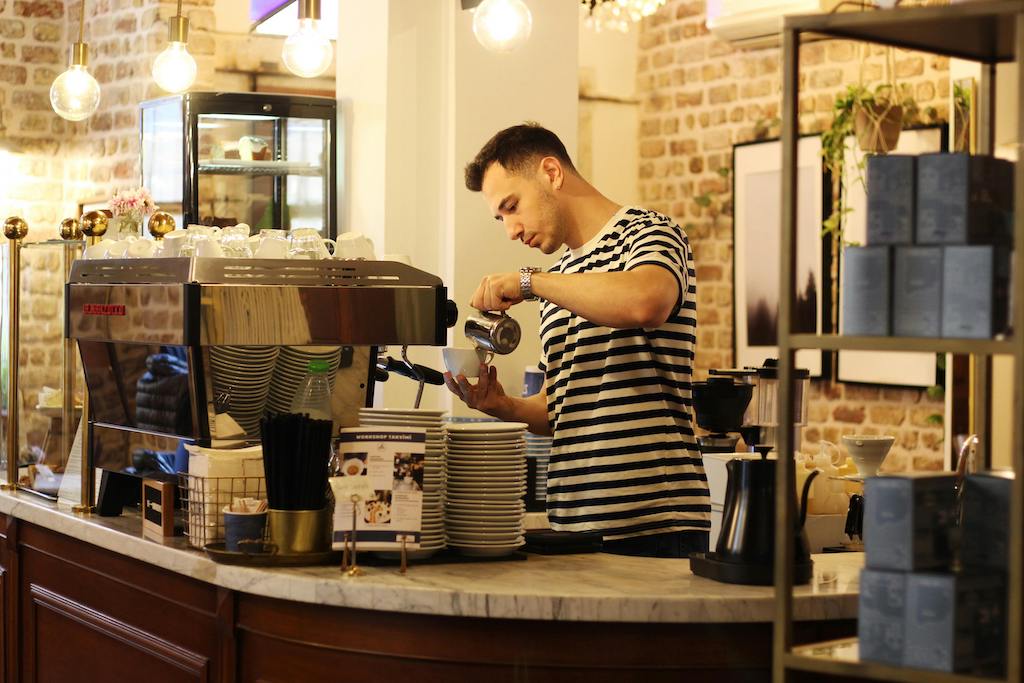
"Roast & Revel Coffee Shop" is nestled in the heart of Portland, Oregon, a city renowned for its vibrant coffee culture and community-centric locales. Our establishment is positioned not just as a coffee shop but as a sanctuary for coffee aficionates and casual drinkers alike, aiming to serve as the go-to spot for those seeking premium coffee experiences. The coffee shop industry, dynamic and ever-evolving, caters to a wide audience ranging from professionals seeking a quiet place to work, students looking for a study haven, to local residents desiring a warm cup and a welcoming atmosphere. Within this bustling industry, "Roast & Revel" stands out by offering not only high-quality, artisan coffee but also a space where the community can gather, share ideas, and revel in the joy of coffee.
The inception of "Roast & Revel" stemmed from a simple yet profound desire to create a space that encapsulates the essence of Portland's coffee scene while pushing the boundaries of traditional coffee offerings. Recognizing the growing demand for sophisticated and diverse coffee options coupled with a cozy ambiance, the founders embarked on this adventure in the year 2021. The aim was not merely to start a business but to weave into the fabric of the community, providing a space that feels like home to all who enter.
Our mission is "To brew not just coffee, but also community and connections, one cup at a time." This statement reflects our core philosophy of fostering a welcoming space where the love for meticulously roasted coffee and the warmth of community converge. We strive to be more than just a coffee shop; we aim to be a hub of creativity, relaxation, and inclusivity, where every guest feels valued and inspired.
Legally, "Roast & Revel Coffee Shop" is structured as a Limited Liability Company (LLC). This formation allows for flexible management structures while providing personal liability protection for its members, fostering an environment conducive to growth and innovation. This legal structure supports our vision of creating a lasting brand that not only serves excellent coffee but also contributes positively to our community and employees.
Looking toward the long-term potential of "Roast & Revel" , we see a future bright with possibilities. The coffee industry shows no signs of slowing down, with an increasing number of consumers seeking out specialty coffee and unique café experiences. Our business is poised for growth, leveraging Portland's rich coffee culture and our unique value proposition. We envision expanding our footprint, both physically in terms of new locations and digitally through an enhanced online presence, including e-commerce for our specialty blends. Further, we aim to deepen our community engagement through events, workshops, and partnerships with local businesses and artists, reinforcing our role as a community hub.
Our commitment to quality, community, and sustainability sets the foundation for a business with enduring appeal. By staying true to our mission and continually adapting to the evolving tastes and preferences of our customers, we believe "Roast & Revel Coffee Shop" will not only thrive but also set new standards in the coffee industry. As we look to the future, our goal remains clear: to serve as a beacon of warmth and excellence in Portland's coffee scene, inviting people from all walks of life to roast, revel, and rejoice in the simple pleasures that a great cup of coffee can bring.
The coffee shop industry, characterized by its robust and adaptive nature, continues to flourish, driven by evolving consumer preferences and the growing appreciation for artisanal and specialty coffee. Recent trends indicate a shift towards premiumization, with consumers willing to pay higher prices for superior quality, ethically sourced coffees, and unique coffee experiences. The industry has also seen a rise in demand for coffee shops that serve as community hubs, offering not just beverages but a conducive environment for work and social interaction. The U.S. coffee shop market is expansive, with a revenue exceeding $45 billion in 2022, expected to grow annually by 4.5% through to 2025. This growth trajectory is fueled by increasing coffee consumption and the integral role coffee shops play in modern social and professional life.
"Roast & Revel Coffee Shop" is strategically positioned to serve a diverse target market within Portland, Oregon, which includes professionals aged 25-45, college students, and local residents. This demographic is particularly attractive due to their disposable income, propensity to frequent coffee shops, and value for premium coffee. The size of this target market within Portland is substantial, offering significant growth potential, especially considering the city's reputation for its vibrant coffee culture and the high premium placed on community and quality by its residents.
The market’s needs and demands are multifaceted, extending beyond the coffee itself to include the desire for a comfortable and welcoming space where individuals can unwind or work. Customers are looking for a premium coffee experience that goes beyond the traditional cup of joe to include diverse artisanal blends, sustainable and ethically sourced products, and innovative beverage options. Additionally, there is a growing demand for locations that can host community events, provide a conducive work environment, and foster social connections.
Market trends underscore the importance of sustainability and ethical sourcing, with consumers increasingly motivated by the story behind their coffee. There's also a noticeable preference for coffee shops that leverage technology, offering convenient ordering, payment options, and loyalty programs. Moreover, amidst the digital age, the role of social media in influencing consumer choices cannot be overstated, with visually appealing drinks and spaces becoming a significant draw.
The main competitors for "Roast & Revel Coffee Shop" in Portland include establishments like Brewed Awakenings Café, Java Jive Coffee House, and The Daily Grind Espresso Bar, among others. These competitors offer insights into the market's dynamics, each presenting distinct strengths such as well-established customer bases and prime locations. However, weaknesses like limited beverage innovation and inconsistent quality provide strategic entry points for "Roast & Revel" . Market share among competitors is relatively fragmented, suggesting room for a new entrant that excels in quality, innovation, and community engagement to carve out a significant presence.
Potential barriers to entry in this market include the high initial investment costs associated with establishing a premium coffee shop, the intensity of competition, and the critical need for prime location to attract the target demographic. Overcoming these barriers will require careful strategic planning, a strong value proposition, and leveraging unique strengths such as sourcing unique coffee blends, cultivating a strong brand identity, and creating a vibrant community space.
In conclusion, while the coffee shop industry in Portland is competitive and rapidly evolving, "Roast & Revel Coffee Shop" is uniquely positioned to meet the market's growing needs and demands. By focusing on quality, sustainability, and community, alongside careful analysis and strategic action against potential barriers and competitors, the business is set to not just enter the market, but to thrive and expand within it.
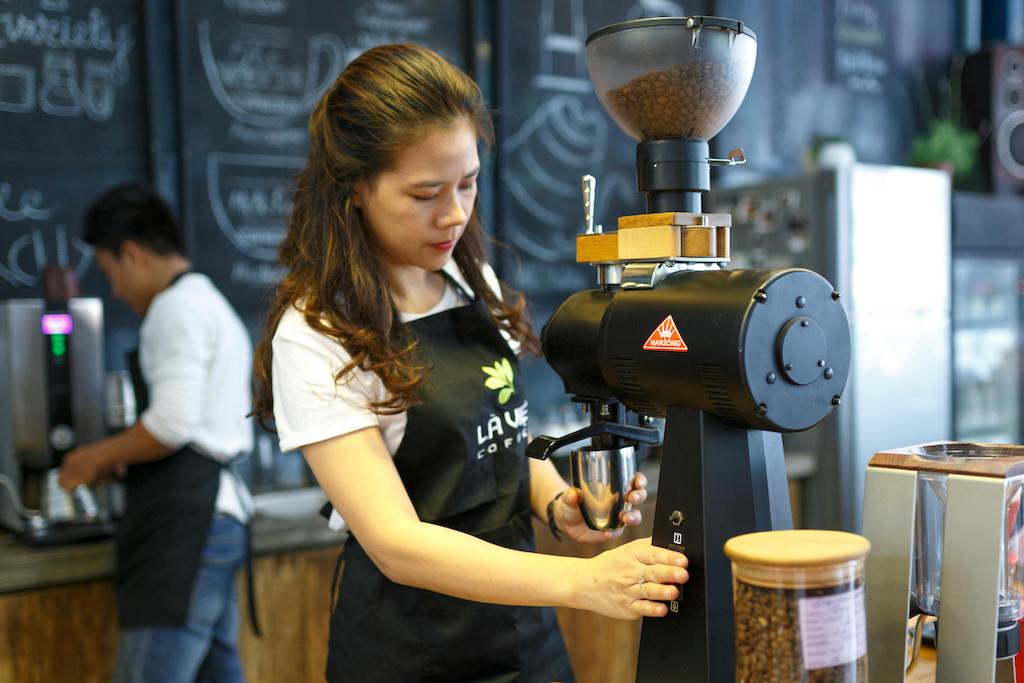
| Strengths | Weaknesses |
|---|---|
| One of the primary strengths of | 'Roast & Revel Coffee Shop' |
| Opportunities | Threats |
| The growing interest in specialty coffees and unique café experiences presents numerous opportunities for | The coffee shop |
Organizational Structure and Management
"Roast & Revel Coffee Shop" operates with a well-defined organizational structure designed to streamline operations, foster community, and ensure the delivery of top-quality service and products. At the core of our organizational structure is a flat hierarchy intended to promote open communication and collaboration among all team members.
The structure begins with the Owner/CEO at the top, setting the strategic direction and overall objectives for the business. Reporting directly to the Owner/CEO are four key positions: the General Manager, Head Barista, Marketing Manager, and Operations Manager. This structure ensures that each critical area of the shop's operations receives focused oversight and expertise.
The General Manager, Emily Clark, holds the central role in day-to-day operations. Emily's extensive background in the coffee industry, coupled with her business administration education, positions her perfectly to oversee shop operations, staff management, and customer satisfaction. Emily reports directly to the Owner/CEO and is pivotal in translating the business's strategic vision into operational success.
Jordan Lee, our Head Barista, brings a wealth of experience and creativity to the team. With several regional barista competition wins under their belt, Jordan leads the barista team, ensuring the quality of each cup served and innovating new offerings. Their role is crucial in maintaining our commitment to high-quality, artisan coffee.
Alexa Kim, the Marketing Manager, specializes in food and beverage marketing and social media engagement. Alexa's role involves developing and implementing marketing strategies to build brand awareness, promote community events, and manage social media channels and local SEO efforts. Their expertise is essential in attracting and retaining our target market segments.
Charlie Morgan, our Operations Manager, oversees the logistical aspects of the shop, including inventory management, supplier relations, and sustainability practices. With a degree in Hospitality Management and experience in coffee shop operations, Charlie ensures the smooth running of day-to-day operations and adherence to our sustainability commitments.
Looking forward, our staffing needs will evolve as the business grows. Initially, we'll require a team of baristas to support Jordan in the coffee-making process, alongside customer service representatives to enhance the customer experience. As we expand, possibilities for roles in product development, additional marketing support, and financial management will arise, reflecting our commitment to innovation, community engagement, and operational excellence.
Our human resources policies and practices are designed to create a supportive, inclusive work environment. We prioritize continuous training and professional development, recognizing and rewarding exceptional performance, and fostering a culture of respect and teamwork. We're committed to fair hiring practices, competitive compensation, and benefits that reflect our appreciation for our team's hard work and dedication.
To ensure we're operating at the forefront of the coffee industry and business best practices, we engage external advisors and consultants in areas such as sustainability, coffee sourcing, and financial planning. These experts provide valuable insights that help us refine our strategies and operations, ensuring we remain competitive and continue to meet our customers' high expectations.
In conclusion, "Roast & Revel Coffee Shop" is built on a foundation of strong leadership, a skilled and dedicated team, and a commitment to excellence in every cup and customer interaction. Our organizational structure and management practices reflect our dedication to quality, innovation, and community, steering us toward a bright future in the vibrant heart of Portland's coffee scene.
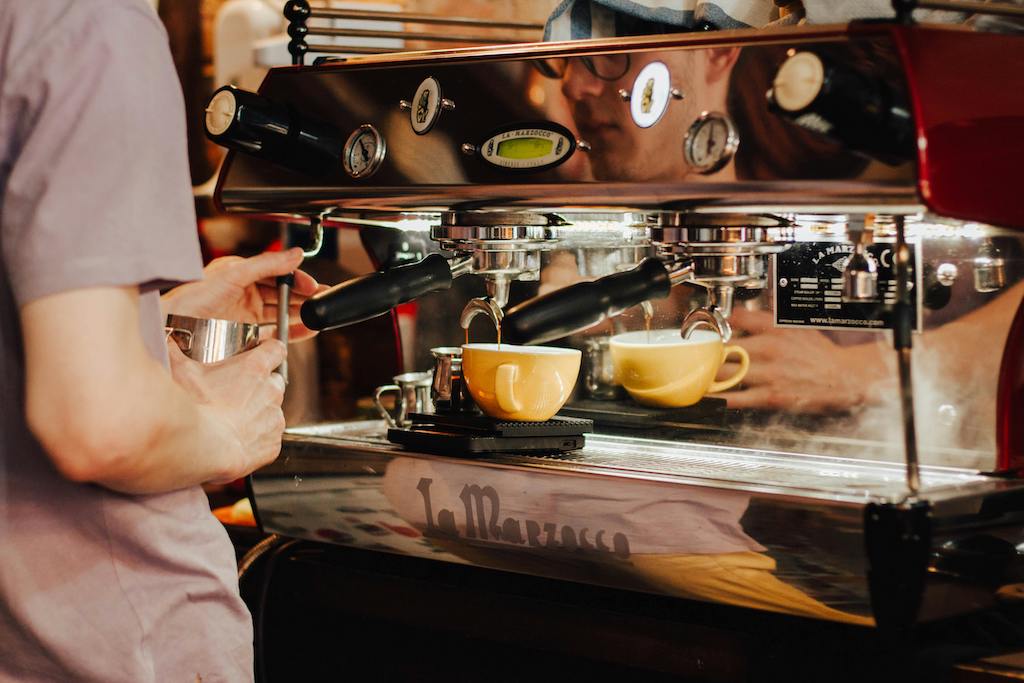
"Roast & Revel Coffee Shop" proudly offers a curated selection of high-quality, artisan coffee blends alongside an array of specialty teas, freshly baked pastries, and light meals. Our coffee offerings, including unique blends such as "Morning Zen Blend" , "Dark Roast Delight" , and "Caramel Swirl Indulgence," are at the heart of our menu. These are complemented by specialty teas and our bakery section, featuring items like the "Revel Berry Scone" and "Chocolate Espresso Muffin" , along with wholesome light meals such as "Artisan Avocado Toast" and "Roast Veggie Panini" .
Our unique selling points and competitive advantages lie in our commitment to quality, the uniqueness of our blend formulations, and our community-centric approach. The "Morning Zen Blend" offers a calm start to the day with its smooth, balanced flavors, while the "Dark Roast Delight" caters to those seeking a more robust coffee experience. The "Caramel Swirl Indulgence" is a testament to our innovative approach, blending premium coffee with the rich flavors of caramel for a truly indulgent beverage. Our beverages are further enhanced by our bakery and light meal offerings, which are prepared in-house using locally sourced, high-quality ingredients, ensuring freshness and promoting community sustainability.
Currently, "Roast & Revel Coffee Shop" is operational and continuously developing our product range. Future plans include expanding our menu to introduce seasonal blends and limited-time offerings to cater to a broader audience and keep the customer experience dynamic and exciting. Additionally, we aim to introduce a line of merchandise, including branded reusable cups and coffee brewing equipment, catering to our customers' growing interest in sustainable coffee consumption practices.
In terms of intellectual property, we are in the process of registering trademarks for our coffee blend names and the "Roast & Revel" brand. Protecting our unique blend formulations and brand identity is crucial as we establish ourselves in the competitive coffee industry. We consider our blend recipes and roasting techniques proprietary knowledge, giving us a competitive edge in crafting distinctive coffee experiences for our patrons.
Our production process centers around quality and consistency. Coffee beans for our blends are sourced from trusted local and international sustainable farms, ensuring not only the quality of our product but also adherence to ethical sourcing practices. We work closely with suppliers like "Bean Origins" for international beans and "Local Roast Farms" for locally sourced beans. These relationships ensure a steady supply of premium beans that meet our strict quality standards. All our coffee is roasted on-site, allowing us to control the roasting process meticulously and adjust profiles to achieve the ideal flavor notes for each blend.
Bakery items and light meals are prepared daily in our kitchen, utilizing fresh ingredients supplied by local producers. Our operations manager oversees the supply chain, ensuring all ingredients adhere to our quality and sustainability criteria. This direct oversight of the production process allows us to maintain high standards across our entire product range.
In conclusion, "Roast & Revel Coffee Shop" offers a compelling array of products and services, centered on quality, community, and sustainability. Our unique blend offerings, paired with our commitment to local sourcing and ethical practices, position us as a distinctive player in Portland's coffee scene. Through continuous product development and a focus on protecting our intellectual property, we aim to solidify our standing and contribute positively to the community we serve.
The marketing and sales strategy of "Roast & Revel Coffee Shop" is crafted to resonate with our target market of professionals aged 25-45, college students, and local residents in Portland, Oregon, who seek a premium coffee experience in a community-centric atmosphere. Our approach combines innovative marketing tactics, a customer-oriented sales strategy, competitive pricing, diverse distribution channels, and comprehensive promotion and advertising plans, all underpinned by our commitment to excellence in customer service.
Marketing Strategy: Our marketing strategy focuses on creating a strong brand presence both online and offline. Digitally, we will leverage social media platforms like Instagram, Facebook, and Twitter to engage with our audience through content that highlights our artisan coffee blends, specialty teas, freshly baked pastries, and light meals. We will also showcase our shop's cozy atmosphere, community events, and the sustainability practices that make us unique. Local SEO will be optimized to ensure "Roast & Revel Coffee Shop" appears prominently in local search results for coffee shops and cafes. Offline, we plan to participate in local community events and collaborate with nearby businesses to establish our brand within the community.
Sales Strategy: Our sales strategy emphasizes customer experience and retention. Staff, led by our Head Barista and informed by the General Manager, will be trained not only in coffee preparation but also in customer engagement and upselling techniques, aiming to transform each visit into a memorable experience. A loyalty program will be introduced to encourage repeat business, offering rewards such as discounts and exclusive access to monthly tasting events. Additionally, a subscription service for home delivery of our coffee blends will cater to those who wish to enjoy our products from the comfort of their homes.
Pricing Strategy: Pricing at "Roast & Revel Coffee Shop" is based on a value-based approach. Our prices will reflect the high quality of our offerings and the premium experience we provide while remaining competitive within the Portland coffee shop market. We aim to offer products at various price points to cater to a broad audience, from premium artisan coffees to more affordable daily delights, ensuring there is something for everyone.
Distribution Channels: Our primary sales channel will be our physical location in Portland, designed to provide a welcoming and engaging environment for customers. To extend our reach, we will also enable online ordering through our website for both pickup and local delivery. Plans for future expansion include exploring partnerships with online food delivery platforms to increase accessibility and convenience.
Promotion and Advertising Plans: Promotion and advertising efforts will focus on building brand awareness and driving foot traffic to the shop. We will deploy targeted social media ad campaigns and engage in email marketing to keep our subscribers informed about promotions, new arrivals, and upcoming events. Local press releases and participation in community events will also serve as opportunities to garner attention and attract new customers.
Customer Service Policies: Exceptional customer service is paramount at "Roast & Revel Coffee Shop" . Our policies are designed to ensure customer satisfaction, including a friendly and knowledgeable staff, a welcoming atmosphere, and prompt resolution of any issues. Feedback will be actively solicited through in-store and online channels, and used to continually refine our offerings and service. A return and refund policy for our subscription service and merchandise will be clearly communicated to ensure transparency and build trust.
Through this comprehensive marketing and sales strategy, "Roast & Revel Coffee Shop" aims to not only attract but also retain a loyal customer base, establishing itself as a staple of the Portland coffee scene and a beloved community hub.

The Operations Plan for "Roast & Revel Coffee Shop" outlines the foundational processes and strategies designed to ensure smooth daily operations, high-quality product delivery, efficient inventory management, and sustainable supply chain practices. This plan also details our facilities and equipment needs, cementing our commitment to providing a premium coffee experience in Portland, Oregon.
Operational Workflow:
Each day at "Roast & Revel" , operations commence with an early morning preparation session, where our team, led by the Head Barista, inspects, cleans, and primes all coffee machines and kitchen equipment. Fresh ingredients for our baked goods and light meals are received and inspected for quality. Our baristas then begin the coffee brewing process, emphasizing precision and consistency. Throughout the day, staff members rotate between brewing, serving customers, and managing the seating area to ensure a clean and welcoming environment. Closing procedures include thorough cleaning, restocking for the next day, and a brief team meeting to discuss the day's experiences and any customer feedback.
Production or Service Delivery Processes:
Our coffee is sourced from a meticulously curated selection of local and international sustainable farms. Upon arrival, beans are stored in a climate-controlled environment to maintain freshness. Roasting is conducted in-house, allowing us to adjust the profiles to achieve the desired flavor notes. Beverages are made to order, and pastries and meals are prepared daily, adhering to strict quality and safety standards. The service delivery process is streamlined to minimize wait times, with baristas trained in efficient preparation techniques and customer service.
Quality Control Measures:
Quality control at "Roast & Revel" is multilayered, involving regular checks at each production stage—from sourcing and storage to preparation and service. Beans are inspected and sampled upon delivery. We conduct daily calibration of equipment to ensure consistency in beverage preparation. Our Head Barista oversees a regular tasting program to maintain the highest beverage quality and train staff in flavor profile recognition. Customer feedback is actively sought and reviewed to identify any areas for improvement.
Inventory Management:
A robust inventory management system tracks stock levels of coffee beans, ingredients for food items, and other supplies. This system alerts the Operations Manager when stock reaches reordering thresholds, ensuring we never run low on essential items. We employ a first-in, first-out (FIFO) approach to use ingredients efficiently and reduce waste. Monthly inventory audits are conducted to identify trends and adjust stocking levels as necessary.
Supply Chain Management:
Our supply chain is managed with a focus on sustainability and ethical practices. We have developed strong relationships with a network of local and international suppliers who share our values. Regular evaluations ensure these suppliers continue to meet our standards for quality, reliability, and sustainability. Contracts are negotiated to secure competitive pricing while maintaining the flexibility to explore new products and innovations.
Facilities and Equipment Needs:
"Roast & Revel" operates from a centrally located premises in Portland, thoughtfully designed to create a cozy and inviting atmosphere. The facility is equipped with high-quality espresso machines, coffee grinders, baking ovens, refrigeration units, and other kitchen equipment necessary to deliver our product offerings efficiently. To support our in-house roasting process, we have invested in a state-of-the-art roasting machine. Regular maintenance schedules are enforced to ensure all equipment is in optimal working condition, supporting the elegance and efficiency of our operations.
In conclusion, the Operations Plan for "Roast & Revel Coffee Shop" is structured to ensure operational excellence, product quality, and customer satisfaction. Through meticulous planning and dedication to our core values, we aim to solidify our place as a pillar of the Portland coffee community.
The Financial Projections section of the "Roast & Revel Coffee Shop" business plan meticulously articulates our financial expectations over the next 3-5 years. By offering a detailed examination, including sales forecasts, profit and loss projections, cash flow estimates, balance sheet forecasts, and a break-even analysis, we provide a comprehensive outlook of our financial trajectory. Embedded within these projections are the financial assumptions and considerations that underpin our strategic decisions, tailored to navigate the vibrant and competitive landscape of Portland's coffee scene.
Sales Forecast:
Over the initial three years, "Roast & Revel" anticipates a consistent growth trajectory in sales revenue. Year one aims for $250,000, reflecting the establishment phase and brand penetration efforts. With strategic marketing and community engagement, year two targets a 32% increase, aiming for $330,000. By year three, incorporating expanded offerings and enhanced brand recognition, we project sales to climb to $410,000. These estimates are grounded in moderate growth assumptions, considering consumer behavior trends and competitive dynamics in Portland's coffee industry.
Profit and Loss Projection:
Our profit and loss projections align with our sales forecast, anticipating gradual growth in net profit margins from 10% in year one to 15% by year three. Initially, investments in branding, equipment, and facility setup will moderate net profits; however, efficiencies gained from operation scaling and customer base expansion will drive margin improvements. Operational expenses, including rent, utilities, payroll, and supplies, are carefully budgeted to ensure fiscal discipline while maintaining the premium quality and experience "Roast & Revel" is committed to delivering.
Cash Flow Projection:
Cash flow projections indicate a positive cash flow starting in the latter half of year one, as initial investments in setup and inventory are offset by incoming revenue streams. Proactive management of operating costs and strategic reinvestment of profits are planned to facilitate healthy cash flow, supporting both operational needs and future growth initiatives. Cash reserves will be maintained to hedge against unforeseen circumstances, ensuring business continuity even amidst market volatility.
Balance Sheet Projection:
The balance sheet for "Roast & Revel Coffee Shop" is expected to strengthen over the forecast period, with assets increasing as the business establishes its presence and builds equity. Liabilities, primarily comprising initial startup loans, are scheduled for repayment within the first three years, improving our equity position. Investments in equipment and facility improvements are capitalized, reflecting our commitment to long-term asset value.
Break-even Analysis:
Our break-even analysis reveals that "Roast & Revel" will reach the break-even point towards the end of year one. This calculation is based on fixed costs (rent, utilities, salaries) and variable costs (supplies, ingredients, marketing), set against projected sales revenue. Achieving this milestone within the first year underscores the viability of our business model and operational efficiency.
Financial Assumptions and Considerations:
The financial projections are built on a set of conservative assumptions: a steady growth in the coffee consumption trend, successful market penetration and brand loyalty build-up, and moderate economic conditions affecting discretionary spending. Additionally, we account for factors such as potential supply chain disruptions and price fluctuations in coffee beans. Considerations for future planning include exploring financing options for expansion, reinvestment in marketing strategies, and ongoing evaluation of product line profitability to adjust our offerings in response to market demands.
In conclusion, the financial projections for "Roast & Revel Coffee Shop" are not only a testament to our foresighted planning but also reflect a realistic and achievable roadmap. By anchoring our strategy in prudent financial management, quality focus, and community engagement, we are poised for sustainable growth and profitability in the dynamic Portland coffee shop market.
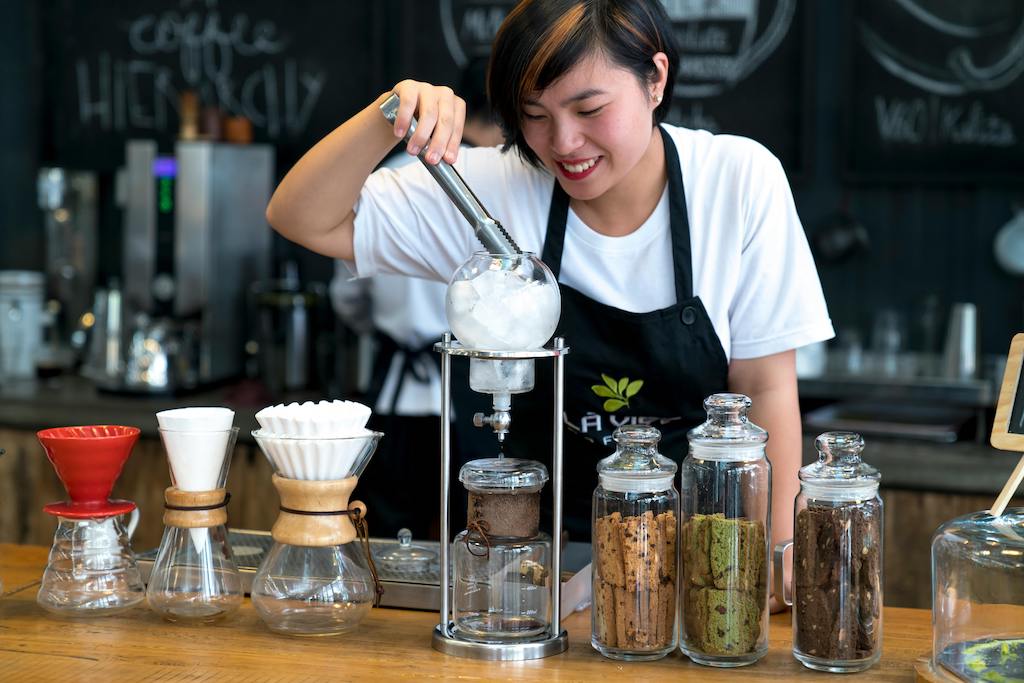
The success of "Roast & Revel Coffee Shop" in Portland's competitive market hinges not just on executing a well-thought-out business plan but also on our ability to anticipate, mitigate, and navigate potential risks. This Risk Analysis section delineates various risks that could impact our operations, financial health, and market position, alongside strategies to mitigate these risks and suitable contingency plans.
Market Risks:
One key market risk is the evolving consumer preferences towards coffee consumption. As trends fluctuate, so does the risk of our offerings becoming less appealing. Additionally, the competitive landscape poses a substantial risk, with new and existing players vying for market share.
- Mitigation Strategies: To counteract these risks, "Roast & Revel" plans to regularly engage with our customer base through feedback mechanisms and market research to stay ahead of trends. Diversifying our product offerings to include a wide range of options that cater to various customer preferences will also be vital. - Contingency Plan: Should market shifts significantly impact our core offerings, we are prepared to rapidly innovate our menu, introducing new products that align with emerging trends.
Operational Risks:
Operational challenges, including supply chain disruptions, staffing issues, and equipment malfunctions, can severely affect our day-to-day operations and, by extension, our revenue.
- Mitigation Strategies: Establishing relationships with multiple suppliers will guard against supply chain disruptions, while a structured training program ensures a pool of competent staff to mitigate dependency on any single employee. Regular maintenance schedules for equipment will help prevent unexpected breakdowns. - Contingency Plan: In the event of severe operational disruptions, our plan includes a financial buffer to cover short-term costs and agreements with local businesses for temporary supply arrangements.
Financial Risks:
Financial stability can be threatened by fluctuating operational costs, unexpected expenditures, and shifts in consumer spending due to economic downturns.
- Mitigation Strategies: Prudent financial management, including conservative budgeting and rigorous monitoring of expenditures, will be foundational. Additionally, building a diverse revenue stream, including subscriptions and online sales, can provide financial stability amidst fluctuations in in-store sales. - Contingency Plan: Access to a line of credit will serve as a financial cushion to manage cash flow challenges, and flexible pricing strategies can be employed to adjust to economic pressures affecting consumer spending.
Insurance and Legal Considerations:
Unforeseen events such as accidents on the premises, legal disputes, or natural disasters represent risks that could have significant legal and financial repercussions.
- Mitigation Strategies: Comprehensive insurance coverage, including general liability, property, and workers' compensation insurance, will form a protective layer against many of these risks. Regular legal audits and compliance checks will ensure adherence to industry regulations and local laws. - Contingency Plan: In case of significant legal or insurance claims, a specialized legal fund will be set aside, and relationships with legal counsel will be established to ensure efficient response to legal challenges.
In conclusion, while "Roast & Revel Coffee Shop" faces a range of potential risks across market, operational, and financial domains, our proactive approach in identifying these risks and implementing strategies to mitigate them positions us well to navigate uncertainties. Our contingency plans, alongside insurance and legal considerations, underscore our commitment to ensuring the long-term sustainability and success of our venture in Portland's vibrant coffee scene.

More business plan templates

Real estate development business plan
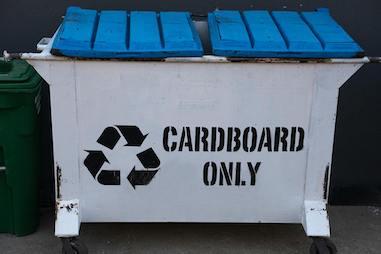
Junk removal business plan

Family entertainment center business plan
Coffee Shop Business Plan Template
Written by Dave Lavinsky
Business Plan Outline
- Coffee Shop Business Plan Home
- 1. Executive Summary
- 2. Company Overview
- 3. Industry Analysis
- 4. Customer Analysis
- 5. Competitive Analysis
- 6. Marketing Plan
- 7. Operations Plan
- 8. Management Team
- 9. Financial Plan
Coffee Shop Business Plan
Whether you are planning to start a new business or grow your existing coffee shop, you’ve come to the right place to create your coffee shop business plan.
We have helped over 100,000 entrepreneurs and business owners create business plans and many have used them to start or grow their coffee shops.
A coffee shop business plan is used to start and/or grow your business. Among other things, it outlines your business concept, identifies your target customers, presents your marketing plan and details your financial projections.
Sample Business Plan for a Cafe or Coffee Shop
Below are links to a sample of each of the key elements of a coffee shop business plan example:
- Executive Summary – The Executive Summary will provide an overview of your coffee shop business plan including highlights from each section.
- Company Overview – The Company Overview section provides a brief business description and history of your coffee business, as well as your business model, retail space location, and mission statement.
- Industry Analysis – The Industry Analysis leverages market research to provide an overview of the coffee industry, including trends, growth potential, and competition in the coffee market.
- Customer Analysis – The Customer Analysis section provides insights into the segments of your target market (i.e., business professionals, college students, etc.), including their needs and preferences, as well as how you plan to attract and retain them.
- Competitive Analysis – The Competitive Analysis section provides an opportunity for you to research other coffee shops in your area and identify their strengths and weaknesses. You will also detail your unique selling proposition (i.e., high-quality coffee, specialty coffees, welcoming atmosphere, etc.) for attracting new and repeat customers.
- Marketing Plan – The Marketing Plan offers a detailed marketing strategy for promoting your coffee shop to attract and retain customers, including advertising and social media marketing. It will also include your pricing structure for your products.
- Operations Plan – The Operations Plan includes information on the daily operations of your coffee shop, such as staffing, inventory management, and equipment.
- Management Team – The Management Team section introduces the key players in your coffee shop, their roles and responsibilities, and their relevant skills and experience.
- Financial Plan – The Financial Plan will provide detailed projections for the financial performance of your coffee shop, including startup costs, operating costs, revenue, and expenses. This section should include an income statement, balance sheet and cash flow statement.
Next Section: Executive Summary >
Coffee Shop Business Plan FAQs
What is a coffee shop business plan.
A coffee shop business plan is a plan to start and/or grow your business. Among other things, it includes your company overview, allows you to conduct a market analysis to identify your target market, includes a sample menu, presents your marketing plan and pricing strategy to attract your local customer base, details your sales forecasts, and provides the income statement, balance sheet and cash flow statement for your coffee shop.
You can easily complete your coffee shop business plan using our Business Plan Template for a Coffee Shop here .
What Are the Main Types of Coffee Shops?
The different types of coffee shops include cafes, coffee bars and coffeehouses that sell coffee drinks and other snacks. Some coffee shops offer lunch and dinner menus and are close to being full-service restaurants. There are also coffee shops that are more accessible for people on the go or those who want to make their own coffee. These are retail coffee shops, drive thru coffee shops, coffee carts and trucks, and roasters or retailers.
What Are the Main Sources of Revenue and Operating Expenses for a Coffee Shop?
The primary source of revenue for many coffee shops come from its food and drink sales, which includes brewed coffee, coffee beans, seasonal drinks and refreshments, and baked goods. Gift card and merchandise sales like tumblers, mugs, and coffee makers also contribute to a coffee shop’s revenue stream.
The expected expenses for a coffee shop are the cost of coffee and food products, salaries and wages, rent, and advertising costs.
How Much Does it Cost to Start a Coffee Shop?
Opening a coffee shop business can cost anywhere from $40,000 to $100,000 depending on the size and location of the business. Additional costs such as inventory, employee salaries, and marketing expenses can range from $5,000 to $15,000 per month.
How Do You Get Funding for Your Coffee Shop Business?
The best way to get funding for a coffee shop business is through a bank loan or utilizing your personal savings, business credit cards or borrowing from friends and family. You can also look into government grants or loans, or try to find a partner who is willing to invest in your business. Whatever route you choose, be sure to have a solid coffee shop business plan for potential investors including a sales and marketing plan as well as a realistic idea of how much money you need to get started.
How to Start a Coffee Shop?
- Determine the type of coffee shop business you want to open . There are many different types of coffee shops, from small mom-and-pop shops to large chains.
- Create a coffee shop business plan. This will outline your plans for starting and running your coffee shop.
- Secure funding . You will need money to start and run a coffee shop, so you'll need to find investors or borrow money from a bank or other lending institution.
- Find a location for your coffee shop. This can be tricky, as you'll need to find a space that is affordable and has good foot traffic.
- Equip your coffee shop . You'll need to buy or lease equipment such as espresso machines, coffee brewers, and furniture in addition to the coffee beans and other food products you plan to sell.
- Hire staff . You'll need employees to run your coffee shop, so post job ads and interview potential candidates.
Learn more about how to start a successful coffee shop business:
- How to Start a Coffee Shop Business
Where Can I Get a Coffee Shop Business Plan PDF?
You can download our free coffee shop business plan template PDF . This free coffee shop business plan template can be used to write your own business plan.
Coffee Shop Business Plan Template
Are you dreaming of opening your own coffee shop but don't know where to start? Look no further! Our free coffee shop business plan template is the perfect tool to help you get started. This comprehensive guide will walk you through the process of creating a solid business plan that will set you up for success. With our customizable template, you'll be able to tailor your plan to your unique vision and goals, so you can confidently launch your coffee shop with the right foundation in place.

Get the free business plan template here!
If you're looking to start a coffee shop and need a plan to get started, you're in the right place. This free business plan template is designed to help you create a comprehensive plan for your coffee shop that will guide you through the process of starting and growing your business.
Starting a coffee shop can be an exciting and rewarding venture, but it can also be challenging. With so many details to consider, it's easy to get overwhelmed. That's why a solid business plan is crucial for success. It will help you clarify your vision, outline your goals, and create a roadmap for achieving them.
Our coffee shop business plan template is designed to be easy to use, even if you have no previous business ownership experience. It includes all the sections you need to create a comprehensive plan, including:
- Executive summary: This section provides an overview of your coffee shop, including your mission statement, products or services, target market, and financial goals.
- Company description: This section provides more detailed information about your business, including its legal structure, ownership, and management team.
- Market analysis: This section analyzes your target market and the competition in your industry. It includes information about your ideal customer, your competitors, and the overall market size and trends.
- Products: This section outlines your coffee shop products, including any unique spin on them, and what impact you expect them to have.
- Sales and marketing plan: This section outlines how you plan to reach and sell to your target market. It includes your pricing strategy and promotional tactics.
- Financial projections: In this section we provide real examples of real coffee shop financial projections that show you exactly what you should include about your financial projections in your business plan.
- Funding request: If you need funding to start or grow your business, this section will help you outline your funding needs and present your plan to potential investors or lenders.
Our coffee shop business plan template is completely customizable to fit your specific needs. You can add or remove sections as needed, and fill in the details that are most important to your business. The template includes helpful tips and guidance throughout, as well as examples of completed sections to help you get started.
To access the free coffee shop business plan template, simply enter your email address and name in the form provided. You will receive a link to download the template.
With this free coffee shop business plan template, you will have the tools you need to create a comprehensive plan for your shop. Whether you're just getting started or looking to take your business to the next level, a solid plan is the key to success. Get started today
Coffee Shop Business Plan Outline
I. Executive Summary
- Brief overview of the business idea, target market, and goals
II. Market Analysis
- Description of the coffee market, including trends and competitors
- Analysis of target customer demographics and their coffee habits
III. Business Concept
- Description of the coffee shop's unique selling proposition and concept
- Details of the menu offerings and any special features or services
IV. Marketing Strategy
- Overview of marketing and advertising efforts, including social media, promotions, and local events
- Analysis of pricing strategy and how it will attract customers
V. Operations Plan
- Description of the day-to-day operations, including staffing, scheduling, and inventory management
- Discussion of any technology or equipment needs and how they will be procured
VI. Financial Plan
- Projections for start-up costs, ongoing expenses, and revenue
- Breakdown of funding sources, such as loans or investments
- Discussion of the target profitability and growth potential for the business
VII. Management Team
- Brief descriptions of key management members and their experience
- Discussion of any partnerships or strategic relationships
VIII. Conclusion
- Summary of key points and future plans for the business
Coffee Shop Business Plan Frequently Asked Questions
Q: why do i need a coffee shop business plan.
A coffee shop business plan is a roadmap for your business. It helps you identify your target market, competitive landscape, and financial projections. By creating a business plan, you can gain a better understanding of your business and increase your chances of success.
Q: What should be included in a coffee shop business plan?
A coffee shop business plan should include an executive summary, company description, market analysis, product line, sales and marketing plan, financial projections, and funding request. Each of these sections should be tailored to your specific coffee shop.
Q: How long should a coffee shop business plan be?
A coffee shop business plan can vary in length, but it should typically be between 25 and 35 pages. It's important to include all the necessary details, but not to overwhelm the reader with too much information.
Q: Do I need to hire a professional to write my coffee shop business plan?
While it's not necessary to hire a professional to write your coffee shop business plan, it can be helpful if you're not experienced in creating business plans. You can also use templates and online resources to guide you through the process.
We Know a Good Business Plan When we See One
Collectively, our team has reviewed thousands of business plans and has nearly 20 years of experience making SBA loans. We've also helped more than 50,000 businesses create financial projections across many industries and geographies.

Adam served as Executive Director for a SBA microlender in Indiana for over 10 years helping businesses and reviewing thousands of business plans.
.png)
Grace has built hundreds of custom financial models for businesses as well as our projection templates which are used by thousands of businesses every year.

Kyle served as an SBA loan officer for 7 years working directly with startups and business owners to review their business plans, projections, and prepare their loan package.
Lorem ipsum dolor sit amet, consectetur adipiscing elit.
BUSINESS STRATEGIES
How to write a coffee shop business plan
- Nirit Braun
- Oct 30, 2023
- 12 min read

A coffee shop business plan is a detailed and strategic document outlining the essential aspects of starting and operating a coffee-focused business. It encompasses a comprehensive analysis of the business's goals, target audience, competitive landscape, marketing strategies, financial projections, operational procedures and more. This plan acts as a roadmap that guides entrepreneurs through the various stages of establishing and running their coffee shop, providing clear direction and a solid foundation for success.
When starting a business, especially in the competitive and dynamic realm of the coffee industry, creating a comprehensive and clear business plan is of paramount importance.
Ready to get your business brewing? Take Wix’s website builder for a whirl.
Top benefits of creating a coffee shop business plan
A well-crafted business plan helps entrepreneurs articulate their business goals, whether it's about offering unique coffee blends, creating a cozy ambiance or supporting sustainable sourcing practices. At the same time, a business plan requires entrepreneurs to identify and understand their target audience. This insight helps tailor marketing strategies, menu offerings and the overall customer experience to meet the specific preferences and needs of the intended customers.
Here's an overview of some key advantages to creating a coffee shop business plan:
Attracting investors and funding: A well-structured business plan acts as a persuasive tool when seeking investors or raising money for your business . It showcases your thorough understanding of the coffee industry, market trends and your strategies for success. This level of preparedness increases your credibility and instills confidence in potential investors, making them more likely to support your coffee shop venture.
Clear resource requirements: Writing a business plan prompts you to identify the specific resources, supplies and staff necessary to launch and operate your coffee shop. This includes everything from coffee beans and brewing equipment to furniture and interior decor.
Strategic financial planning: A comprehensive business plan outlines your financial projections, startup costs, operating expenses and revenue forecasts. This level of financial planning helps you determine how much funding you need to start a business . It also guides you in setting prices, managing cash flow and assessing profitability.
Market understanding and differentiation: Through market research and analysis, a business plan allows you to understand your target audience's preferences, behaviors and expectations. This knowledge helps you tailor your coffee shop's offerings, ambiance and marketing strategies to effectively attract and retain customers.
Risk mitigation: The process of creating a business plan prompts you to identify potential risks and challenges that your coffee shop might face. By acknowledging and addressing these risks early on, you can develop contingency plans and strategies to mitigate their impact.
Operational efficiency: A business plan outlines the operational processes required to run your coffee shop smoothly. It includes staffing plans, inventory management strategies and quality control measures. By establishing efficient procedures from the outset, you can minimize wastage, optimize resource allocation and ensure consistent customer satisfaction.
Goal setting and tracking: Your business plan serves as a benchmark against which you can measure your coffee shop's performance over time. By setting clear goals and key performance indicators (KPIs), you can track your progress and make necessary adjustments to stay on course toward achieving your objectives.
How to create a coffee shop business plan in 6 steps
Now we’ll walk through the six essential steps for crafting a coffee shop business plan tailored to your company's unique needs.
Executive summary
Business and domain names
Market analysis and research
Operations plan
Marketing and advertising plan
Financial plan
01. Executive summary
Your executive summary is a concise and compelling overview of your coffee shop business plan. It encapsulates the key elements of your plan and provides a snapshot of your business concept, strategies and financial projections. While appearing at the start of the business plan, it's often written last, as it draws from the content of the entire document.
A clear executive summary for a coffee shop business should include:
The essence of your coffee shop: What makes it unique? What kind of experience will customers have when visiting your establishment?
Market potential and your target audience: Explain why your coffee shop is well-positioned to capture this opportunity.
Competitor landscape: Identify what sets your coffee shop apart from the competition. This could be your specialty coffee blends, unique ambiance, sustainable practices or exceptional customer service.
Example executive summary for a coffee shop: "Bean Haven Coffee is a meticulously crafted coffee shop that aims to provide not just beverages, but an immersive coffee experience. We pride ourselves on our curated selection of ethically sourced beans, offering customers the finest hand-crafted brews in a cozy, rustic ambiance. Our competitive edge lies in our commitment to sustainability, from our bean-sourcing practices to our eco-friendly packaging. With a strong emphasis on community engagement and partnerships with local artists, we are set to become a cultural hub that brings people together over a shared love for exceptional coffee. Through strategic marketing campaigns, leveraging social media and collaborating with nearby businesses, we aim to establish Bean Haven Coffee as the go-to destination for coffee enthusiasts and connoisseurs alike. Our projected financials indicate that we will reach profitability within the first 18 months of operation. We seek funding to cover initial startup costs and our business model is designed to achieve sustainable growth and profitability."
02. Company and domain names
Knowing how to name a business is crucial for a coffee shop venture and a key step before you register your business . A strong and memorable name can resonate with customers and differentiate your coffee shop from competitors. Use descriptive words that reflect your coffee shop's essence, whether it's about taste, ambiance or values.
Utilizing a business name generator like the one from Wix can provide inspiration and spark creativity. Play with different combinations of words and ideas until you find a name that feels right. Once you've settled on a name, check its availability for domain registration. A domain name that matches your company name is essential for an effective online presence.
When choosing a domain name consider the following best practices:
Ensure that the domain name reflects your coffee shop's identity and offerings
Choose a name that is easy to spell and remember
Opt for a timeless name that won't become outdated quickly
If possible, include relevant keywords in the domain to improve search engine visibility
Steer clear of names that are easily confused with competitors or other brands
03. Market analysis and research
With more than 38,000 coffee shops in the U.S. alone, there are plenty of competitors to analyze. Including a comprehensive market analysis in your business plan is essential for understanding the competitive landscape and formulating effective strategies. Research your local coffee market, identify existing competitors and analyze their strengths and weaknesses. Determine your target audience's preferences, behaviors and demographics to tailor your offerings and marketing campaigns accordingly.
A well-rounded market analysis can guide your business strategy, helping you position your coffee shop effectively, develop compelling value propositions and devise strategies to capture your desired market share.
04. Operations plan
The operations plan is a crucial section of your coffee shop business plan. It outlines the practical aspects of running your coffee shop. Use it to describe your chosen location and its significance for foot traffic, accessibility and target audience reach.
Then, take the opportunity to detail the interior design, layout and ambiance of your coffee shop to create a welcoming atmosphere. Next be sure to list the equipment needed for brewing, food preparation and service. Ensure it aligns with your menu and production capacity. Finally define the roles and responsibilities of your staff, from baristas to managers, and outline their qualifications and training needs.
05. Marketing and advertising strategies
The marketing and advertising portion of your business plan outlines your strategies for promoting your coffee shop and attracting customers. Depending on your target audience and brand positioning for this type of business , consider a mix of traditional and digital marketing methods. This means using social media platforms like Instagram, Facebook and Twitter to showcase your coffee creations, engage with customers and share your coffee shop's story. Collaborate with influencers, local organizations or other businesses to expand your reach and tap into new customer segments.
Additionally, you can choose to participate in community events, farmers' markets and collaborations with other local businesses to increase your visibility. Also consider implementing loyalty programs that reward repeat customers and incentivize them to visit regularly.
You’ll need to develop a suite of brand assets to use in your marketing as well, starting with a company logo. You can use a free logo maker to get a professional design in minutes.
Learn more: How to make a website
06. Financial plan
The cost to start a coffee shop business can range from $50,000 for a mobile operation to over $400,000 for a brick-and-mortar location with booth seating and a drive-thru. This hefty expense is just another reason why a financial plan is so important.
The financial plan is the backbone of your coffee shop business plan. It outlines your startup costs, operating expenses, revenue projections and funding strategy. Investors and lenders will closely scrutinize this section to assess the viability of your coffee shop venture, so remember to do the following:
Detail the initial investment required for equipment, interior design, licenses and permits
Estimate ongoing costs such as rent, utilities, supplies and salaries
Provide realistic revenue forecasts based on your expected capacity and customer traffic
Specify how you plan to secure funding
Highlight when you anticipate reaching profitability and generating positive cash flow
By meticulously planning your finances, you demonstrate a solid understanding of the financial aspects of your coffee shop business and showcase its potential for success.

Coffee shop business plan examples
Below we’ve put together business plan templates for two hypothetical coffee shop businesses, including all the sections discussed in our previous how-to steps.
Coffee shop business plan template 1: Coffee Haven Café
Coffee Haven Café is a charming coffee shop dedicated to delivering a premium coffee experience in a cozy and inviting setting. Our unique blends, ethically sourced beans and commitment to sustainability set us apart in a competitive market. By fostering community engagement and partnering with local artists, we aim to become a cultural hub that brings people together over exceptional coffee. Through strategic marketing efforts and a strong online presence, we project profitability within 18 months.
Company and domain name
Company name: Coffee Haven Café
Domain name: www.coffeehavencafe.com
Our marketing analysis revealed a growing demand for specialty coffee in our target location. We've identified key competitors and highlighted their strengths and weaknesses. Our target audience consists of young professionals and students who value quality and ambiance. By understanding these dynamics, we can tailor our offerings and marketing strategies effectively.
Location: Centrally located in a busy commercial area with high foot traffic
Premises: Rustic and inviting interior design that promotes relaxation and conversation
Equipment: High-quality espresso machines, grinders, brewing equipment and display cases for baked goods
Staffing: Experienced baristas, friendly waitstaff and a dedicated manager to oversee operations
Social media: Engage customers through Instagram, Facebook and X with enticing coffee shots and behind-the-scenes content
Local events: Participate in local festivals, art exhibitions and collaborate with nearby businesses for cross-promotions
Content marketing: Regular blog posts on coffee trends, brewing tips and spotlight features on local artists
Loyalty programs: Offer a loyalty card program with rewards for frequent visitors
Partnerships: Collaborate with nearby bookstores for reading sessions and local influencers for social media endorsements
Startup costs: $70,000 for equipment, furnishings, licenses and initial inventory
Operating expenses: Estimated monthly costs of $12,000 covering rent, utilities, supplies and staff salaries
Revenue projections: Projected revenue of $300,000 in the first year, growing to $450,000 in the second year
Funding strategy: Initial funding from personal savings and a small business loan from a local bank
Profitability timeline: Aim to achieve profitability within 18 months of operation
Coffee shop business plan template 2: Brew & Gather Coffee House
Brew & Gather Coffee House is a community-focused coffee shop aiming to create a warm and inclusive space for coffee enthusiasts. Our commitment to locally sourced ingredients and artisanal brewing techniques sets us apart. By fostering partnerships with neighboring businesses and hosting regular events, we aim to become a staple in the neighborhood. Our projected financials indicate profitability within the first two years.
Company name: Brew & Gather Coffee House
Domain name: www.brewandgathercoffee.com
Through extensive market research, we've identified an opportunity to serve a diverse community seeking an authentic and welcoming coffee experience. We've assessed competitors' offerings and identified an untapped niche. Understanding our target audience's preferences and values will guide our menu and marketing strategies.
Location: Situated near a local park, providing an oasis for relaxation and community gatherings
Premises: Modern yet cozy interior design with flexible seating arrangements to accommodate groups and individuals
Equipment: State-of-the-art espresso machines, pour-over stations and an open bakery display
Staffing: A blend of skilled baristas, friendly hosts and a community engagement coordinator
Social media: Utilize Instagram and TikTok to showcase brewing techniques, share customer stories and host virtual coffee-tasting sessions.
Local events: Host open mic nights, book clubs and workshops to engage the community.
Content marketing: Publish a monthly newsletter featuring coffee culture insights, staff spotlights and local partnerships.
Loyalty programs: Introduce a tiered membership program offering exclusive discounts and early access to events.
Partnerships: Collaborate with local farmers, artisans and musicians to create a truly immersive community experience.
Startup costs: $100,000 for leasehold improvements, equipment, permits and initial inventory
Operating expenses: Projected monthly expenses of $15,000, covering rent, utilities, wages and supplies
Revenue projections: Anticipate revenue of $350,000 in the first year, with a 15% increase in the second year
Funding strategy: Initial investment from personal savings and a crowdfunding campaign targeting the local community
Profitability timeline: Aim to reach profitability within the first two years of operation
How profitable is a coffee shop?
The profitability of a coffee shop can vary depending on a number of factors, including location, business model and marketing strategy. However, in general, coffee shops can be quite profitable.
According to a report by IBISWorld, the average profit margin for coffee shops is 8.33%. This means that for every $100 in revenue, coffee shops generate $8.33 in profit.
Some coffee shops are even more profitable. For example, coffee shops located in high-traffic areas, such as airports and office buildings, can generate profit margins of up to 15%. And coffee shops that sell specialty coffee drinks and food items can also generate higher profit margins.
Here are some tips for increasing the profitability of your coffee shop:
Choose a good location. A good location is essential for success. Look for a location that is convenient for potential customers and has high visibility.
Offer a unique selling proposition. What makes your coffee shop different from others? What can you offer that your competitors cannot?
Provide excellent customer service. This is essential for building a loyal customer base. Make sure your staff is friendly and knowledgeable, and that they are always willing to go the extra mile for your customers.
Market your coffee shop effectively. Let potential customers know about your coffee shop and the unique offerings you have. You can do this through online marketing, social media and word-of-mouth.
Control your costs. Coffee shops have high costs, so it's important to control your costs as much as possible. This means negotiating good deals with your suppliers, managing your inventory carefully and keeping your labor costs under control.
Why do coffee shops fail?
There are a number of reasons why coffee shops fail. Some of the most common reasons include:
Poor location: A coffee shop in a bad location won't attract enough customers to be successful. Coffee shops need to be located in areas with high foot traffic, such as near office buildings, universities and parks.
High overhead costs: Coffee shops have high overhead costs, such as rent, utilities and labor. If a coffee shop can't generate enough revenue to cover its overhead costs, it will eventually fail.
Poor management: Poor management can lead to a number of problems, such as low customer satisfaction, high employee turnover and financial difficulties. Coffee shop owners need to have a strong business plan and be able to manage their finances effectively.
Lack of marketing: Coffee shops need to market themselves effectively to attract new customers and keep existing customers coming back. Coffee shop owners need to develop a marketing plan and budget, and they need to track their results to see what is working and what is not.
Competition: The coffee shop industry is very competitive. Coffee shops need to offer something unique to stand out from the competition.
Coffee shop business plan FAQ
How do you start a coffee shop business plan.
To start a coffee shop business plan, you need to consider the following factors:
Location: Choose a location that is convenient for potential customers and has high visibility.
Target market: Identify your target market and tailor your business plan to their needs and preferences.
Menu: Develop a menu that includes a variety of coffee drinks and food items that will appeal to your target market.
Pricing: Set prices that are competitive and generate a sufficient profit margin.
Operating costs: Estimate your operating costs, such as rent, utilities, labor and inventory.
Marketing: Develop a marketing plan to reach your target market and generate awareness of your coffee shop.
How many cups of coffee does a coffee shop sell per day?
Is a small coffee shop profitable, what percentage of coffee shops are successful, want to cook up another business plan.
How to create a bakery business plan
How to create a bar business plan
How to create a virtual assistant business plan
How to create an eCommerce business plan
How to create a cleaning business plan
How to create a plumbing business plan
How to create a trucking business plan
How to create a daycare business plan
How to create a food truck business plan
How to create a restaurant business plan
How to create a clothing line business plan
How to create a hair salon business plan
How to create a real estate business plan
How to create a contractor business plan
How to create a vending machine business plan
How to create a party planning business plan
Looking for another business idea?
How to start an online business
How to start a consulting business
How to start a fitness business
How to start a fitness clothing line
How to start a makeup line
How to start a candle business
How to start a clothing business
How to start an online boutique
How to start a T-shirt business
How to start a jewelry business
How to start a subscription box business
How to start a beauty business
How to start a flower business
How to start a car wash business
How to start a food prep business
How to start a DJ business
How to start a pool cleaning business
How to start a baking business
How to start a trucking business
How to start a construction business
How to start a landscaping business
How to start a food business
How to start a vending machine business
How to start a contractor business
How to start a coaching business
Coffee dropshipping
Looking to start a business in a specific state?
How to start a business in Arizona
How to start a business in South Carolina
How to start a business in Virginia
How to start a business in Michigan
How to start a business in California
How to start a business in Florida
How to start a business in Texas
How to start a business in Wisconsin
Related Posts
How to create a website from scratch in 11 steps (for beginners)
How to start a business in 14 steps: a guide for 2024
How to start a coffee shop in 7 steps
Was this article helpful?
- Try it out »
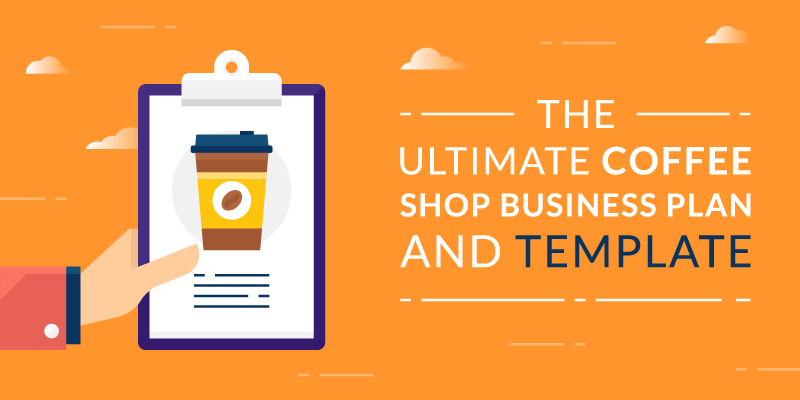
The Ultimate Coffee Shop Business Plan and Template

If you are looking to write a coffee shop business plan, you have come to the right place.
A coffee shop business plan is an essential tool for coffee shop owners or people who want to open a coffee shop. A business plan will help you plan your strategy for success and act as a guide as you look to build your coffee shop.
In this article, we’ll look at why you should write a business plan for your coffee shop or cafe, as well as provide you with a sample and a template that contains inspiration for the things you should include in your coffee shop business plan.
Table of Contents
- 1 Why Write a Coffee Shop Business Plan?
- 2.1 Executive Summary
- 2.2 Company Overview
- 2.3 Market and Customer Analysis
- 2.4 Sales and Marketing Plan
- 2.5 Management Team
- 2.6 Financial Plan
- 3 Wrapping Up
Why Write a Coffee Shop Business Plan?

The basic idea behind a coffee shop is simple. The business needs to sell enough coffee products to cover costs and make a profit. However, many variables will define whether your business is successful.
A coffee shop business plan will help you plan a strategy for success. It will consider factors such as opportunities, risks, and how you will market yourself . By having a good idea of this before you start a coffee shop, you will be better placed to overcome or avoid any difficulties.
Here are some examples of how a business plan could help iron out any difficulties:
- While creating the market analysis section, you may decide that competition is too intense. If this is the case, you could look for a new area with fewer competitors or find a way to make your coffee shop business stand out.
- By creating a marketing plan before you open, you can put yourself in an excellent position to make sales from the moment you start a coffee shop.
- By creating cash flow projections, you will be able to spot any potential financial issues well before they come to light, preventing cash flow problems.
Without a business plan, you would either not know about the potential difficulties listed above, or you would be aware of them but lacking any defined strategy for overcoming them. By creating a coffee shop business plan, you can tackle issues with a clearer head.
Business plans are also essential documents if you plan to apply for funding for your coffee shop.
You’ll likely need to submit the business plan to the bank when applying for a loan, or to investors when applying for equity funding. Having a well-thought-out business plan shows you have done your market research and analyzed your idea which helps give investors an overview of the risks and potential rewards of investing.
If you are going to use your business plan to apply for funding, you’ll need to go into a little more detail about the financials of your business. This will include your income and expenses and you’ll also need to include a section that discusses how you will use the money you’re raising.
Coffee Shop Business Plan Template
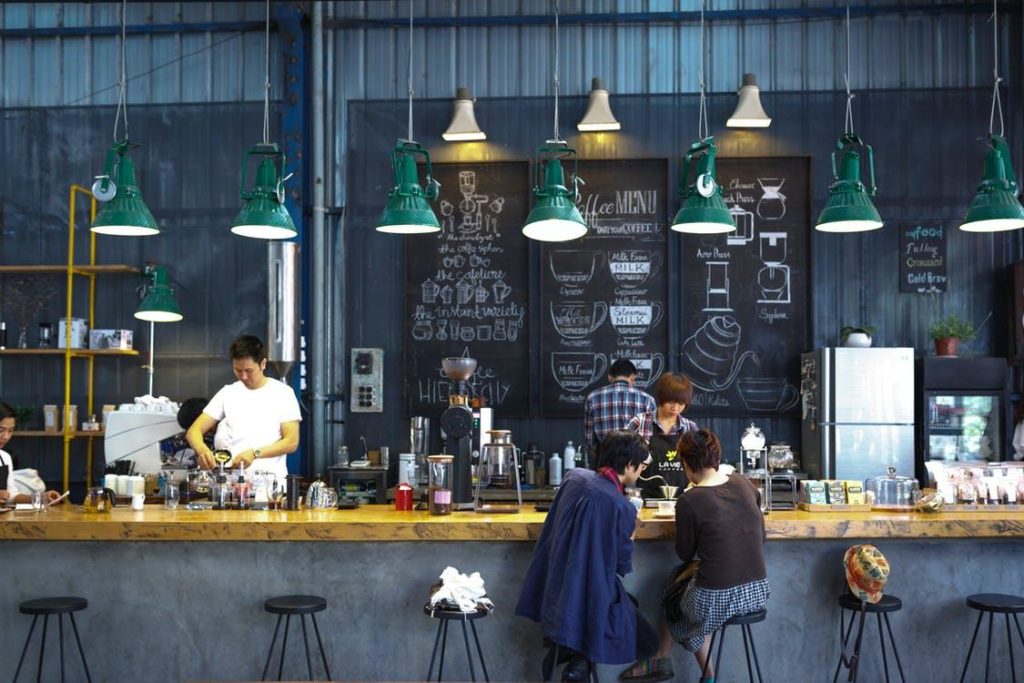
A Google search will reveal differences when it comes to the exact sections you should include in your coffee shop business plan.
Nonetheless, a coffee shop business plan template will include the sections listed below. In this part of the article, we’ll go through a coffee shop business plan template and discuss what you should include in each section.
Executive Summary
The executive summary is a short overview of your coffee shop business plan. It should include all the important details about your business. When deciding what to include, think about what you would want someone to see if they told you they would only read this one section of your plan.
Open your executive summary with a statement about what your coffee shop business is all about. Talk about what it will offer that is unique and mention why you think it will be successful. Is it the only coffee house in town, for example?
Coffee shop name: AI Coffee Shop
Executive Summary:
AI Coffee will serve high-quality coffee to office workers and business people who work nearby. We will sell espresso-based drinks with a focus on providing quality at speed. We will sell coffee to take away as well as to eat in, with an indoor seating area with space for 25 customers in our coffee shop.
While there are other coffee shops in the area, we believe that there is demand for more — especially ones that focus on a high-quality product. We will also provide a light lunch menu and pastries that we believe will differentiate us from other coffee shops in the area.
Company Overview

In the company overview section, you should include practical details about your coffee shop business. This will include:
- The structure and ownership of your coffee shop
- The staff you plan to hire and what you will pay them
- Your company’s mission statement, and startup expenses
While this may seem like a lot of work, the good news is this also serves as a way to kill two birds with one stone. As you flesh out your company’s goals & vision statements, it’s important to track this information in an internal wiki . Not only will this help your business stay true to its course, but it can also serve as a great resource for your staff.
AI Coffee will be a privately held company owned entirely by Mr Smith, who will also manage the coffee shop. We will hire two full-time employees with at least two years of barista experience, as well as four part-time employees to help during busy periods.
Startup costs for the coffee shop will be $70,000, which will be spent on rent, renovations, and purchasing equipment. The owner has put up half the money and has borrowed half from a bank. Based on annual sales of $160,000 and after costs and wages, we expect to be profitable within the second year.
Market and Customer Analysis
In the market analysis section, you should include details about the local market. This can include information on competitors, such as other coffee shops or any fast-food joints, restaurants, or bars that you think will be competing for your coffee shop’s money.
You should also outline what makes your coffee shop business unique and why you think it can be successful despite the competition. You can also include wider information about the coffee industry.
In the customer analysis section, you need to include information about your target market. Include details on who they are and why you think they will like your coffee shop, with metrics where possible. If you performed market research before starting your coffee shop business plan, include that here.
Market Analysis
The coffee industry is expected to keep growing between 2020 and 2024 in the U.S. Research suggests that coffee is one of the most consumed beverages in the country, with the average person drinking two cups per day. We believe that this growth, plus the high volume of coffee people drink each day, makes opening a coffee shop a good business opportunity .
Competitor Analysis
AI Coffee will be located in a vibrant district that is seeing offices open up and new companies move in. There are currently two other coffee shop competitors in the immediate area, but we believe there is room for more.
Our shop’s main advantages are that it is closer to a new office building than the other shops. We also plan to differentiate ourselves by offering a small lunch menu, unlike any of the existing coffee shops, as well as various customer loyalty schemes .
Customer Analysis
The location of the coffee shop has high footfall, especially before and after work and during lunchtimes. The area has a high proportion of local professionals who can afford to spend money on coffee and other drinks.
The office blocks in the immediate vicinity are home to around 2,500 people. There are also other buildings being developed nearby. The location is also close to shopping and entertainment districts. We expect to receive significant revenue from passersby, who will keep us busy during the day.
Sales and Marketing Plan

Before you start a coffee shop, you should have a clear idea of what your business’s sales strategy will be.
Your sales strategy contains practical details on how you will handle sales. You should also include sales forecasts and how you have come up with these forecasts. In this section, you should include information about the products you will sell and your pricing strategy.
Your marketing plan will discuss the strategies you will use to get customers through the door. Discuss your budget and expected returns on investment. If you have a particularly complex marketing plan, you may want to create a separate document for this and only include the highlights in your business plan.
AI Coffee will open from 7.30 a.m. until 7.30 p.m. seven days a week. We expect the hours immediately before and after office hours, as well as between 12 p.m. and 1 p.m., to be the busiest of the day, with much of our sales being to take out.
We will use a commercial espresso machine and we expect to be able to produce up to a maximum of 70 cups of coffee per hour, which should be sufficient during busy times.
We will sell our espresso-based drinks and tea at between $3 and $6, depending on the drink and the size. We will sell pastries at between $2 and $5, as well as light meals at between $7 and $12. These meals will be packaged so customers can either eat them on-site or take them away.
We expect to generate around $730 per day from food and drink sales.
Marketing Plan
We will market our coffee shop to customers in the nearby area through display marketing in relevant locations. We will also use social media marketing to target people nearby, and we will connect with people through our social media accounts. We will use these accounts to keep customers updated with new menu items as well as offers and discounts.
We will also create a website and an app, which we will use to run a customer loyalty scheme . We will provide the option to order coffee through the app and pick it up at the shop. We think this will appeal to busy professionals.
Our marketing will focus on the quality of the coffee we sell, as well as the benefits of our shop to office workers ( in-app ordering ). During the week after we open, we will offer substantial discounts on coffee to attract people to our business. This offer will be central to our marketing during this period.
We will encourage repeat customers using a loyalty scheme that will give them a free cup of coffee when they buy eight drinks.
Our marketing budget will be $500 in the first two months, but we will cut this down to around $350 a month after that.
Operating Plan
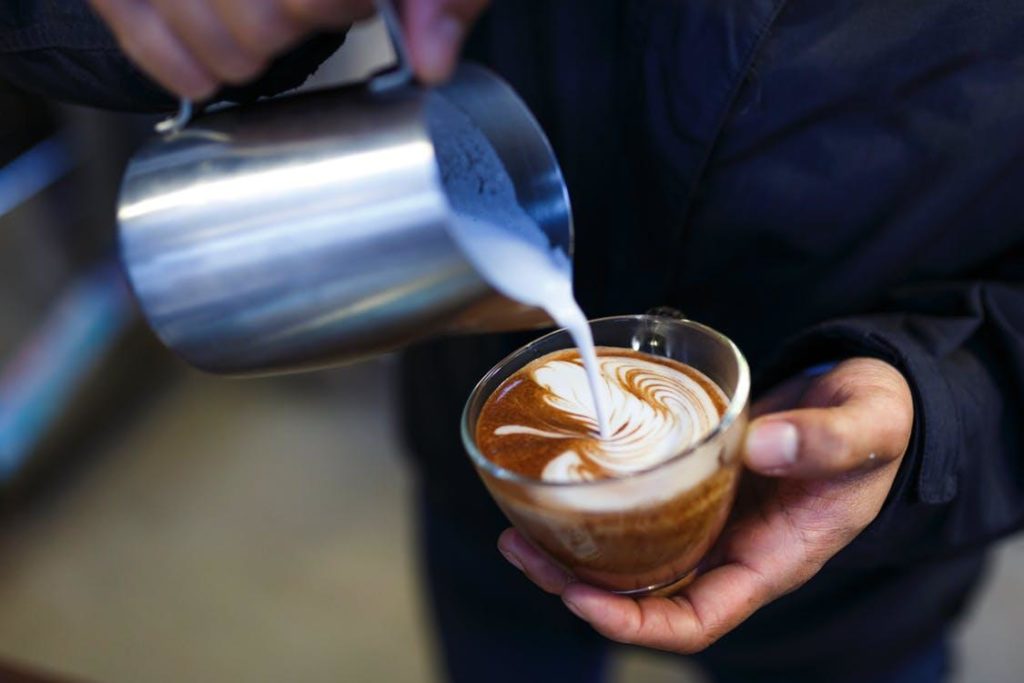
The operating plan will include details of how you will run your coffee shop. This will include costs, as well as specifics about things like opening times, food and drink production, prices, and more.
It will also allow you to spot any potential conflicts. For example, if you plan to serve 150 office workers between 7:30 a.m. and 9 a.m., can you do it with only two members of staff or would you be better off hiring another employee?
You can also use this section to explain any licenses or certifications you need to get before you open your shop, as well as how you will train employees.
We will open from 7:30 a.m. to 7.30 p.m. We will always have at least three staff members in place to take care of making coffee, process sales, and keep the coffee shop tidy.
We will buy our coffee wholesale from a supplier that specializes in high-quality coffee. This coffee will cost $40 per five-pound bag. We will keep enough coffee in stock to last for at least one week.
In terms of equipment, we will use a commercial grinder to grind beans before making each cup.
We will buy pastries and light meals from a local supplier who will also take care of the packaging. We will receive a daily delivery at 7 a.m., thirty minutes before the shop opens.
We will thoroughly clean up the shop after closing to ensure it is ready for the following day. We will build HACCP processes to stay compliant with food safety regulations. All members of staff will receive training so they know about these processes.
Management Team
In the management team section, you should include who the business owners are and who will manage your coffee shop. You should write about any experience or qualifications they have that will help make them successful.
If the owners won’t be managing the coffee shop, you should include details about who will take care of the day-to-day running of the business. In this section, include how much you will be paying each of the management team as well as how any profits will be shared amongst the owners.
The owner will also manage the coffee shop. The owner has over ten years’ experience working in coffee shops, including six years in various management positions. AI Coffee will also hire two full-time employees. These employees will have at least two years’ experience working in a coffee shop. We will pay each full-time employee $22,000 a year.
We will also hire four part-time employees with or without experience to work at weekends and provide cover during the week. We will pay these employees $10 an hour.
Financial Plan
The final section of the coffee shop business plan is the financial plan. Here you need to go into detail about how your business will be financially successful.
Include operating costs (this includes the cost of equipment), loan repayments, cash flow and expected revenue (in the first year, especially). Also, include a balance sheet analysis that shows how much revenue you need to take in to become a profitable coffee business.
In this section, we will explain our financial plan, including costs, expected sales, and profit. We will also include a balance sheet. We believe this plan accurately illustrates why AI Coffee will be financially successful.
ADD FINANCIALS
Wrapping Up
That’s all for our coffee shop business plan guide. We hope that this has equipped you with enough knowledge on how to start a coffee shop and will help you with your business planning.
To find out more about getting a business up and running, check out our guides to writing a business proposal in 2019 and writing a small business marketing plan.
Click To Tweet

2 thoughts on “ The Ultimate Coffee Shop Business Plan and Template ”
All Formats
Plan Templates
16+ coffee shop business plan templates.
Why should you even care about a business plan in the first place? If you have the money and passion for doing a business, isn’t that enough? Understand one thing: a sample business plan is not something you can walk away from. If you do not have a business plan, there will be nothing for you to fall back on when something goes wrong. A simple business plan is the blueprint of the business. If your coffee business must succeed, then a restaurant plan must be the number one document to create.
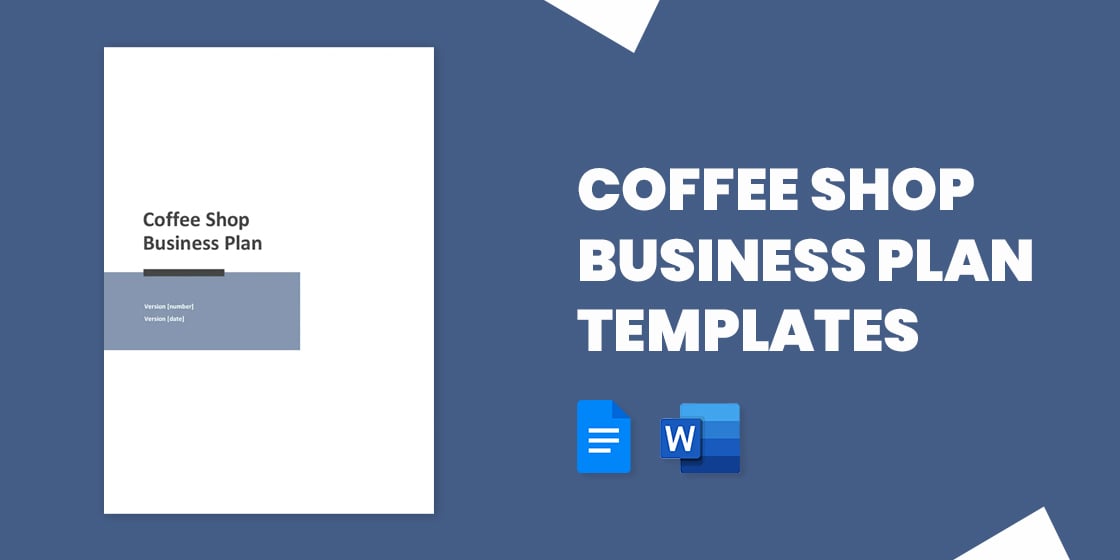
Construction Business Plan Template Bundle
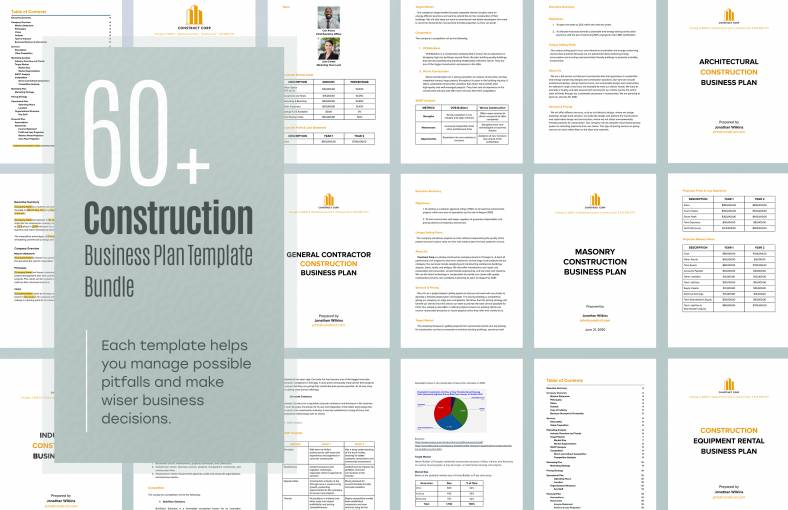
- Google Docs
Construction Business Continuity Plan Bundle
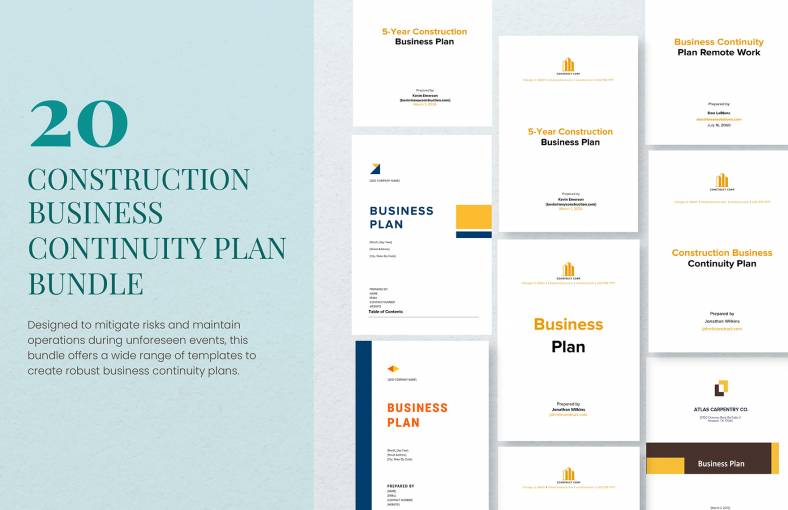
Construction Business Development Plan Template Bundle
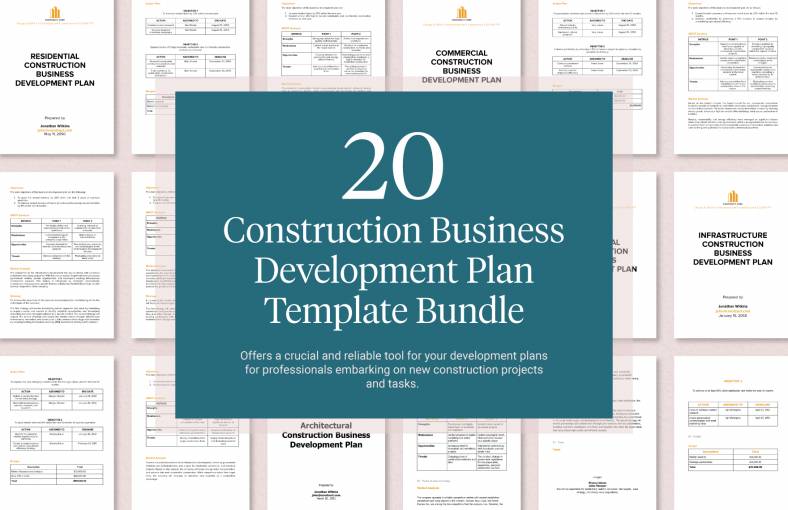
Coffee Bar Shop Business Plan Template
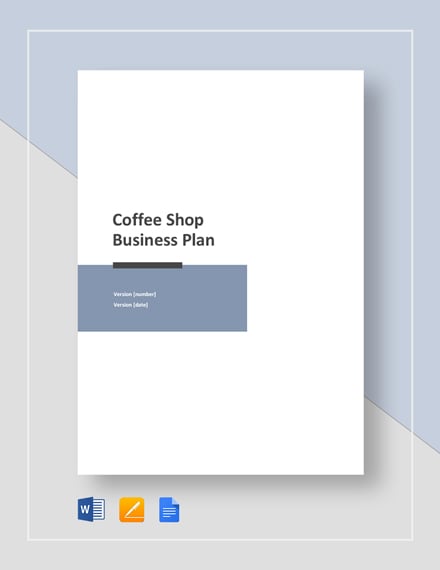
Coffeehouse Business Plan Template
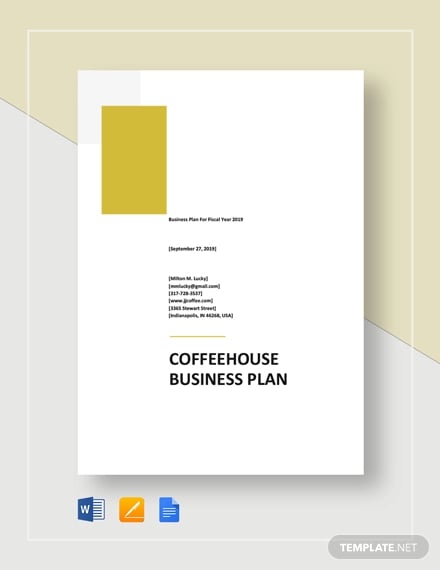
Coffee or Coffee Shop Production Marketing Plan Template
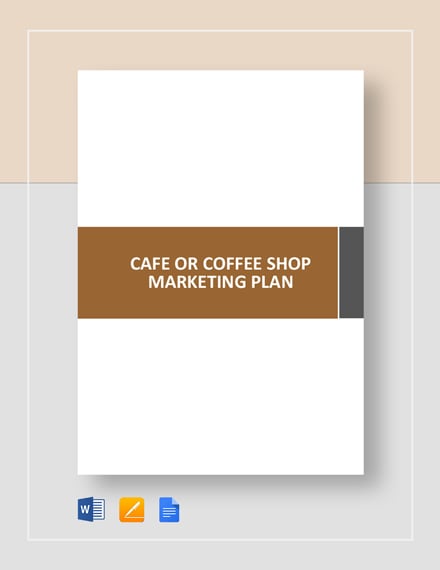
Opening a Coffee/Coffee Shop Sales Plan Template
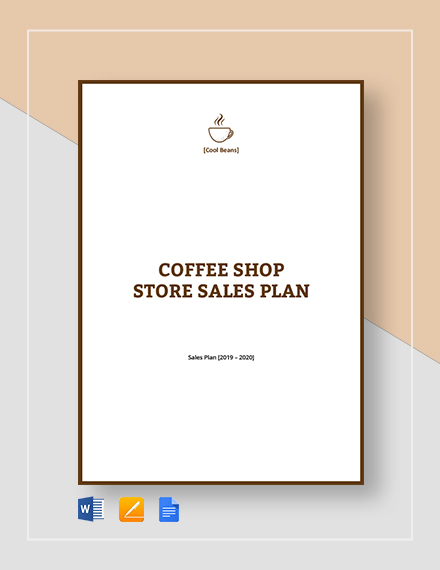
Coffee Shop Business Plan Template
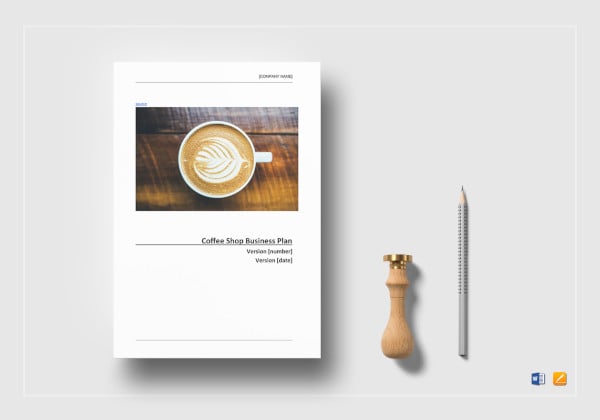
Starting a Coffee Business Plan with Executive Summary
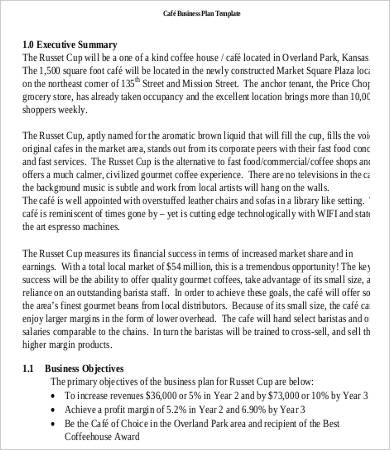
Startup Mobile Coffee Shop Business Plan with Front Page

Airport Coffee Shop Business Plan with Introduction

> Why do you need a Business Plan?
Swot analysis, financial planning, doughnut coffee & pastry shop small business plan.
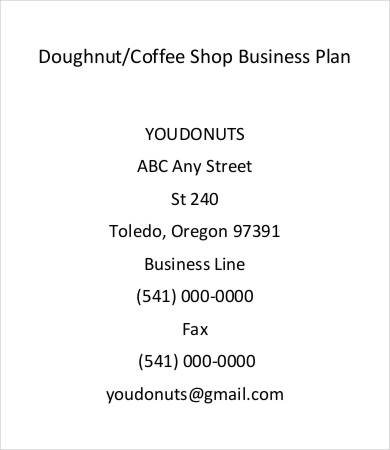
Crepes & Coffee Shop Management Business Plan Template
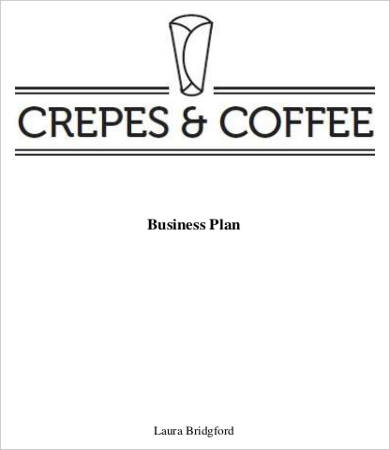
> Example Contents of a Business Plan
The objective of the business, target market, the marketing plan and strategy, new competitive advantage coffee shop business plan.
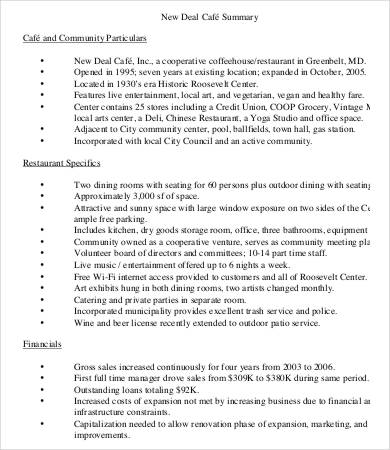
Business Financial Plan of Coffee Shop Restaurant in PDF
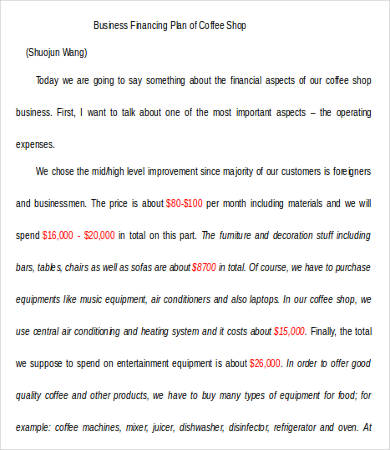
Coffee Shop Project Report Business Plan
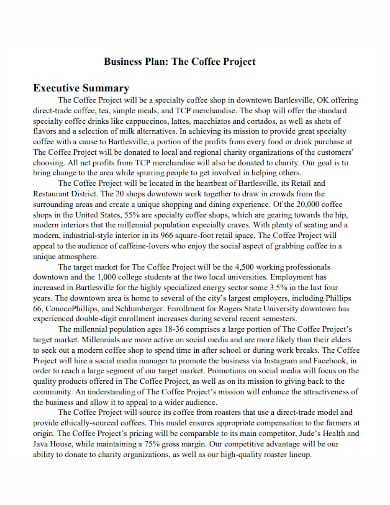
Philippines Coffee Shop Business Plan
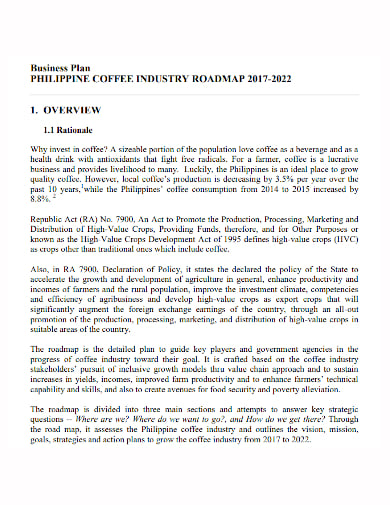
Espresso Stand Coffee Shop Business Plan with Description
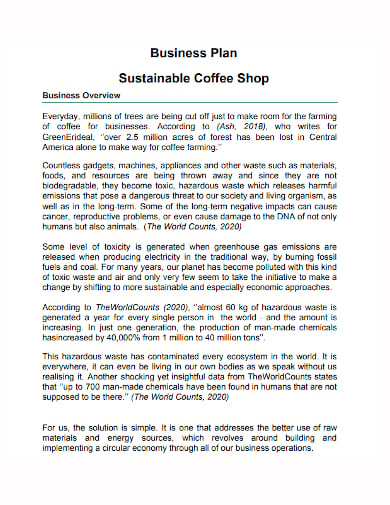
Coffee Shop Business Plan Presentations Income Statement
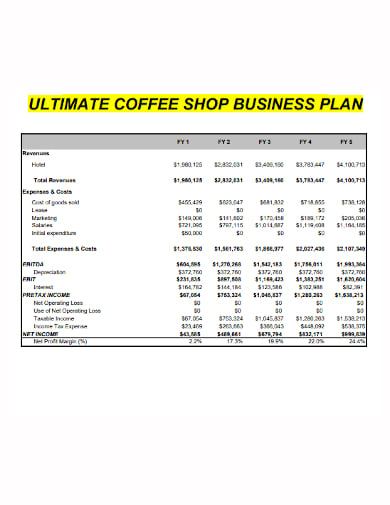
More in Plan Templates
Coffee Shop Advertisement Flyer Template
Coffee shop promotion flyer template, fantastic retro coffee shop flyer template, retro coffeeshop flyer template, coffee menu and coffee flyer template, national espresso day cartoon vector template, national espresso day drawing vector template, national espresso day clipart vector template, coffee youtube thumbnail cover template, coffee sale template.
- 7+ Financial Plan Templates
- 10+ Operational Plan Templates
- 9+ Training Plan Templates
- 5+ Shooting Schedule Template
- 11+ School Counselor Lesson Plan Templates in PDF | Word
- 9+ Interdisciplinary Lesson Plan Templates in PDF | MS Word
- 10+ Business Continuity Plan Templates in Google Docs | Ms Word | Pages | PDF
- 18+ Compensation Plan Templates in Google Docs | MS Word | Pages | PDF
- 10+ Executive Bonus Plan Templates in PDF
- 8+ Facility Management Plan Templates in PDF
- 10+ Diversity Recruitment Plan Templates in PDF | MS Word
- 11+ Audit Corrective Action Plan Templates in MS Word | Excel | PDF
- 9+ Recruitment Agency Marketing Plan Templates in PDF
- 10+ Recruitment Marketing Plan Templates in PDF | MS Word
- 10+ Student Recruitment Plan Templates in PDF | MS Word
File Formats
Word templates, google docs templates, excel templates, powerpoint templates, google sheets templates, google slides templates, pdf templates, publisher templates, psd templates, indesign templates, illustrator templates, pages templates, keynote templates, numbers templates, outlook templates.
- 866-684-7191
- Log into TimeForge

Brewing Success: Your 2024 Guide to Opening a Coffee Shop
- Published July 14, 2024
- Updated 3 days ago

Table of Contents
Before opening a new coffee shop, it’s crucial to conduct a thorough market analysis (brewing). This involves researching the local coffee landscape, understanding consumer preferences, and identifying emerging trends. By gaining insights into the target market, you can tailor your offerings to meet the unique needs and desires of your potential customers. Analyze factors such as the popularity of different coffee drinks, the demand for specialty or artisanal coffee, and the preferences of the local community. This information will help you develop a menu and overall business strategy that resonates with your target audience.
Location Selection: Factors to Consider
The location of your coffee shop can make or break its success. When selecting a site, consider factors such as foot traffic, rent costs, and proximity to competitors. Look for areas with high pedestrian activity, such as bustling commercial districts, office complexes, or residential neighborhoods. Evaluate the rent costs and ensure they align with your financial projections. Additionally, research the competition in the area and assess how your coffee shop can differentiate itself and attract customers.
Business Plan Essentials: Developing a Solid Plan
Crafting a comprehensive business plan is essential for the success of your coffee shop. This document should cover key aspects such as your financial projections, target market, and unique selling propositions. Outline your startup costs, ongoing expenses, and revenue projections to ensure the financial viability of your venture. Clearly define your target audience, their preferences, and how your coffee shop will cater to their needs. Highlight the unique features, products, or services that will set your business apart from the competition and attract customers.
Setting Up Your Coffee Shop
Design and layout: creating an inviting atmosphere.
The design and layout of your coffee shop play a crucial role in creating an inviting atmosphere that reflects your brand. Consider factors such as lighting, seating arrangements, and overall aesthetic to establish a welcoming ambiance. Incorporate elements that align with your brand identity and appeal to your target market. For example, if you aim to attract young professionals, you might opt for a modern, minimalist design with ample workspace and charging stations . On the other hand, if you want to create a cozy, neighborhood feel, you could incorporate warm lighting, comfortable seating, and rustic decor. Ensure that the layout is functional and efficient, allowing for smooth customer flow and easy navigation.
Equipment and Suppliers: Choosing the Right Gear
Investing in high-quality equipment and sourcing reliable suppliers is essential for delivering consistently excellent coffee. When selecting espresso machines and grinders, prioritize durability, performance, and ease of use. Research reputable brands and consult with industry experts to make informed decisions. Additionally, establish relationships with quality coffee bean suppliers who can provide a consistent supply of fresh, ethically sourced beans. Consider factors such as flavor profiles, roast levels, and sustainability practices when choosing your coffee beans. Building strong partnerships with reliable equipment and supply vendors will ensure the smooth operation of your coffee shop.
Legal and Regulatory Requirements: Navigating the Landscape
Before opening your coffee shop , it’s crucial to familiarize yourself with the legal and regulatory requirements in your area. Research and obtain the necessary permits, licenses, and certifications, such as a business license, food service permit, and liquor license (if applicable). Ensure that your coffee shop complies with local health codes and zoning regulations. Consult with legal professionals or industry associations to understand the specific requirements in your jurisdiction and develop a plan to meet them. Staying up-to-date with evolving regulations and maintaining compliance will help you avoid potential legal issues and fines.
Crafting Your Menu and Brand Identity
Developing a well-curated menu is essential for the success of your coffee shop. Start by selecting a range of high-quality coffee varieties, including both classic and specialty options. Consider offering a diverse selection of brewing methods, such as espresso-based drinks, pour-overs, and cold brew. Complement your coffee offerings with a thoughtful selection of specialty drinks, such as unique flavor combinations, seasonal beverages, and non-coffee options like tea and hot chocolate. To cater to your customers’ needs, include a variety of food items, such as pastries, sandwiches, and light bites. Ensure that your menu reflects your brand’s identity and appeals to your target market.
Branding Strategy: Creating a Memorable Brand Name, Logo, and Visual Identity
Your coffee shop’s brand identity is the foundation for how customers perceive and connect with your business. Invest time in developing a memorable brand name, a visually appealing logo, and a cohesive visual identity. Your brand name should be unique, easy to remember, and reflective of your coffee shop’s personality and values. The logo should be eye-catching and instantly recognizable, while the overall visual identity, including colors, typography, and imagery, should create a consistent and distinctive brand experience. Ensure that your branding resonates with your target audience and sets your coffee shop apart from the competition.
Pricing Strategy: Setting Competitive Prices while Ensuring Profitability
Establishing the right pricing strategy is crucial for the financial success of your coffee shop. Research the pricing of your competitors and consider factors such as your cost of goods, labor expenses, and overhead costs. Aim to strike a balance between offering competitive prices that attract customers and ensuring sufficient profit margins to sustain your business. Regularly review and adjust your pricing as needed to account for changes in the market, supply costs, and customer preferences. Implement strategies like menu engineering, bundle pricing, and seasonal adjustments to optimize your pricing and maintain profitability.
Marketing and Launch Strategies
Building anticipation and creating a buzz around your coffee shop’s opening is crucial for a successful launch. Leverage social media platforms to tease your upcoming opening, share sneak peeks of your space, and introduce your brand to potential customers. Engage with your local community by partnering with nearby businesses, hosting giveaways, or participating in community events. This will help you establish a strong local presence and generate excitement among your target audience even before your doors open.
Grand Opening Event: Planning a Successful Launch Event to Attract Customers
Your grand opening event is an opportunity to make a lasting impression and attract a large influx of customers. Plan a memorable and engaging event that showcases your coffee shop’s unique offerings and brand identity. Consider offering special promotions, free samples, or live music to create a festive atmosphere. Invite local influencers, media outlets, and community leaders to attend and help spread the word. Ensure that your event is well-organized, with ample staff to handle the expected crowds and provide exceptional customer service. A successful grand opening will not only generate initial buzz but also set the tone for your coffee shop’s ongoing success.
Digital Marketing Tactics: Utilizing SEO, Online Ads, and Influencer Partnerships to Boost Visibility
In today’s digital landscape, a robust online presence is essential for attracting and retaining customers. Implement search engine optimization (SEO) strategies to improve your coffee shop’s visibility in local search results. Invest in targeted online advertising campaigns on platforms like Google, Facebook, and Instagram to reach your target audience. Collaborate with local influencers, bloggers, or social media personalities who align with your brand and can help promote your coffee shop to their engaged followers. Leverage these digital marketing tactics to build brand awareness, drive website traffic, and convert potential customers into loyal patrons.
Operations and Growth
Your coffee shop’s success hinges on providing an exceptional customer experience. Invest in thorough training for your staff, equipping them with the knowledge and skills to deliver consistently excellent service. Emphasize the importance of friendly, attentive, and helpful interactions with customers. Train your baristas to craft high-quality coffee drinks and ensure that they understand the nuances of different brewing methods and flavor profiles. Encourage your staff to engage with customers, learn their preferences, and provide personalized recommendations. By fostering a customer-centric culture, you’ll create loyal patrons who keep coming back and spread positive word-of-mouth about your coffee shop.
Quality Control: Maintaining Consistency in Coffee Preparation and Food Offerings
Consistency is key when it comes to maintaining the quality of your coffee shop’s offerings. Implement standardized recipes, preparation methods, and quality control measures to ensure that every drink and food item meets your high standards. Train your baristas to follow precise measurements, techniques, and presentation guidelines to deliver a consistent experience. Regularly monitor and adjust your processes as needed to maintain quality. Conduct tastings and quality checks to identify areas for improvement. By consistently delivering high-quality coffee and food, you’ll build a reputation for excellence and foster customer loyalty.
Feedback and Adaptation: Listening to Customer Feedback and Adjusting Strategies for Continuous Improvement
Actively seeking and responding to customer feedback is essential for the ongoing success of your coffee shop. Encourage customers to share their thoughts, suggestions, and experiences through various channels, such as comment cards, online reviews, and social media. Analyze this feedback to identify areas for improvement and opportunities for growth. Implement changes based on customer preferences, such as introducing new menu items, adjusting hours of operation, or enhancing the physical space. By continuously adapting and improving based on customer input, you’ll demonstrate your commitment to their satisfaction and create a loyal customer base that advocates for your coffee shop.
This comprehensive guide covers the key steps aspiring coffee shop owners need to take to launch and grow their businesses in 2024. From conducting thorough market research to delivering exceptional customer experiences, this outline provides a roadmap for success in the competitive world of specialty coffee.
Maintaining a customer-centric focus, ensuring consistent quality, and continuously adapting based on feedback are key to long-term success. By prioritizing the customer experience and striving for continuous improvement, you’ll build a loyal following and position your coffee shop for growth in the years to come.
By following this comprehensive guide, aspiring coffee shop owners in 2024 can navigate the challenges of launching a new business and position themselves for success in the dynamic and ever-evolving specialty coffee industry.
You may also be interested in: 10 Ways to brew coffee in your restaurant | TimeForge
Tired of scheduling headaches and time tracking chaos? Experience for yourself streamlined scheduling, full compliance, and boost in employee engagement, with the TimeForge comprehensive workforce management solution. Join thousands of satisfied businesses and see the award-winning difference. Sign up now for a free demo tailored to your business!
Share this post
Want more tips.
Over 30,000 subscribers already benefit from our industry expertise each month.
Latest posts

Time Tracking: Friend or Foe? How to Ensure Fair Pay in a Tracked Workplace

5 Ways To Reduce Restaurant Labor Costs

Car Wash Worker Claims 70-Hour Weeks Without Overtime Pay in Class Action Lawsuit

Join our industry newsletter for tips & insights
Want to be a labor management pro? Sign up for our newsletter to receive thought leadership, labor management news, and timely insights from industry experts.
We’re committed to your privacy. TimeForge uses the information you provide to contact you about our relevant content, products, and services. You may unsubscribe from these communications at any time. For more information, see our Terms of Service and Privacy Policy .

- Hiring & Onboarding
- Human Resources
- Labor Compliance
- Employee Scheduling
- Time & Attendance
- Manager Log Book
- Team Communication
- Labor Analytics & Reporting
- Task Management
- Sales Forecasting
- Integrations Overview
- Point of Sale Integrations
- HR & Payroll Integrations
- Time Clocks
- Mobile Apps
- Harri Alternative
- HotSchedules Alternative
- Logile Alternative
- PeopleMatter Alternative
- UKG/Kronos Alternative
- Partner with us
- Free Tools & Templates
- Case Studies
- User Guides
- Job Description Templates
- Helpful Resources
- Submit a ticket →
- © TimeForge 2024
- Terms of Service
- Privacy Policy
Money blog: 'Serious implications' for payroll and salary payments after global IT outage
Welcome to the Money blog, your place for personal finance and consumer news and tips. Leave a comment with your thoughts below.
Friday 19 July 2024 15:04, UK
- New mortgage deal allows friends, parents and even aunties or uncles to help you get loan
- Thousands available to help with childcare costs this summer - if you earn below £100,000
- Top deposit saving tips as house prices rise again
- Wagamama launches its first ever loyalty scheme
- Jaguar to only make one combustion engine car by end of year
Essential reads
- Margarine v butter - which is healthier?
- Women in Business: 'I set up business with £200 and went on Dragons' Den - now it's worth £1.5m'
- Basically... What happens when you go bankrupt?
- Money Problem : 'A £16 phone bill debt has put a default on my credit record and now I can't get a mortgage - what can I do?'
Ask a question or make a comment
Workers who are paid weekly could be particularly impacted by today's IT outage after businesses said their software for payroll was affected.
Melanie Pizzey, chief executive officer and founder of the Global Payroll Association, said: "We’ve been contacted by numerous clients already today who have been unable to access their payroll software due to the Microsoft outage and others who have been urged to log out with immediate effect.
"Depending on the length of this outage, it could have very serious implications for businesses across the nation, particularly those who process payroll on a weekly basis.
"Furthermore, we could see a backlog with regard to processing payrolls for the coming month end which may delay employees from receiving their monthly wage.
"At best, it will require those managing payroll to work overtime to rectify the issue, but the good news is that it doesn’t seem to be a cyber attack."
Problems for banks and cash, too
Some banking services have also been affected, with Barclays bank reporting that its digital investing platform was also suffering disruptions.
A spokesman for the bank said: “All Barclays services are operating as normal at this time other than our digital investing platform Smart Investor, where customers are currently unable to manage their account in the app, Online Banking or over the phone.”
Other payments services, banks and financial institutions sought to reassure customers that their systems were running without disruption.
Link, which runs the UK’s network of ATM cash machines, said its network is "working normally but enhanced monitoring is in place as a precaution."
Follow the latest on the fallout of the IT problems in our dedicated live blog...
First-time buyers in the UK often face a mammoth task to own their own home, with the cost of the deposit the biggest barrier.
New figures from the Office for National Statistics reveal the average house price increased for a third month to £285,000 in May - in what will be good news for homeowners, but far from encouraging for those trying to get on the ladder.
Many prospective buyers face having to put forward a minimum 10% deposit to secure a decent mortgage.
But there's a postcode lottery when it comes to how much savers need to put aside for their first home.
The most recent data from Statista shows the average deposit for a first-time buyer has decreased across all regions in the UK over the past couple of years, going from £62,471 in 2022 to £53,414 in 2023.
Unsurprisingly, the average deposit in Greater London remains the highest in the UK at an eye-watering £108,848 - more than twice the UK average.
Meanwhile, in the North East, first-time buyers can expect to put down £29,740 on average - well below the national figure.
Property portal OnTheMarket says it's not all bad for first-time buyers, with the government's mortgage guarantee scheme offering 5% deposit mortgages from participating lenders, so long as they pass the usual credit and income checks.
It also has these five tips for anyone trying to save for a deposit:
Set clear savings goals
Work out how much you need to save for your deposit and establish a realistic timeline for reaching this goal. In order to achieve it, break down the amount into manageable monthly, or even weekly, savings targets.
Create a budget and stick to it
Aim to track your income and expenses to identify areas where you could cut back, or even allocate more money to your savings goal. Consider reducing spending where possible - but make sure to find a balance that works for you.
Research savings accounts
Ensure that you do enough research so you can sign up for an account that is best suited for you and your saving needs.
For first-time buyers, savings accounts with high interest rates are great to look out for.
Explore government schemes
The Lifetime ISA (LISA) scheme helps you save money towards a property deposit and get more out of your savings. With a LISA, you can pay up to £4,000 per year into your account and the government will put in 25% to your savings, while your savings also accrue interest.
There are other schemes too, such as the First Homes scheme or shared ownership, which may be more suited to your needs.
Gifted money
If you are fortunate enough to have family members available to help you out with saving for a house deposit, you will be in a better position to receive good interest rates on your mortgage and benefit from lower monthly payments.
Two Premier League football teams say supporters could have issues buying tickets after today's global IT chaos.
Brentford FC has apologised to fans for ticketing issues caused by today's IT issues.
It said on X: "Due to an issue with third-party software affecting businesses globally, Brentford FC's Ticketmaster platform is currently experiencing technical difficulties.
" Supporters looking to purchase tickets are advised not to join the online queue.
"In the meantime, for any ticket-related questions, please call the ticket office on 0333 005 8521.
"We apologise for any inconvenience this may cause and are working to restore our systems as quickly as possible."
Burnley, another Premier League side, also posted on X to say it had been affected by technical issues with Ticketmaster.
No free school meals and increased childcare costs mean the summer holidays can be financially precarious for some families.
But if you earn less than £100,000, there is help out there you should be aware of.
30 free hours
Parents with children aged between nine months and four years old are eligible for up to 30 hours of funded childcare a week.
Universal Credit
You can claim up to £1,739 per month for childcare costs if you have two or more children, or up to £1,014 per month for one child, while working and on Universal Credit.
If you're not on Universal Credit, it is worth checking if you could qualify for the "child element" of the benefits, worth £288 per child per month (up to two children) - but this is means tested.
Tax-Free Childcare scheme
For those who do not claim Universal Credit or Tax Credits, it may be advisable to look into this top-up for working parents.
It provides an additional £2 for every £8 you spend on childcare up to £500 every three months, or £1,000 for children with some disabilities.
This applies to people with children aged 11 or younger (or 16 and below if they have a disability) who pay for childcare.
You must be employed or self-employed and earn at least the equivalent of 16 hours a week on minimum wage and less than £100,000 per annum.
By Sarah Taaffe-Maguire , business reporter
With the London Stock Exchange Group impacted by the global IT outage, the usual market data is not available to bring a comprehensive update to readers.
But the financial market reaction is clear: share prices are down across the board as the impact of system failures rips through businesses across the world.
Major stock market indexes - which give a picture of company performances on a particular stock exchange - are down as airlines, train companies, banks, tech firms and media businesses are hit.
Across Europe, the French CAC 40, German DAX, Spanish IBEX, and Swiss SMI are all down. All of the British FTSE (Financial Times Stock Exchange) indexes are down more than 0.5%.
As for the companies reported to be at the heart of the outage, their value has understandably dropped.
The company which is understood to have launched an anti-virus update which sparked the outage - CrowdStrike - saw its share price fall 12.55%.
Microsoft, whose cloud computing system Azure is also reported to be a source of global glitches, has seen its share price drop 1.9%.
At present, the usual regulatory news service from the London Stock Exchange where companies publish financial results and boardroom movements are not available.
By Ian King, Sky News business presenter
The London Stock Exchange is among the businesses that have been affected by the global outage of IT systems around the world.
Sky News has been told trading on the London Stock Exchange continues to operate as normal and has not suffered an outage.
However, a statement posted on the exchange’s website early this morning said that a technical issue was being investigated with the publication of RNS – the exchange’s Regulatory News Service – announcements.
It said: "RNS news service is currently experiencing a 3rd party global technical issue, preventing news from being published on www.londonstockexchange.com . Technical teams are working to restore the service. Other services across the Group, including London Stock Exchange, continue to operate as normal."
It was also reported that Workspace, the news and data platform owned by the exchange’s parent LSEG, had also suffered an outage that has affected user access worldwide. The outage first struck when Asian markets were open overnight and prevented news from being published on the platform.
When trading began at 0800, the exchange’s website was still showing prices from the close on Thursday evening and continues to do so.
The FTSE-100 opened 50 points lower – around 0.62% - at the open but no prices were available on the exchange’s website.
Other major European stock indices have also opened to the downside this morning, with the DAX in Germany down by 0.55% half an hour into the session, while the CAC-40 in France and the MIB in Italy down by 0.45% apiece.
Follow the latest in our dedicated live blog on the IT outages...
Superdry will become "so much more relevant" and cool again, the clothing chain's founder has said.
Julian Dunkerton told The Telegraph that the fashion retailer, whose presence on the London Stock Exchange came to an end this week after 15 years, will undergo a "reinvention" in the next few months.
He said he was determined to depart from the store's "dad image" and target more Gen Z shoppers after posting losses of £25m.
The millionaire boss, who established Superdry in 2003, told newspaper: "I genuinely think this is one of the turnaround moments for any brand.
"We grew so quickly and we were so popular that we were bound to be knocked off our perch a bit. There was only so much of that certain stuff we could sell."
As part of the reinvention, Superdry has slashed its clothing range from 4,000 items a season to 1,600.
It will also move away from the persistence of Japanese influences in some designs.
Mr Dunkerton said his wife Jade Holland Cooper, who is a fashion designer, has also been drafted in to help him with photography and styling.
"It's lucky being married to a woman who has got skills which I patently haven't got," he added.
It can be hard to balance the demands of eating well without spending a lot. In this series every Friday, we examine everyday supermarket products to help you make informed decisions.
Sunna Van Kampen , founder of Tonic Health, who went viral on social media for reviewing food in the search of healthier choices, and dietician Nichola Ludlam-Raine from nicsnutrition.com offer their expertise.
This week they're looking at butter v margarine - and, in an illustration that this one might be hard to answer definitively, the expert dietician has a different take to Sunna...
Sunna's view - The right choice
Butter has been a staple in kitchens for centuries.
"Made from churned cream, it boasts a natural profile that's hard to beat [compared with margarine]," Sunna says.
Given it's a traditional food that is made simply by churning milk, butter is also a minimally processed food.
Here's where, according to Sunna, butter is good for you...
- Nutrient-rich - Butter contains essential vitamins like A, D, E, and K, which are fat-soluble and crucial for various body functions.
- No additives - Unlike margarine, butter is free from artificial additives, preservatives, making it a cleaner choice.
- Fats - Butter is rich in saturated fats, which Sunna feels have been unfairly demonised in the past. He points to a recent study that tracked 4,150 Swedish 60-year-olds for more than 16 years and found those with the highest intakes of dairy actually had a lower risk of cardiovascular disease than those with low intakes. Sunna says the problems arise when the fats are combined with sugars and low-fibre flours, such as in pies and biscuits. But many dieticians disagree...
Nichola's view - Moderation is key
"There is an overwhelming amount of evidence to support the replacement of saturated fat with unsaturated fat when it comes to health and preventing cardiovascular disease.
"Unsaturated is fat is predominately found in oily fish as well as plants – from olive oil to nuts, seeds, and avocados too."
Nichola does seems to agree some saturated fats are better than others - but she doesn't include butter in this category.
"The saturated fat found in dairy (including milk, cheese and yoghurt) does seem to act differently - and are better choices for heart health - in the body in comparison with the saturated fat found in butter and foods made from butter including biscuits, pies and pastries.
"This is down to differences on a molecular level regarding how the fat is 'bound' or encapsulated."
Nichola goes on: "On the whole I wouldn't advise anyone have large amounts of butter, or coconut oil for that matter (another product high in saturated fat), especially as most of the time it may be accompanied with refined carbohydrates, such as white bread.
"Moderation is key. For butter lovers, though, my advice is simple – use conservatively (on wholemeal bread!)."
Cost - More expensive
A 250g block of unsalted butter costs around £2.50.
It's typically between £9.80-£10.40/kg at major supermarkets.
Sunna's view - Too processed
Margarine was invented in 1869 France in response to Napoleon III's call for a cheap alternative to butter for French workers.
"Today, it's made from vegetable oils and often has added ingredients that makes this an ultra-processed food," Sunna says.
"Often marketed as 'healthy', they typically combine different seed oils that undergo a process to solidify the oil.
"It's this process that used to create 'trans-fats' which are now known to be as harmful.
"Now, margarines today don't contain trans fats - but they do contain seed oils which are highly processed and also contain emulsifiers to improve their spreadability and colourings to mimic the appearance of butter."
Nichola's view - Often recommended if made from olive or rapeseed oil
"Spreads in the UK became healthier in the 1980s when the processes of hydrogenation was stopped, thus preventing the formation of trans fats.
"I often recommend spreads made with olive oil or rapeseed oil to help increase the proportion of preferred fats in the diet, despite the small amounts of additives, which moderation are nothing to worry about in this context."
Cost - Cheaper
Margarine is typically slightly cheaper than butter, with prices at around £2.50 per 450g tub, ranging from £5.56-£9.38/kg.
An alternative (that's also vegan)
"One thing I always recommend for our vegan friends is do as the Italians do - olive oil on toast is a fantastic option," Sunna recommends.
"It's the healthiest oil going and tastes amazing once you get used to the drizzle instead of spread."
It's rich in monounsaturated fats, which are great for heart health, and contains polyphenols and antioxidants that help fight inflammation.
Olive oil is a good source of vitamins E and K, which support skin health and bone strength.
However, it is more pricey - at around £5 per 250ml bottle, but Sunna says "the health benefits make it worth every penny".
The expert dietician is clear that butter should only be eaten in moderation despite the argument put forward by Sunna about various health benefits.
And she sometimes recommends margarine as long as it is made from olive or rapeseed oils - but Sunna urges you to consider the additives.
Read more from this series...
Jaguar will only have one combustion engine car in production by the end of the year, according to reports.
The luxury brand has previously announced that it would switch to making electric-only models by 2025.
The company stopped making its XE, XF and F-Type cars at Castle Bromwich in May.
The Telegraph reported the hybrid E-Pace in Austria and the electric I-Pace will stop being produced by the end of December.
The move will only leave the petrol, diesel and hybrid F-Pace SUV in production at Solihull, it added.
Adrian Mardell, chief executive of parent company Jaguar Land Rover, said the other cars would be "eliminated" at a recent investor day.
Jaguar Land Rover (JLR) said in a statement: "As JLR transitions to its electric future, current Jaguar production at our Castle Bromwich site came to an end in May 2024 while I-PACE and E-PACE in partnership with Magna Steyr in Graz, Austria, will come to an end in December 2024.
"Jaguar will begin an exciting new era as a pure-electric luxury brand with vehicle production commencing at our Solihull facility from 2025."
Every Friday we take an overview of the mortgage market, speaking to those in the industry before getting a round-up of the best rates courtesy of the independent experts at Moneyfactscompare.co.uk .
We could have started this week's look at mortgages with the changing forecasts for interest rate cuts - and we will get to that, but another interesting development in the market came from Gen H.
The lender announced it would start allowing friends to act as income boosters for mortgages up to 80% loan-to-value, while extending immediate family to include nieces and nephews up to 95% LTV.
It's aimed at helping people struggling to get on the housing ladder.
Stephen Perkins, MD at Yellow Brick Mortgages, welcomed the innovation - but there was a note of caution.
"The friends or family members in question need to go in eyes wide open," he told Newspage. "Having your income used to assist a friend's mortgage could have a potential impact on your own credit file and personal borrowing potential in the future."
At the top we alluded to changing interest rate forecasts - this followed higher-than-expected services inflation for June, as revealed by the ONS on Wednesday.
Prior to the data dump, the chances of a base rate cut at the Bank of England's next six-weekly meeting on 1 August was 50/50, according to markets.
This fell back to 64/36 - in favour of a hold - but as of Thursday afternoon, following new data on wage growth falling back, the market forecast was 56/44 in favour of a hold at 5.25%.
For now, the average rates being offered on the high street (bear in mind many people will be able to get better deals than this) are...
We asked Moneyfacts to hone in on house purchase rates this week (as opposed to home movers or first-time buyers).
Spokesperson Caitlyn Eastell said: " House purchase customers will find the lowest two-year fixed rate for those at 60% loan-to-value this week comes from Barclays Mortgage, priced at 4.52%.
"Those looking to fix for longer will find the lowest five-year fixed house purchase deal at 60% loan-to-value also comes from Barclays Mortgage. The deal is priced at 4.09%."
Moneyfacts also looks at what it calls "best buys" - which considers not just the rate, but other costs and incentives. These are their top picks this week...
Be the first to get Breaking News
Install the Sky News app for free


IMAGES
COMMENTS
Free Download: Sample Coffee Shop Business Plan. Wake up and smell the business potential! In the US, 72% of adults reported drinking coffee in 2022. Globally, coffee consumption rose to 175.6 million bags of coffee from 2021 to 2022 - that's up 4.2%. In such a large, steadily growing industry, there are many possibilities for you to find a ...
Learn how to write a successful coffee shop business plan with this comprehensive guide and free template. Find out what to include in each section, from concept and market analysis to financial and operational plans.
Executive summary. In the opening to your Executive Summary you should give the basics. Explain how the idea was conceived, the location at which the coffee shop will be located, and introduce the owner (s). A business plan is about building a narrative so think of this as the beginning of your coffee shop's story.
Download a customizable, free coffee shop business plan template for Word or Pages. Learn how to start a coffee shop, get funding, find a location, source coffee, hire staff, and market your business.
Download Cover Page Business Plan Templates Free. 2. Executive Summary. The Coffee Shoppe will be a business service provider based in Miami, Florida. Founded by Mrs. Nancy Harrigan. The Coffee Shoppe will offer a menu of services which include coffee, lattes, capacinos, expressos, deli sandwiches and baked goods.
Also, two pages are more than enough for writing a capturing executive summary. 3. Conduct a competitive and market analysis. Build a strong foundation for your coffee business by diving deep into the market research of the coffee industry, competitors, target audience, market trends, and your attainable target market.
A coffee shop business plan should include sections on executive summary, company description, market analysis, target audience, menu and pricing, marketing and promotional strategies, location and facilities, staffing and management, and financial projections.
Download this free coffee shop business plan template, with pre-filled examples, to create your own plan. Download Now Or plan with professional support in LivePlan. Save 50% today . Available formats: What you get with this template. A complete business plan. Text and financials are already filled out and ready for you to update. ...
Explore a real-world coffee shop business plan example and download a free template with this information to start writing your own business plan. Don't bother with copy and paste. Get this complete sample business plan as a free text document. Download for free. Business Planning.
A coffee shop business plan is a formal document that outlines the goals, strategies, and tactics for launching and operating a coffee shop. It describes in detail how the business will operate, including the types of products and services provided, the target market, the proposed location, and the projected financials.
To start a business proposal for a coffee shop, use a coffee shop business plan sample and make sure you include the key sections: an executive summary, business overview, management and staff, market analysis, marketing and publicity, operations plan, and financial forecast and expenses. Also, make sure you do enough research before you start ...
For those seeking a tailored approach, we offer a downloadable 'Coffee Shop Business Plan PDF'. This document is crucial for entrepreneurs committed to developing a compelling and effective strategy for starting or growing their coffee shop business. The 'AI Business Plan Generator' acts as a comprehensive guide, providing in-depth insights ...
A coffee shop business plan is a plan to start and/or grow your business. Among other things, it includes your company overview, allows you to conduct a market analysis to identify your target market, includes a sample menu, presents your marketing plan and pricing strategy to attract your local customer base, details your sales forecasts, and provides the income statement, balance sheet and ...
This free business plan template is designed to help you create a comprehensive plan for your coffee shop that will guide you through the process of starting and growing your business. Starting a coffee shop can be an exciting and rewarding venture, but it can also be challenging. With so many details to consider, it's easy to get overwhelmed.
Executive Summary. A concise introduction to your coffee shop's concept in the form of an executive summary is the first section of a business plan. The executive summary introduces key elements of your business plan, such as an overview of the budget, the business's mission, market, and core values, and a coherent vision for your product ...
Learn the steps and benefits of creating a comprehensive and strategic document for your coffee shop venture. Find tips on naming, market research, financial planning, operations and more.
Learn how to write a coffee shop business plan with a template and a sample. Find out what to include in each section, from market analysis to financial projections.
PDF. Size: 333 KB. Download. Writing a business plan is not easy. And it is not a one-day job. You will have to invest time, resources, money, and energy to create a new business plan in word. Make sure the plan doesn't just read well on paper; it should also be as practical as possible. These templates are free to use.
The business plan provides them with a complete description of your strategy. Download the free Coffee Shop Business Plan Template to organize your vision and ensure that nothing is overlooked. For a guide to writing a business plan specifically for a coffee shop, learn from this resource: How to Write a Coffee Shop Business Plan. Related ...
Evaluate the rent costs and ensure they align with your financial projections. Additionally, research the competition in the area and assess how your coffee shop can differentiate itself and attract customers. Business Plan Essentials: Developing a Solid Plan. Crafting a comprehensive business plan is essential for the success of your coffee shop.
Sorry Babushka Coffee Shop, Elektrostal: See unbiased reviews of Sorry Babushka Coffee Shop, one of 39 Elektrostal restaurants listed on Tripadvisor.
Coffee Shop Usy Teodora Glagoleva, Elektrostal: See 31 unbiased reviews of Coffee Shop Usy Teodora Glagoleva, rated 4.0 of 5 on Tripadvisor and ranked #8 of 30 restaurants in Elektrostal.
Elektrostal Hostels Elektrostal Spa Resorts Elektrostal Family Hotels Elektrostal Business Hotels. By Hotel Class. 3-Star Hotels in Elektrostal. ... Plan Your Trip to Elektrostal: Best of Elektrostal Tourism. By crimso76. 513. Elektrostal, Russia ... Coffee Shop Usy Teodora Glagoleva. 31 $ Teremok. 16 $ • Russian. Amsterdam Moments. 23
By Sarah Taaffe-Maguire, business reporter. While unexpectedly high inflation data is bad news for anyone borrowing money, particularly mortgage holders, it's good for the value of the pound.
Gluten Free Options. Good for. Families with children. Large groups. Business meetings. Romantic. Show more. Open now. ... Coffee Shop Usy Teodora Glagoleva. 31 $ Fabrika Obedov. 33. Cafe, European, Russian, Soups $ Teremok. 16. Russian $ ... Elektrostal Hostels Elektrostal Business Hotels Elektrostal Spa Resorts Elektrostal Family Hotels. By ...